Thogme Zangpo’s Instructions -
The 37 Practices of All Bodhisattvas
The Only Path to Buddhahood
To help countless sentient beings, as boundless as the sky, liberating them from the cycle of suffering, we must first generate the supreme bodhicitta and transform our mindset. The teachings we shall explore today delineate the path that all Buddhas and Bodhisattvas must tread - the Bodhisattva Path. Gyalse Thogme Zangpo, the author, distilled the practices of all Bodhisattvas into thirty-seven succinct verses, known as the 'Thirty-Seven Verses on the Practice of Bodhisattvas.' This profound wisdom will be the focus of our study today.
What kind of text is this? Generally speaking, the Buddhas of the three times — past, present, and future — all the Buddhas of the past, all the present Buddhas existing in various realms, and all the Buddhas yet to come in the future; they have only one path to follow and practice — the sublime Bodhisattva Path. "The Thirty-Seven Practices of Bodhisattvas" outlines this sole path to Buddhahood. Without following this path, the perfect realization of Buddhahood is unattainable. For the Bodhisattvas presently on the path (the stages of the bhumis), the essence of their practices is encapsulated within this text. In summary, samsara and nirvana, as well as the present and ultimate peace, happiness, and all virtuous qualities, originate from this path. "The Thirty-Seven Practices of Bodhisattvas" is precisely such a text.
When studying, it's important not just to memorize the words but to truly grasp the underlying meaning and keep it close to our hearts. Sometimes we may be confused by words, but if we truly understand their inner meaning, we'll be able to comprehend the Bodhisattva's way of adopting and rejecting and gain insight into what actions to take and what to avoid. With this, we can unlock the essence of the thirty-seven verses and put the teachings of the Bodhisattva path into practice.
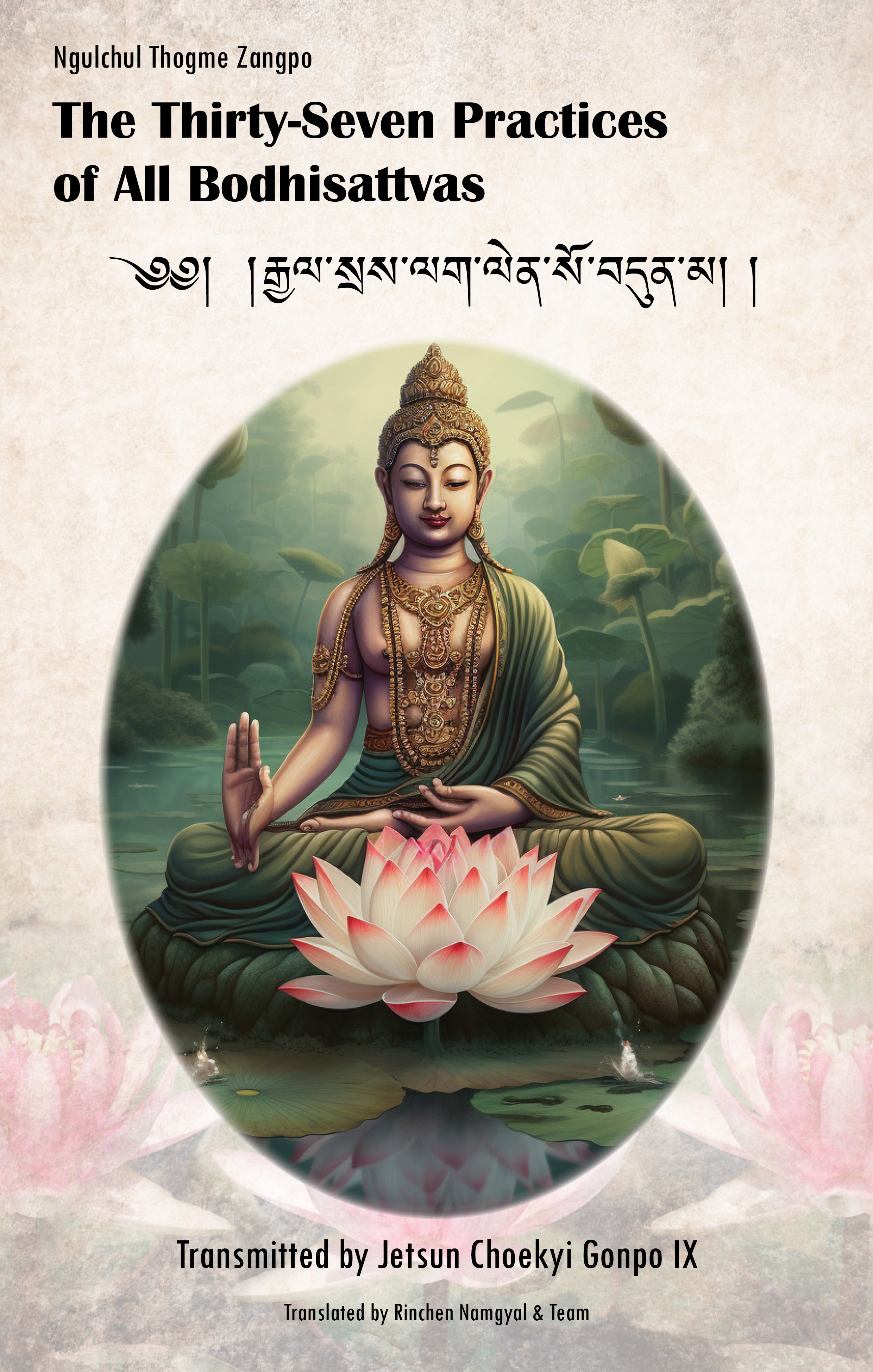
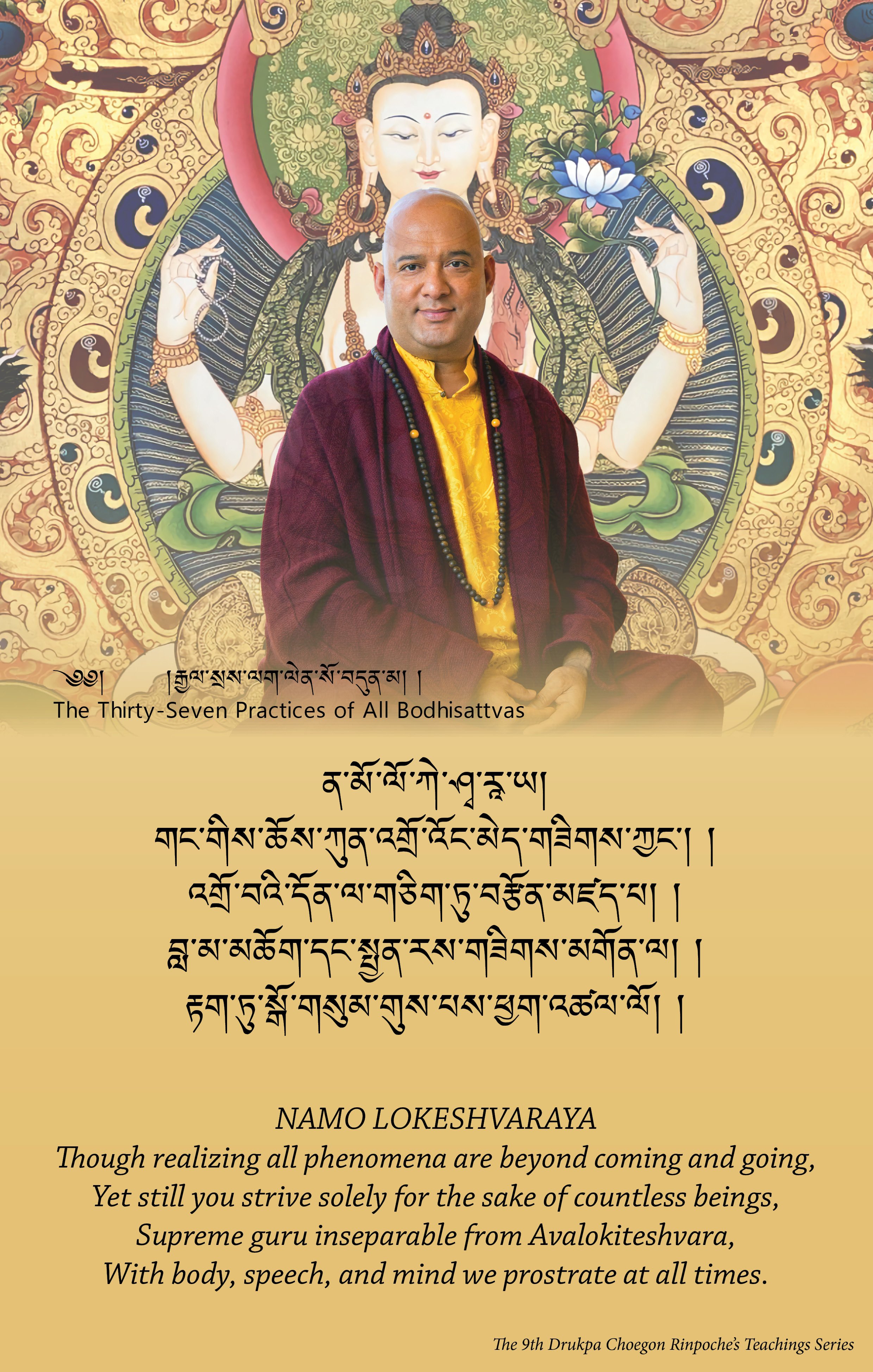

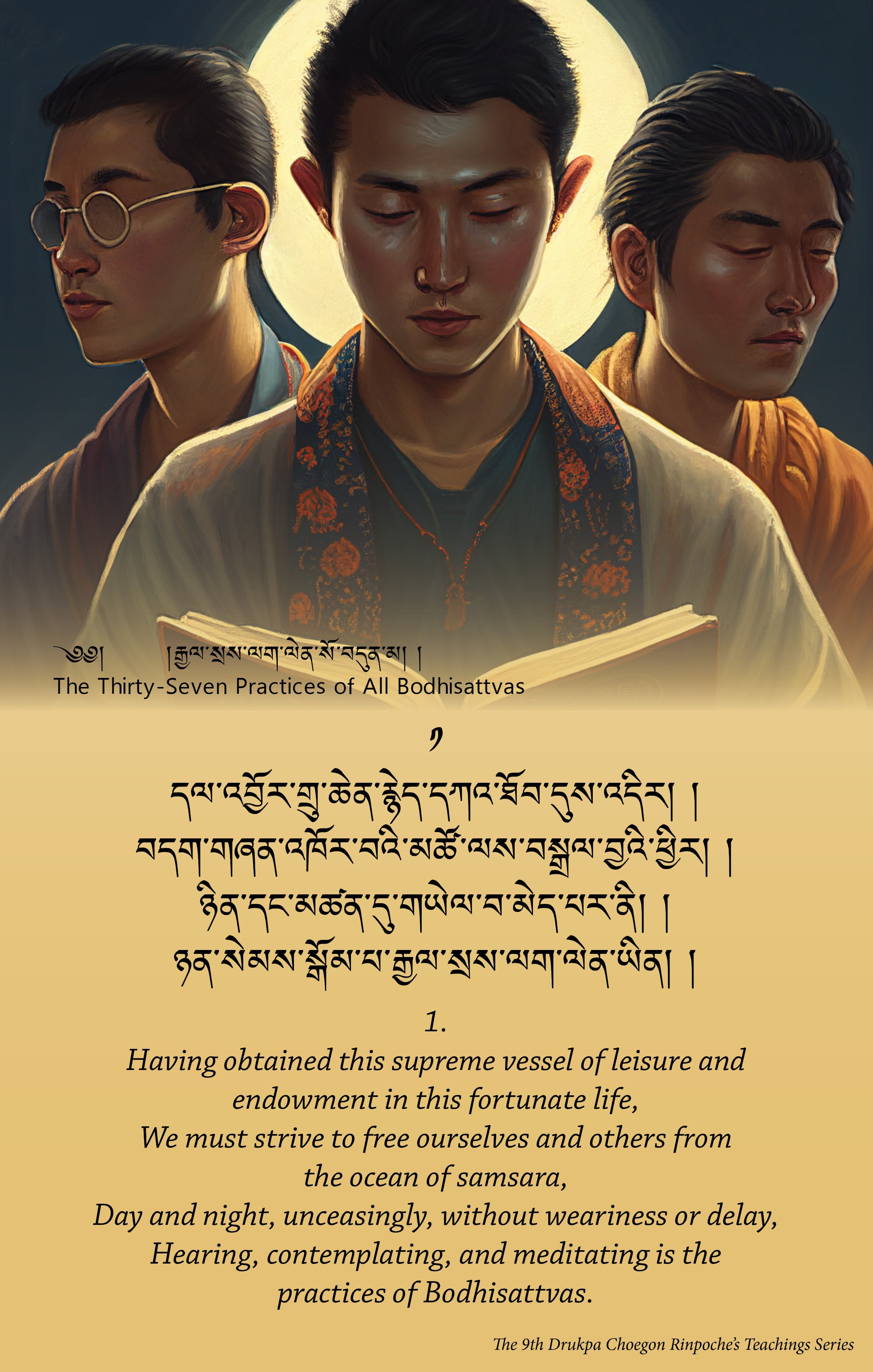
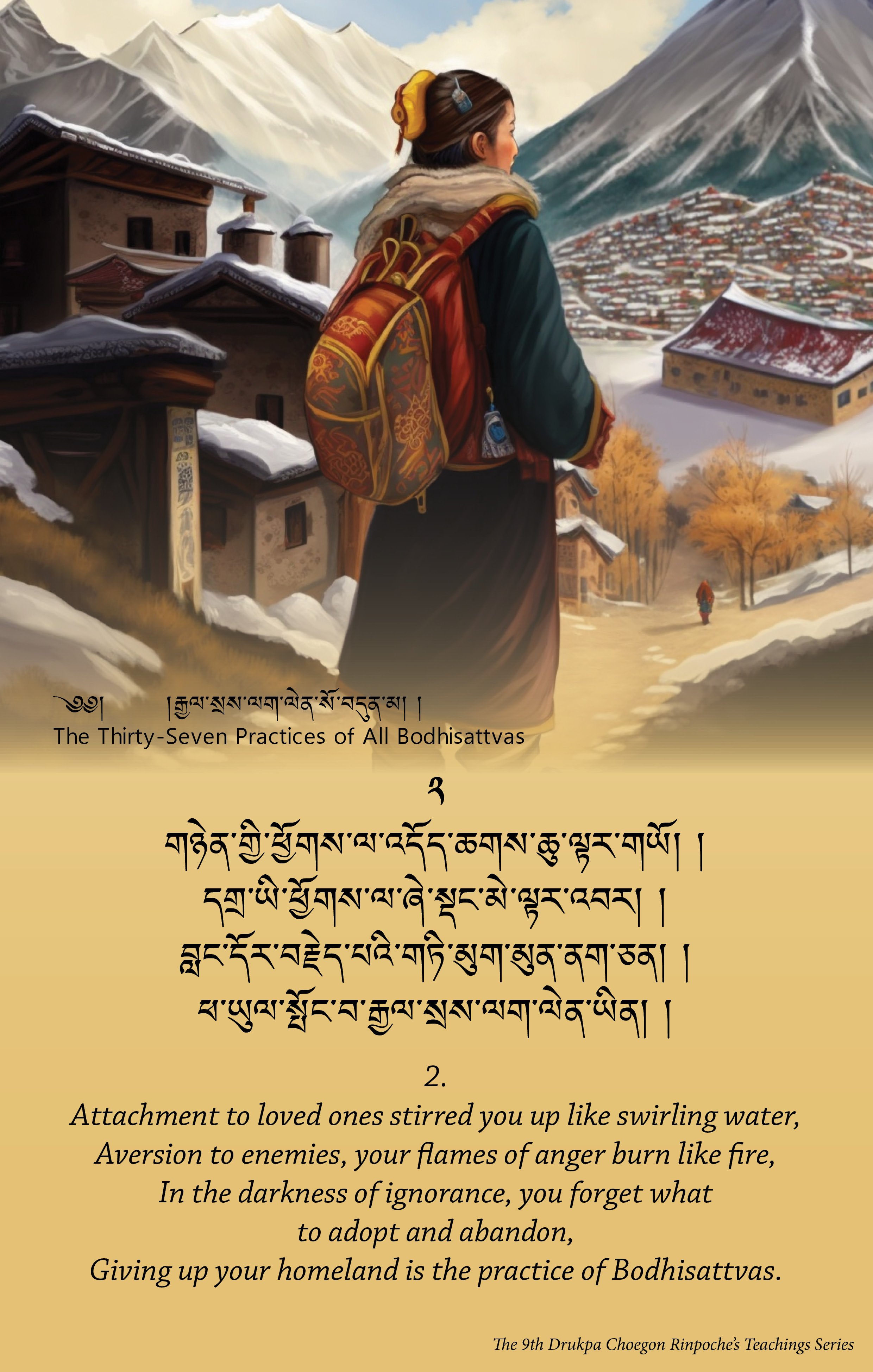
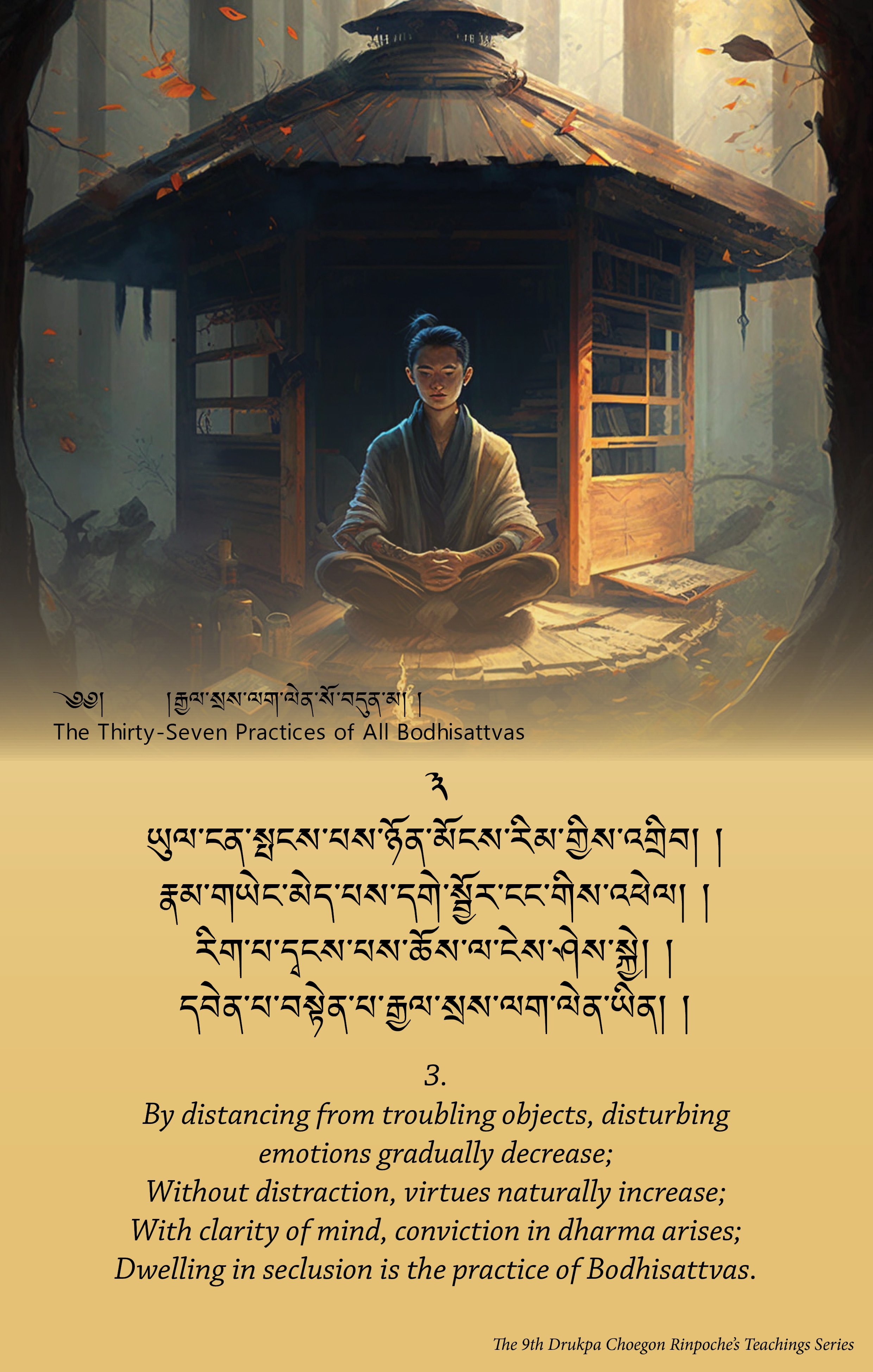
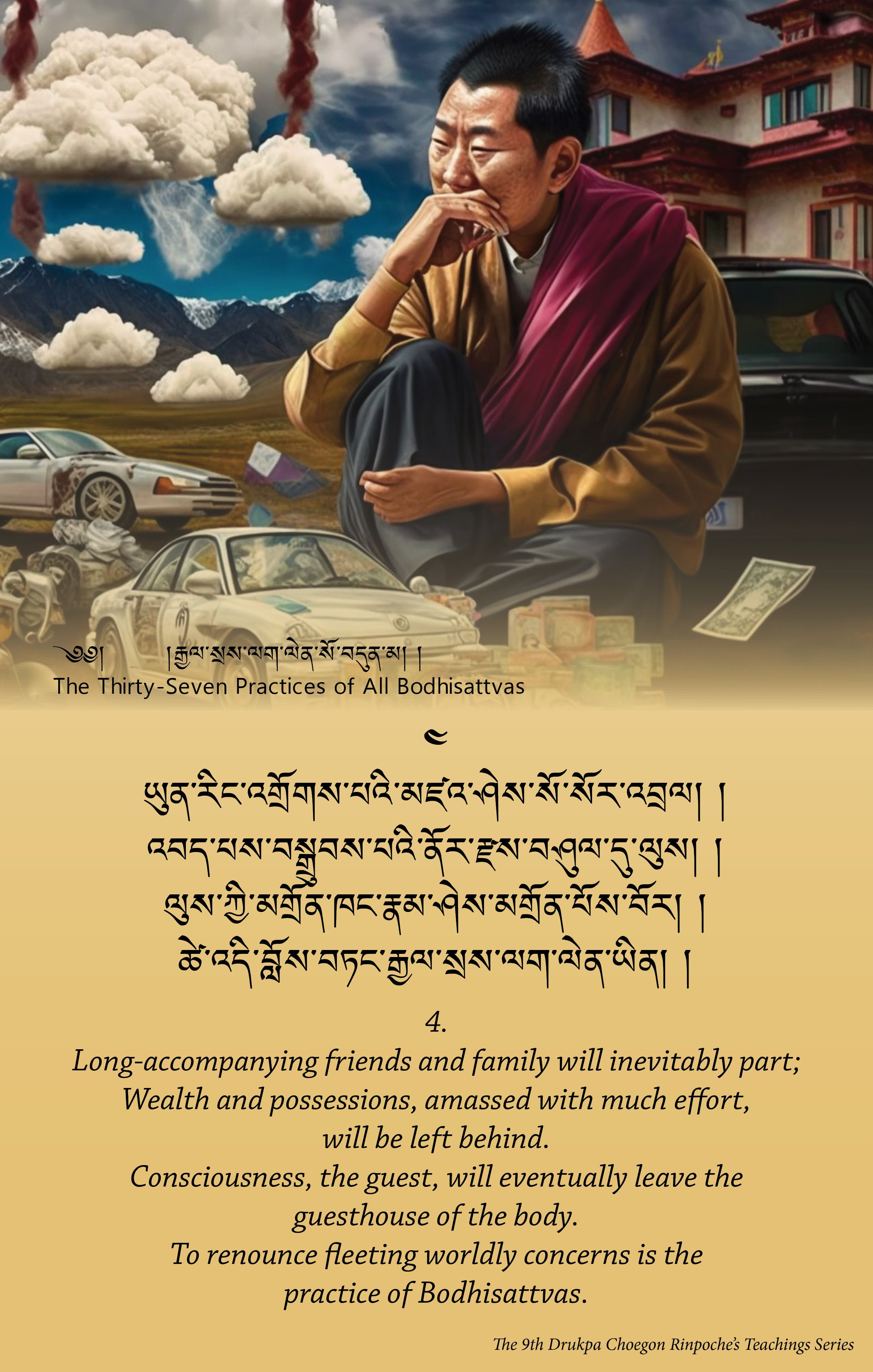
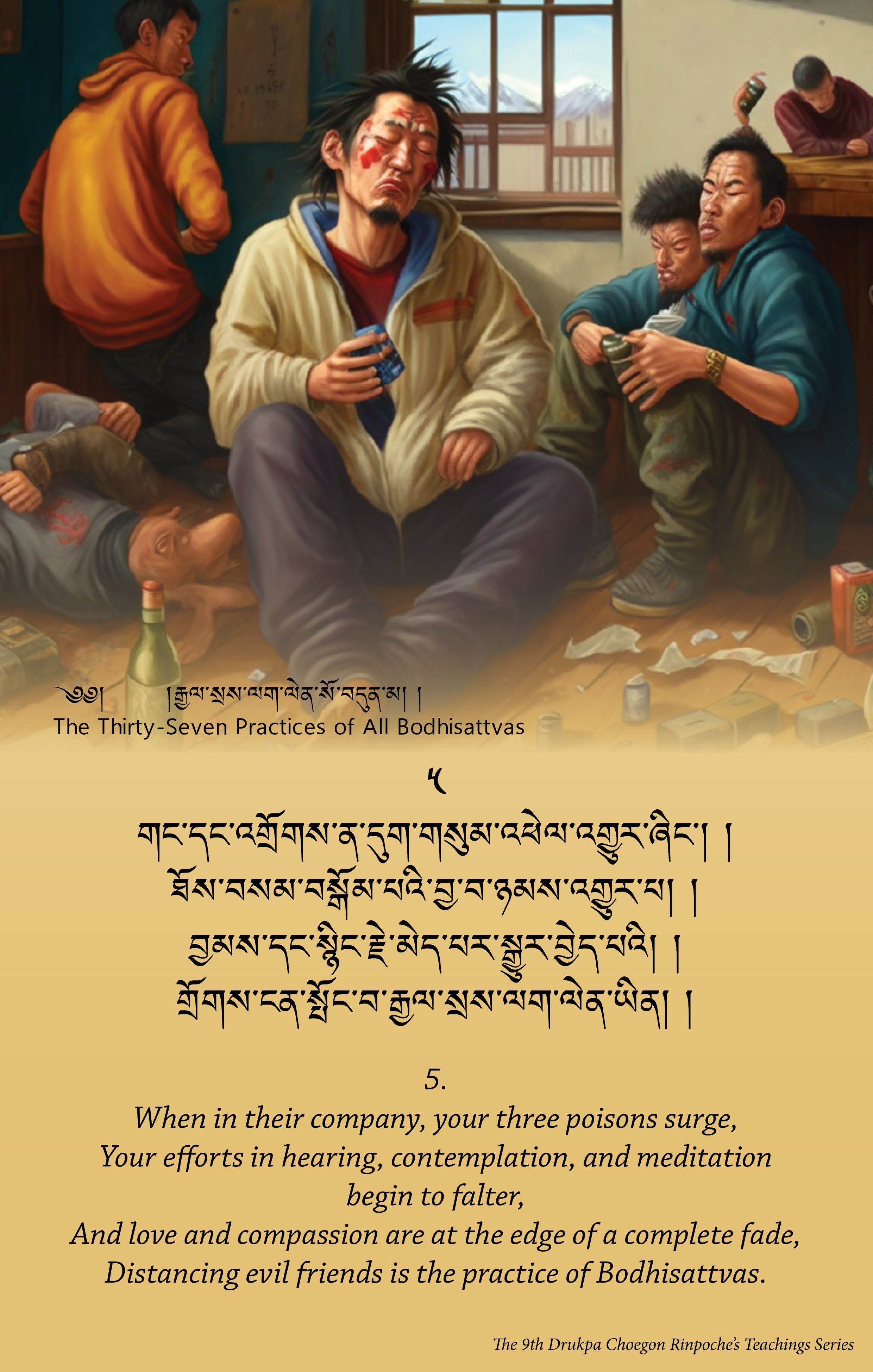

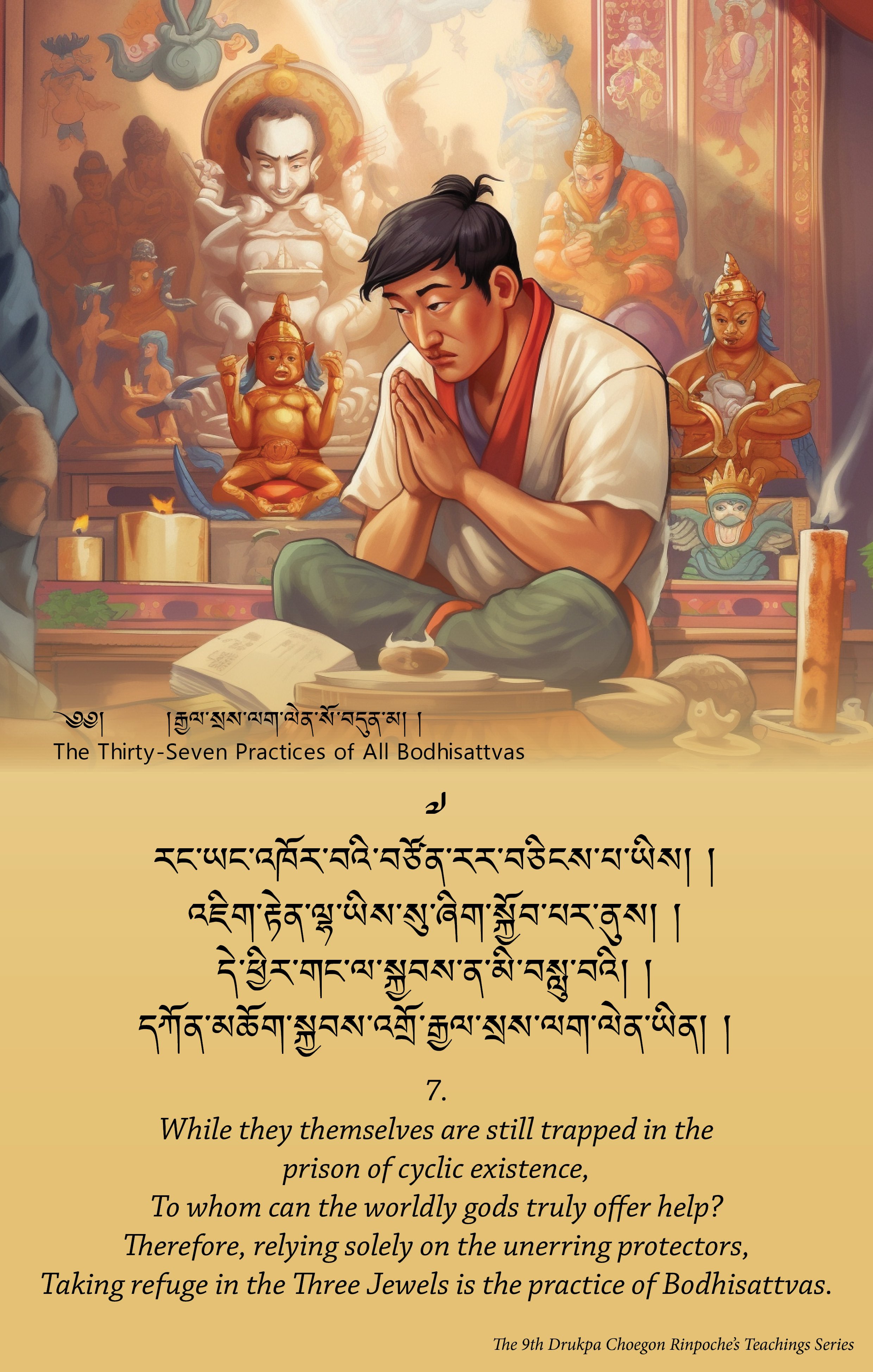
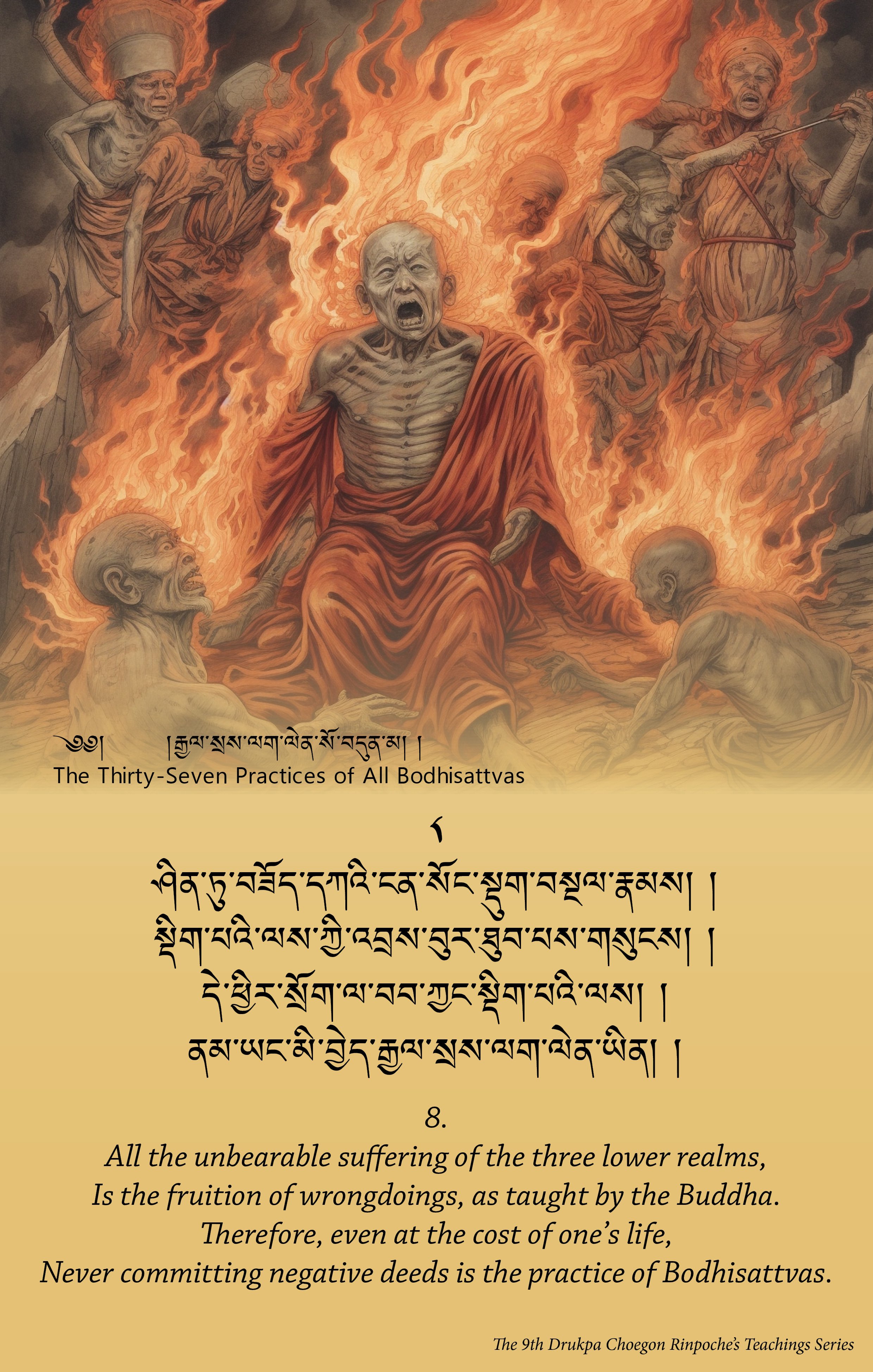



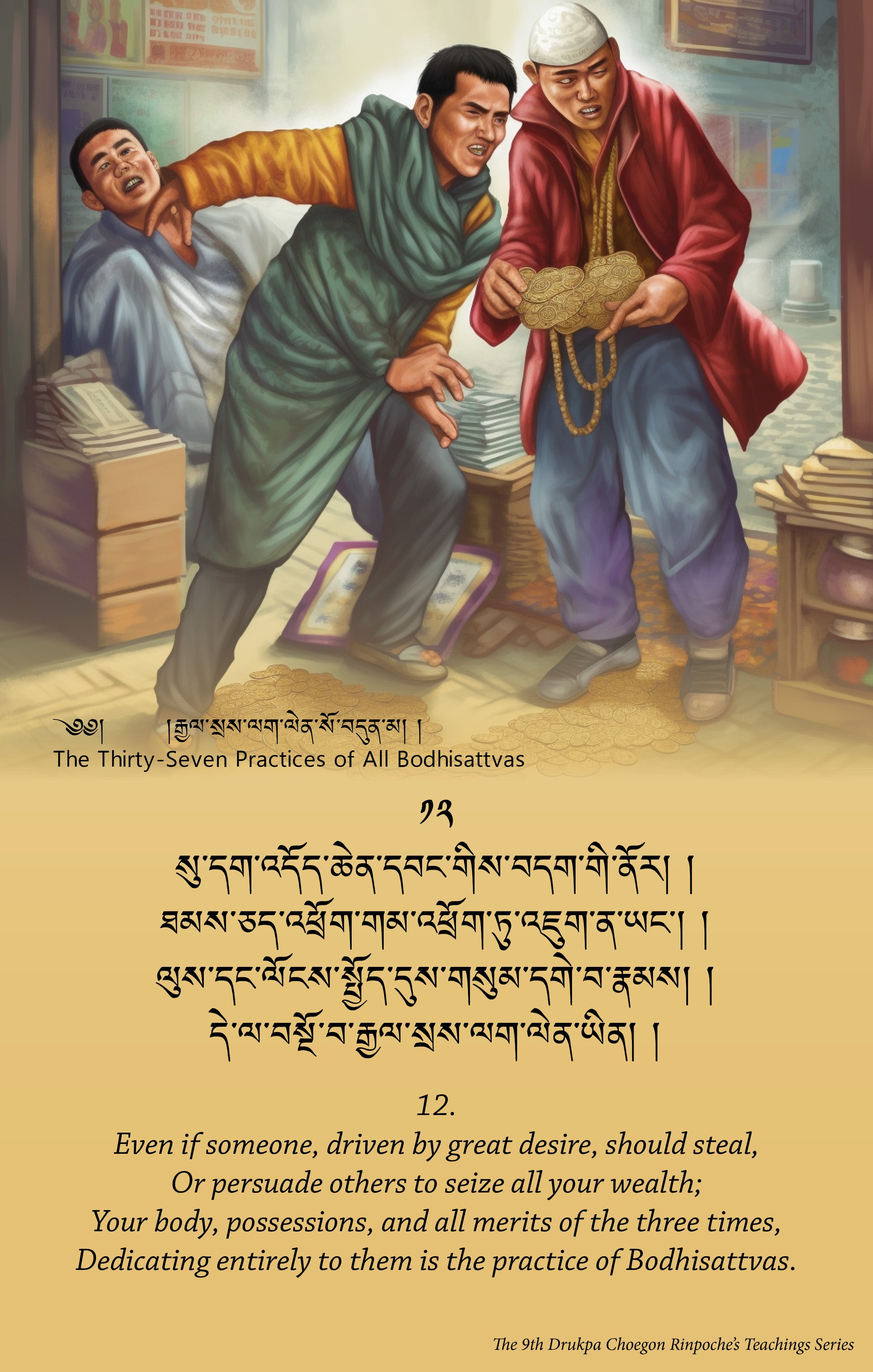
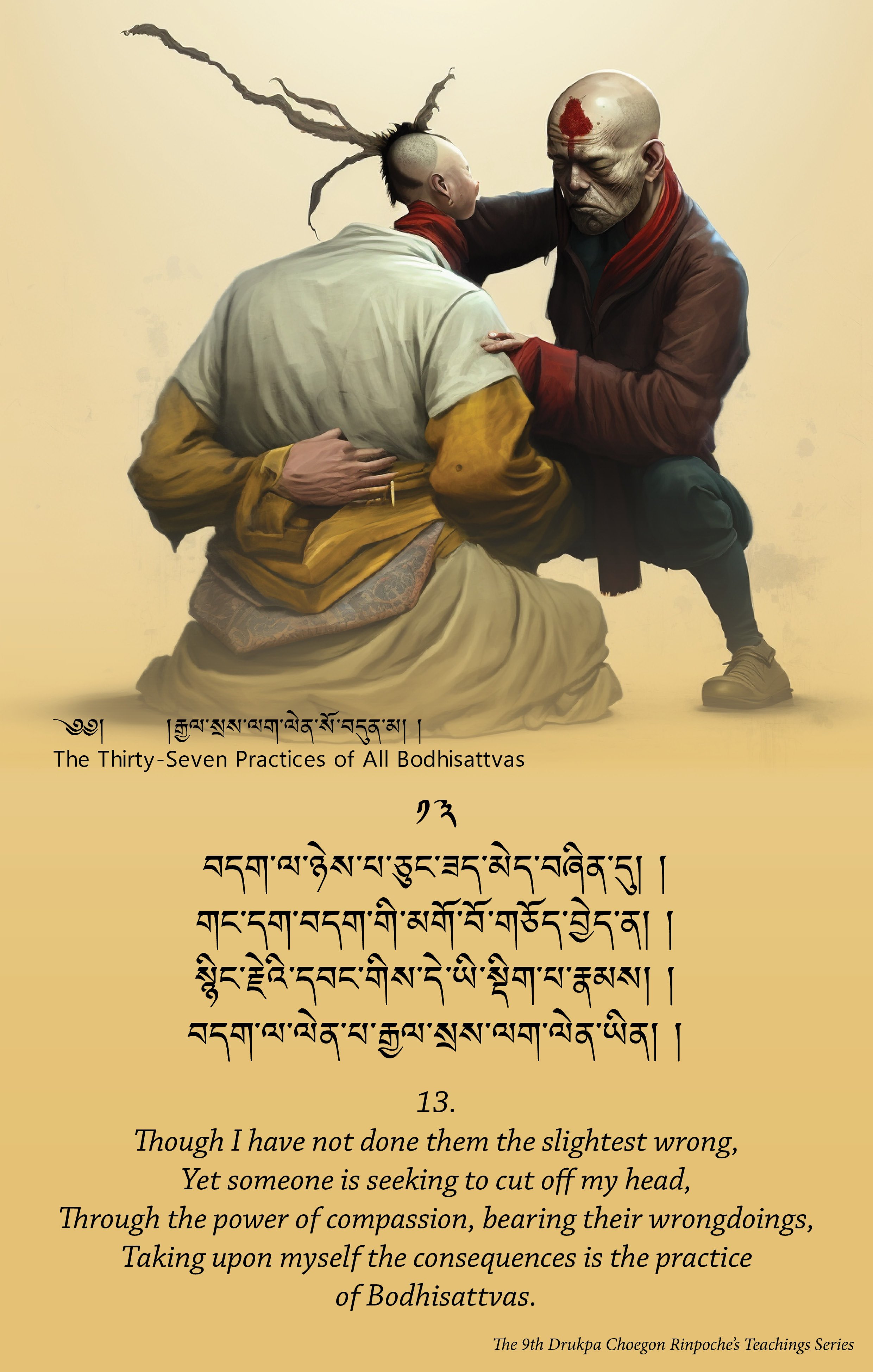
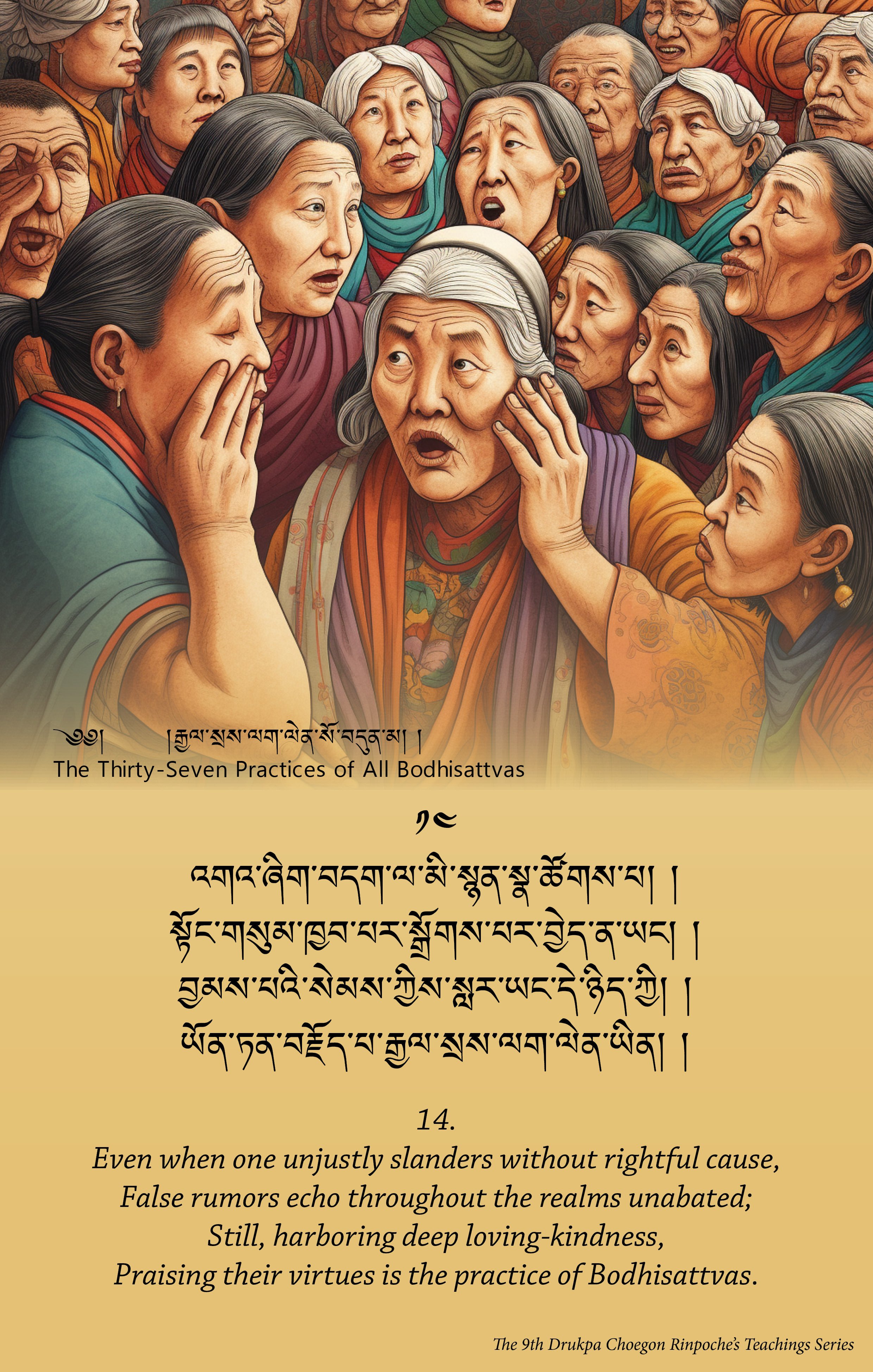
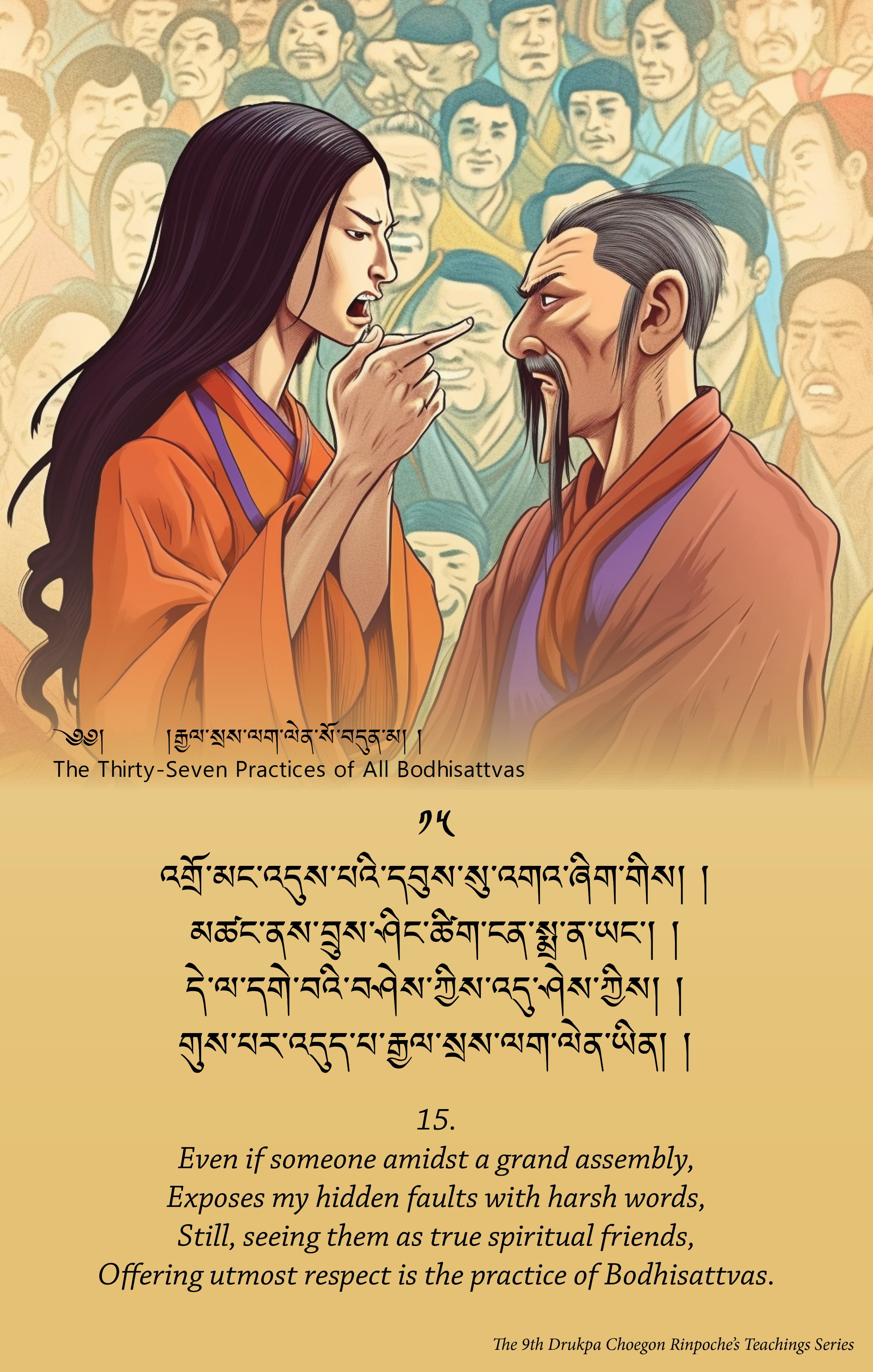
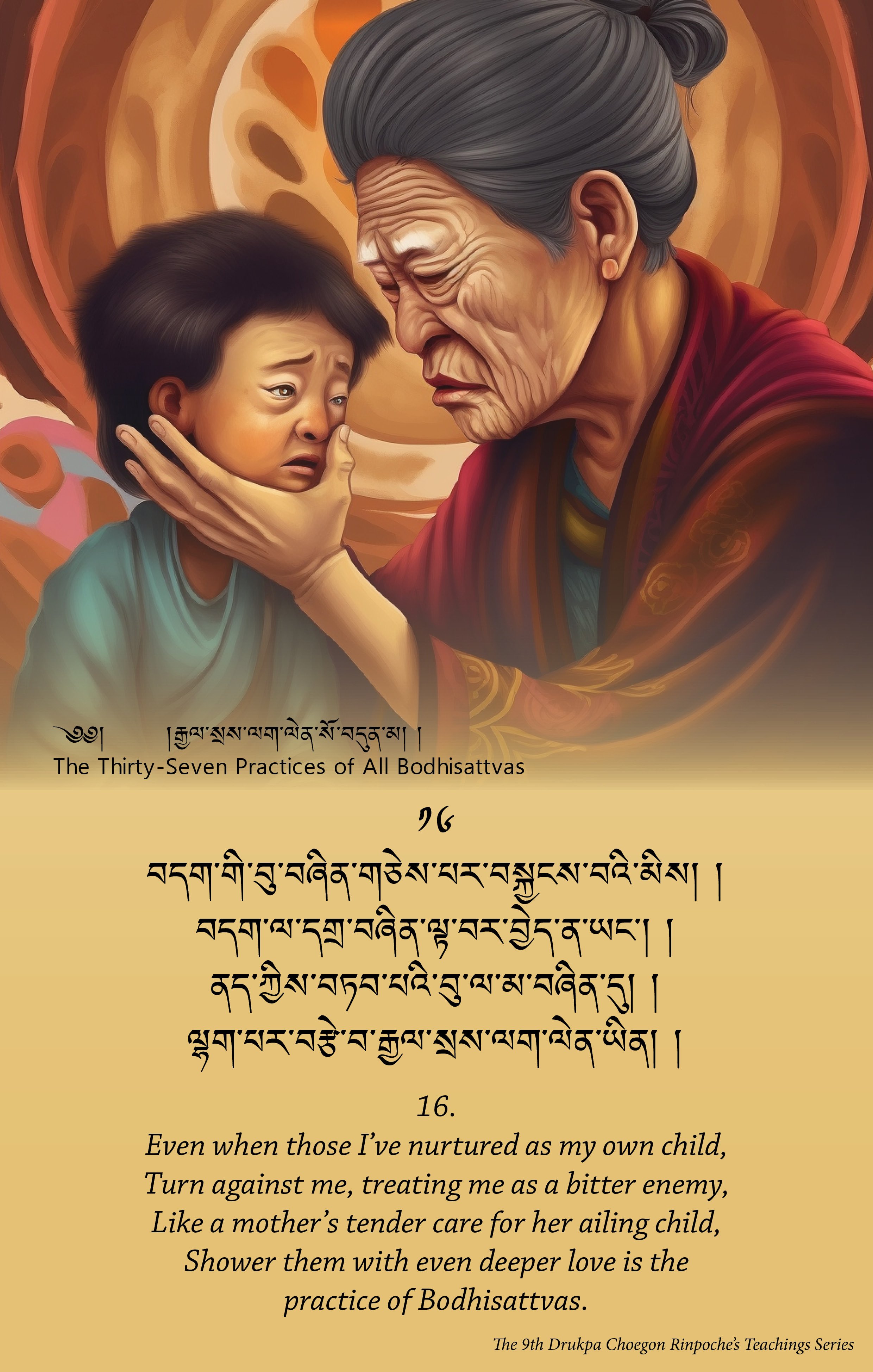
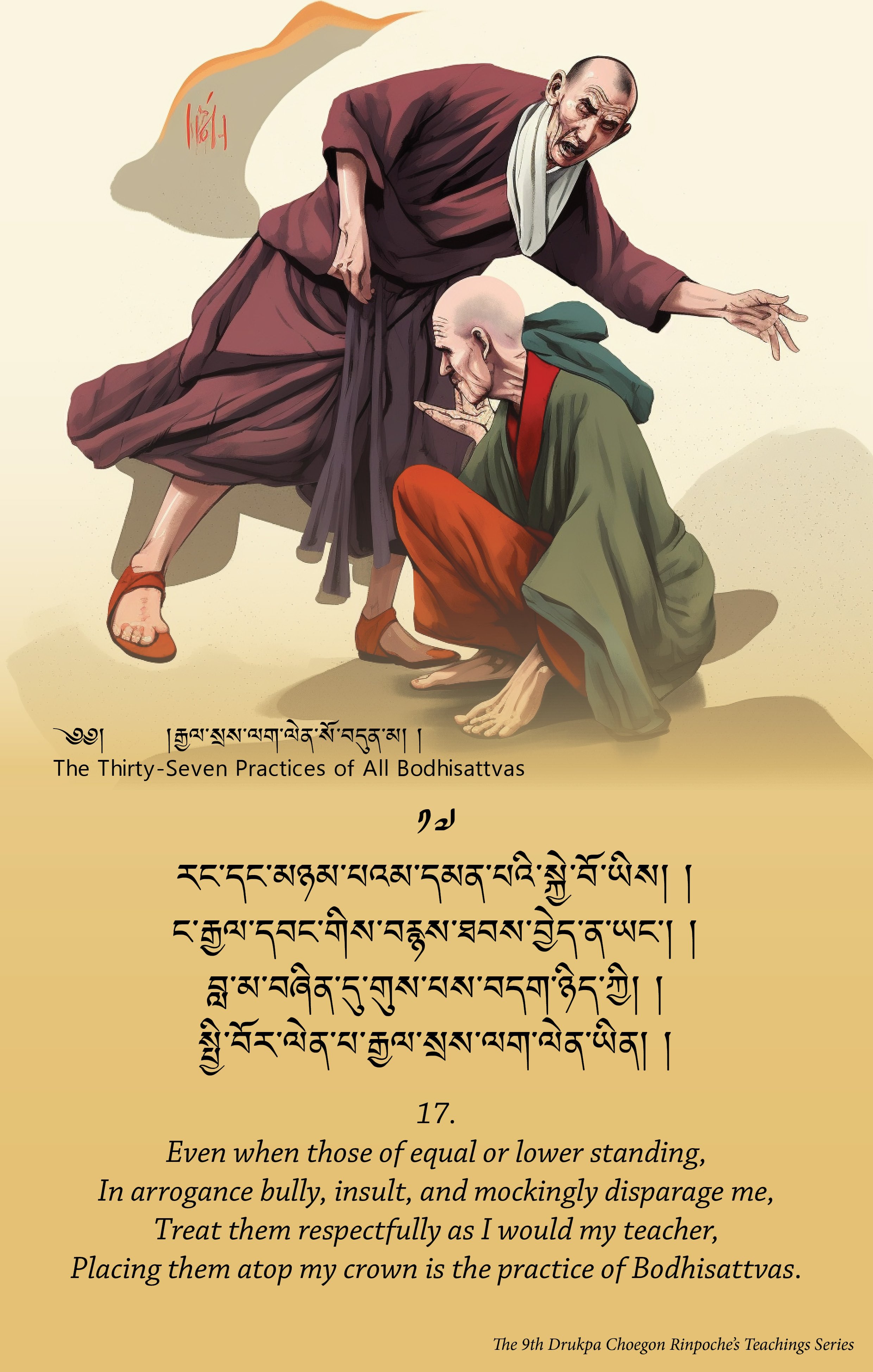
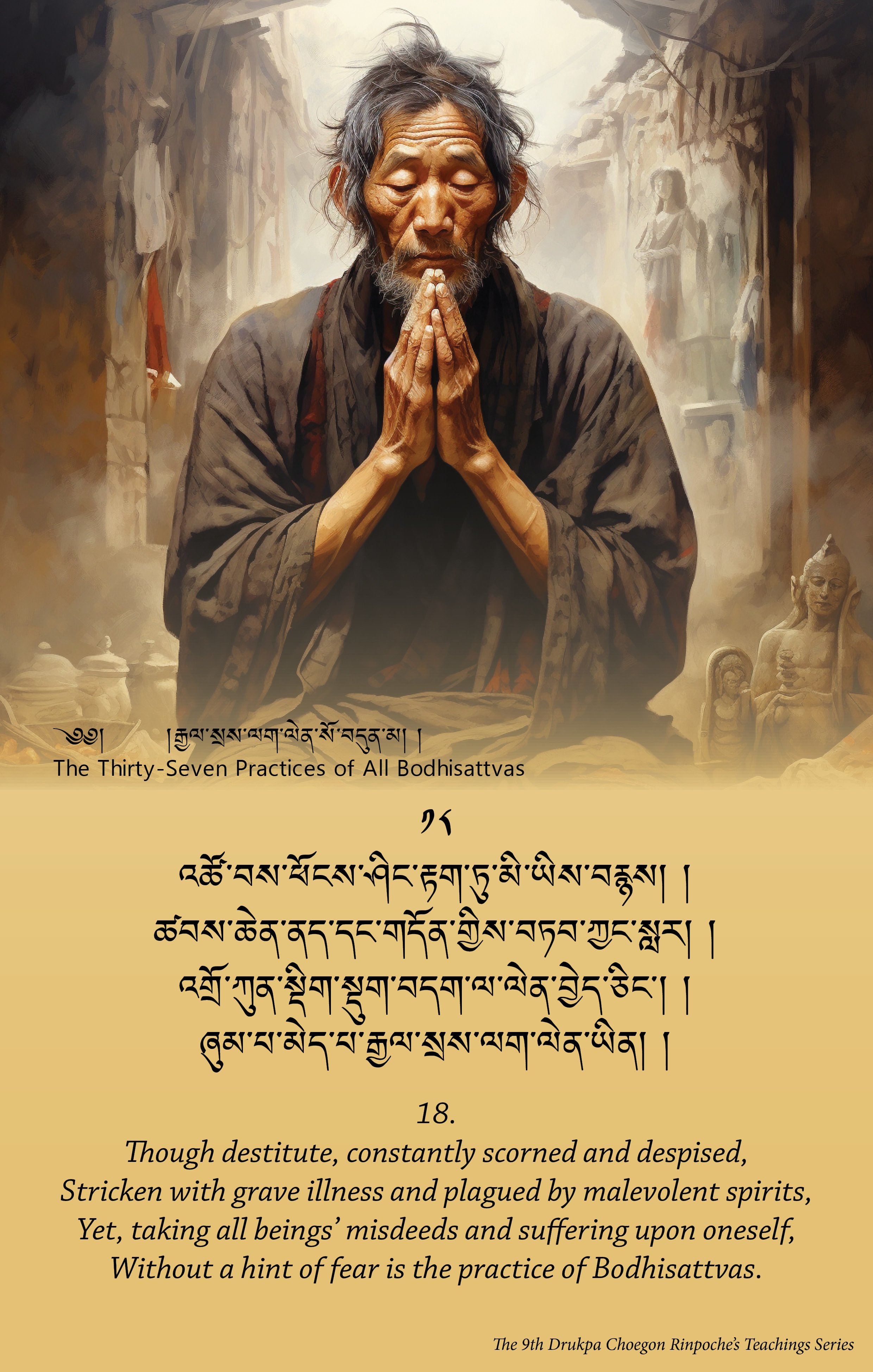
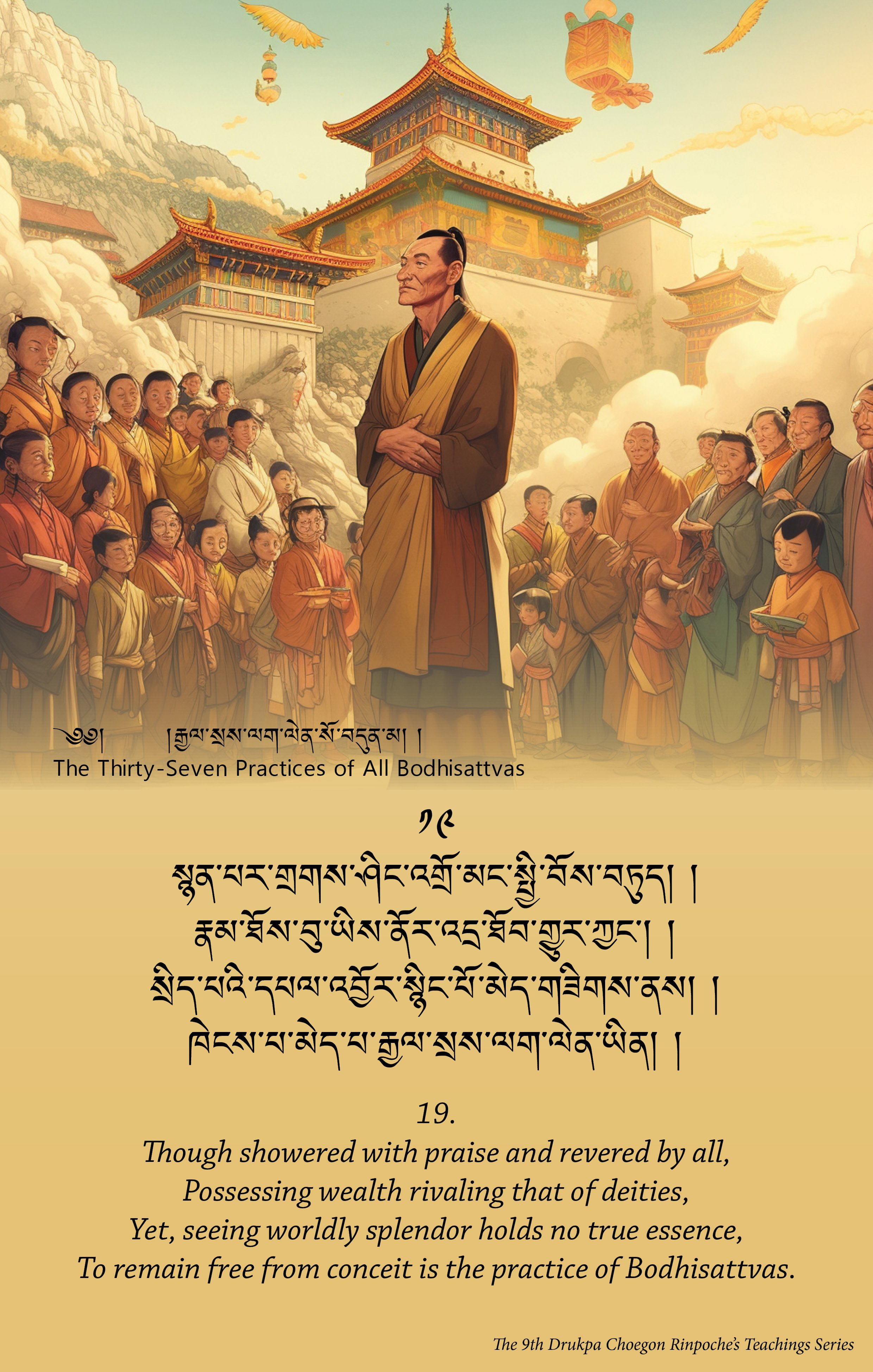

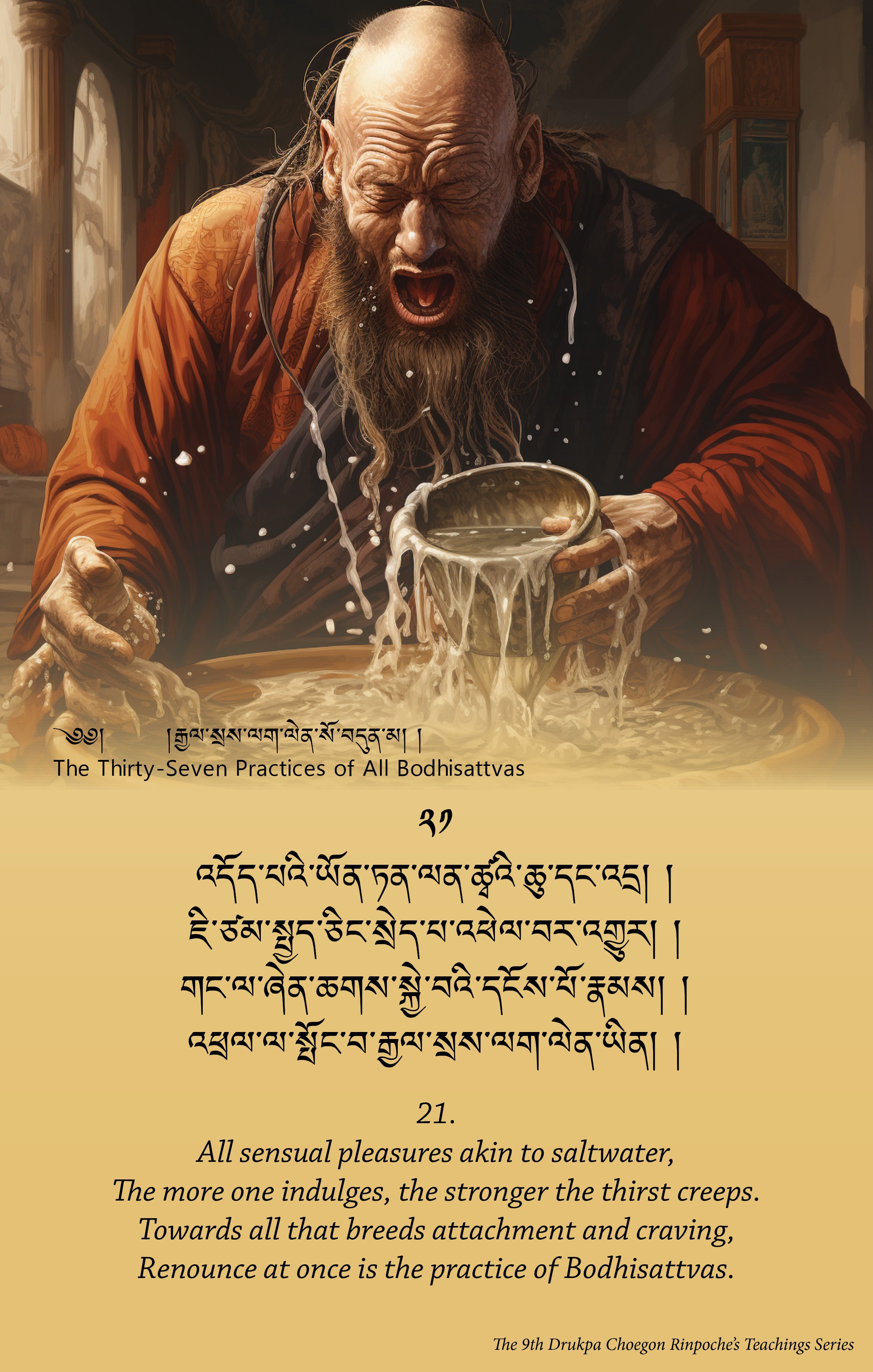
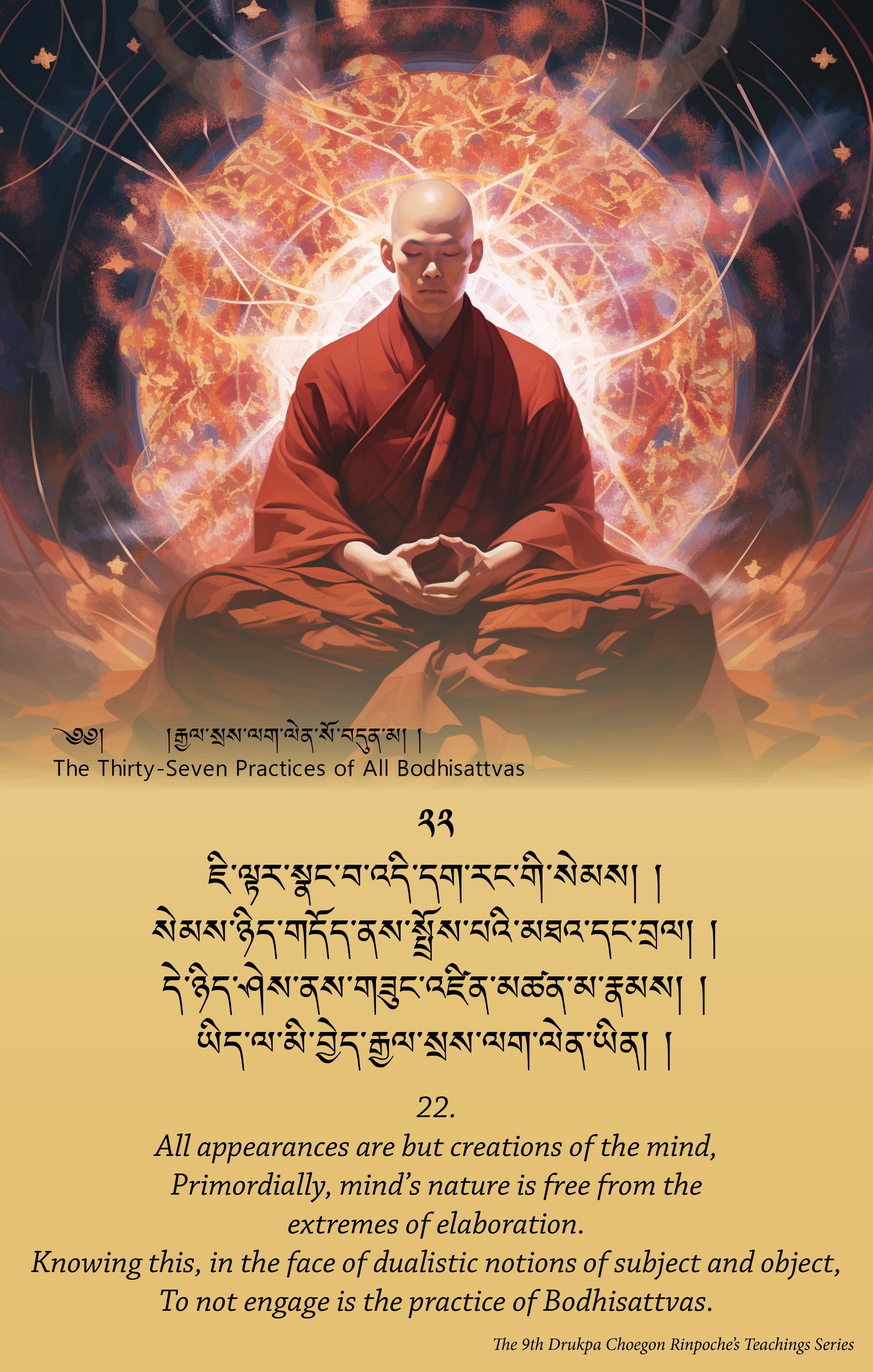
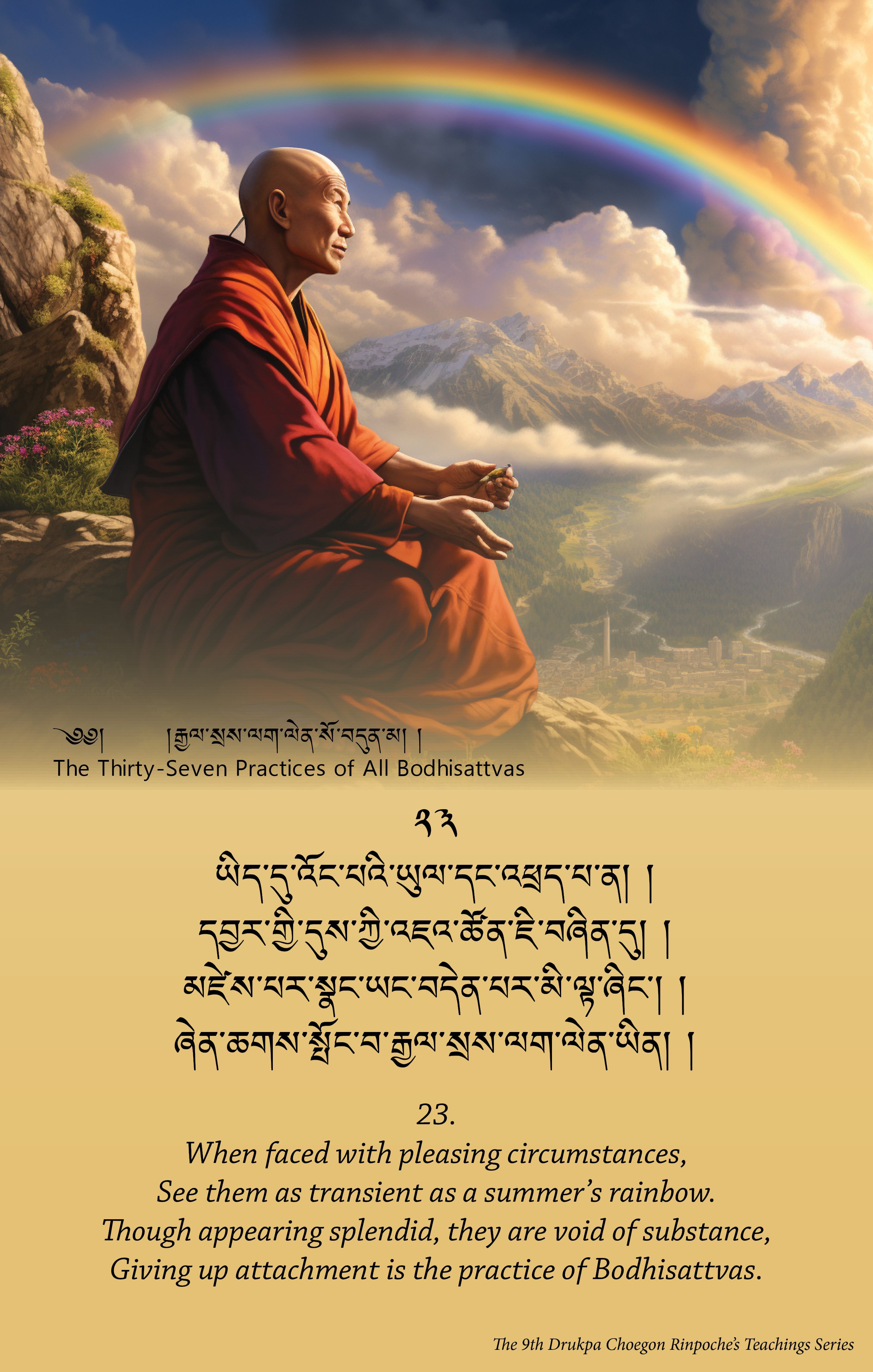
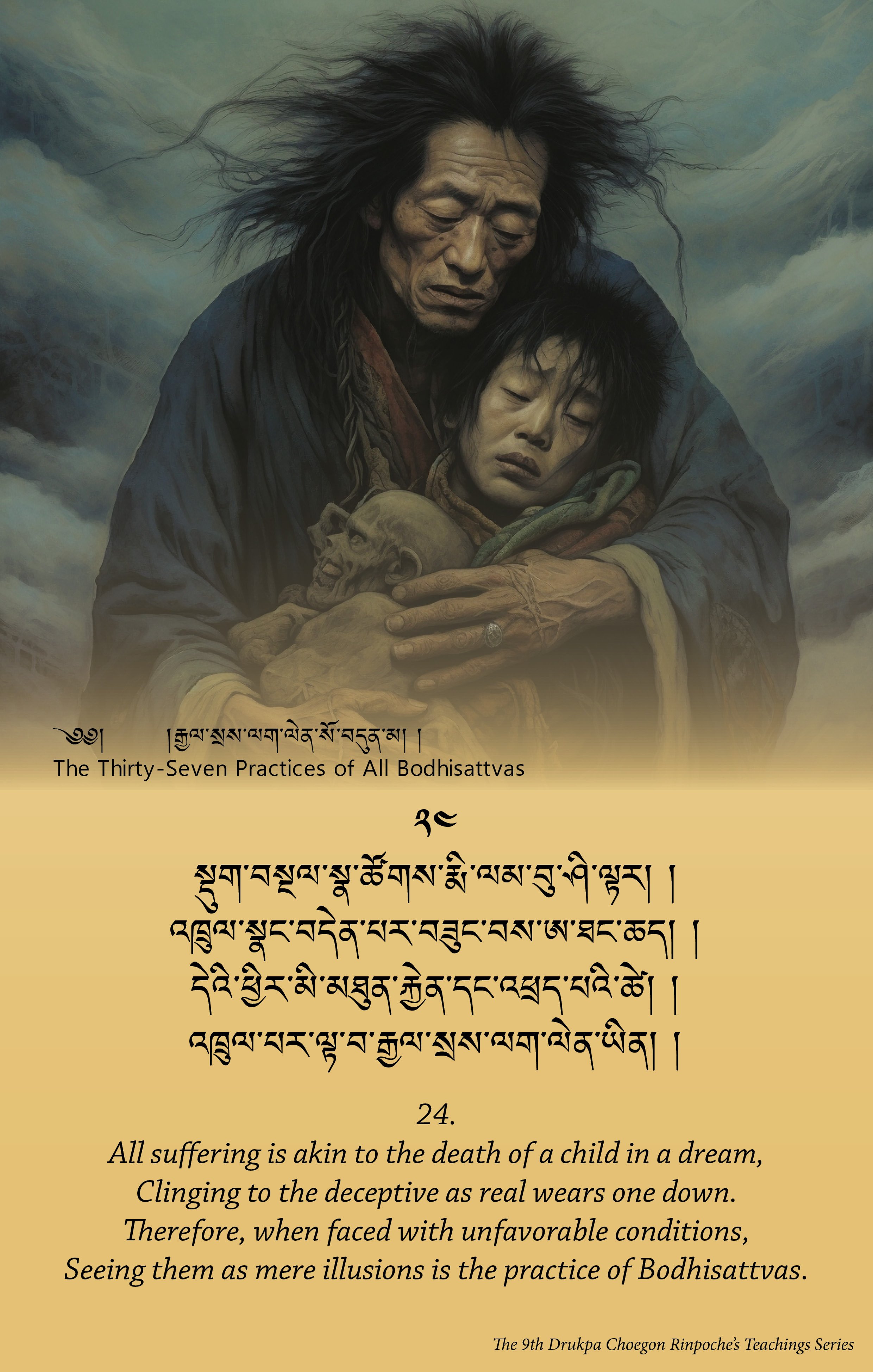
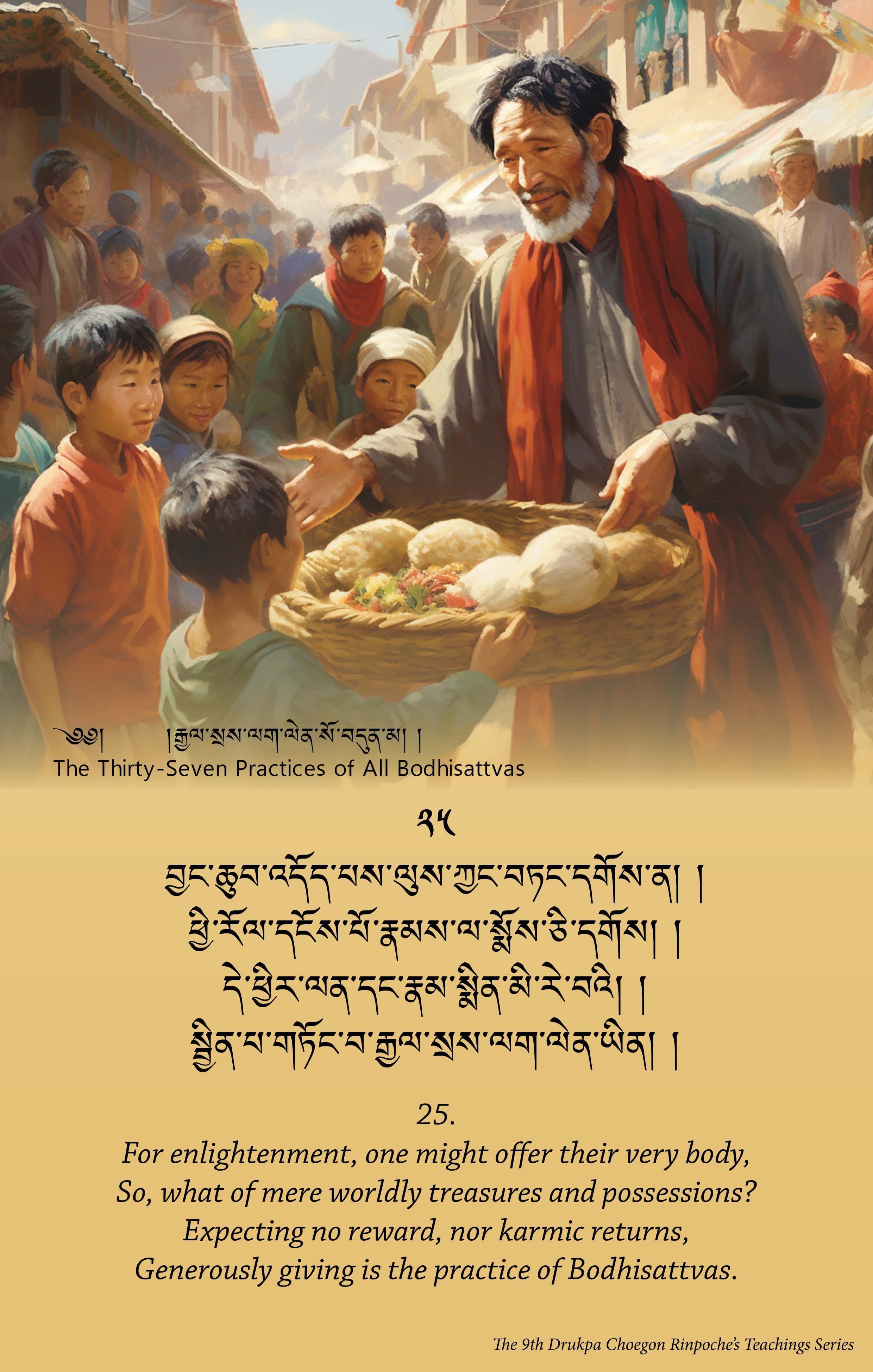
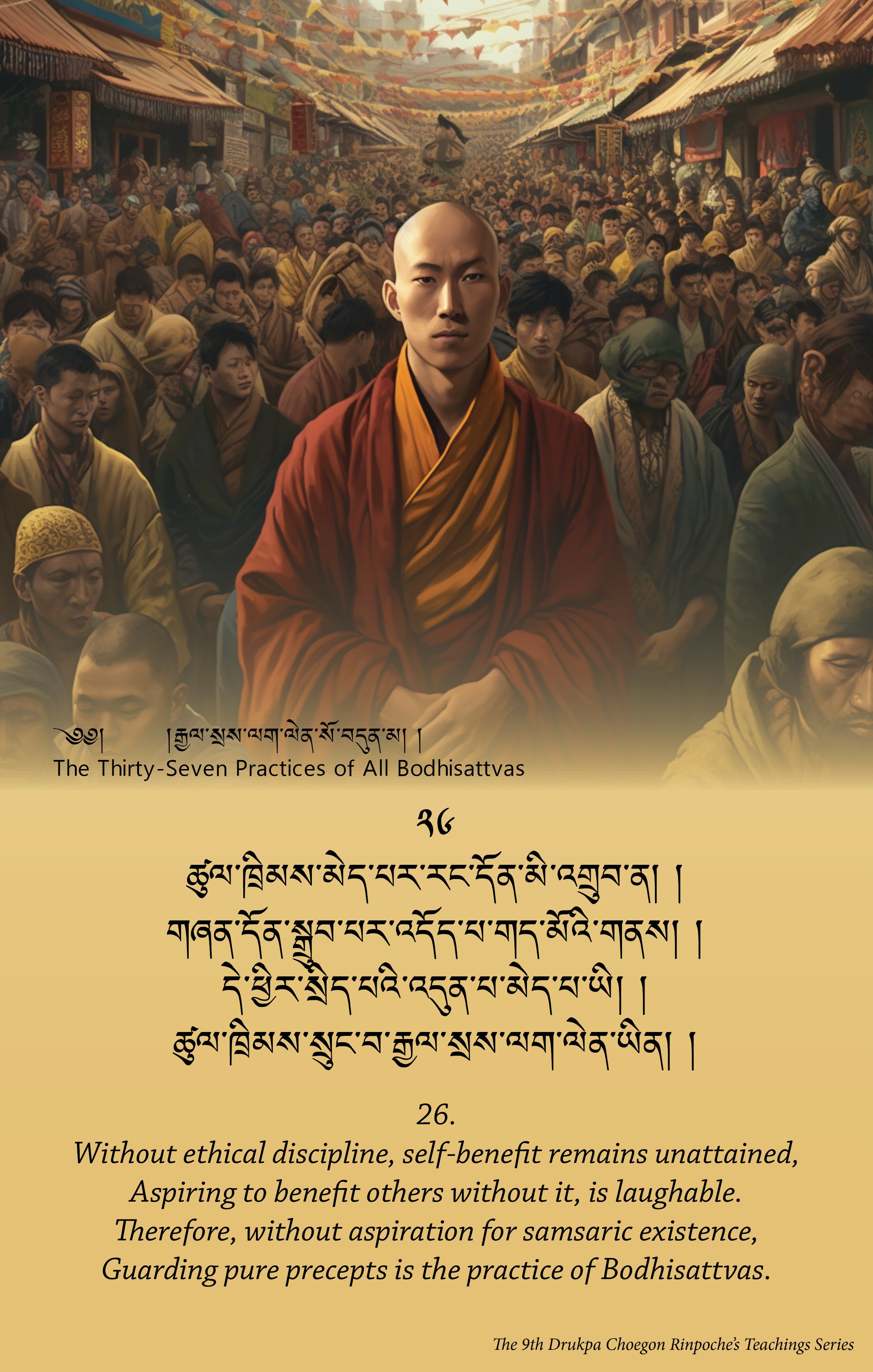
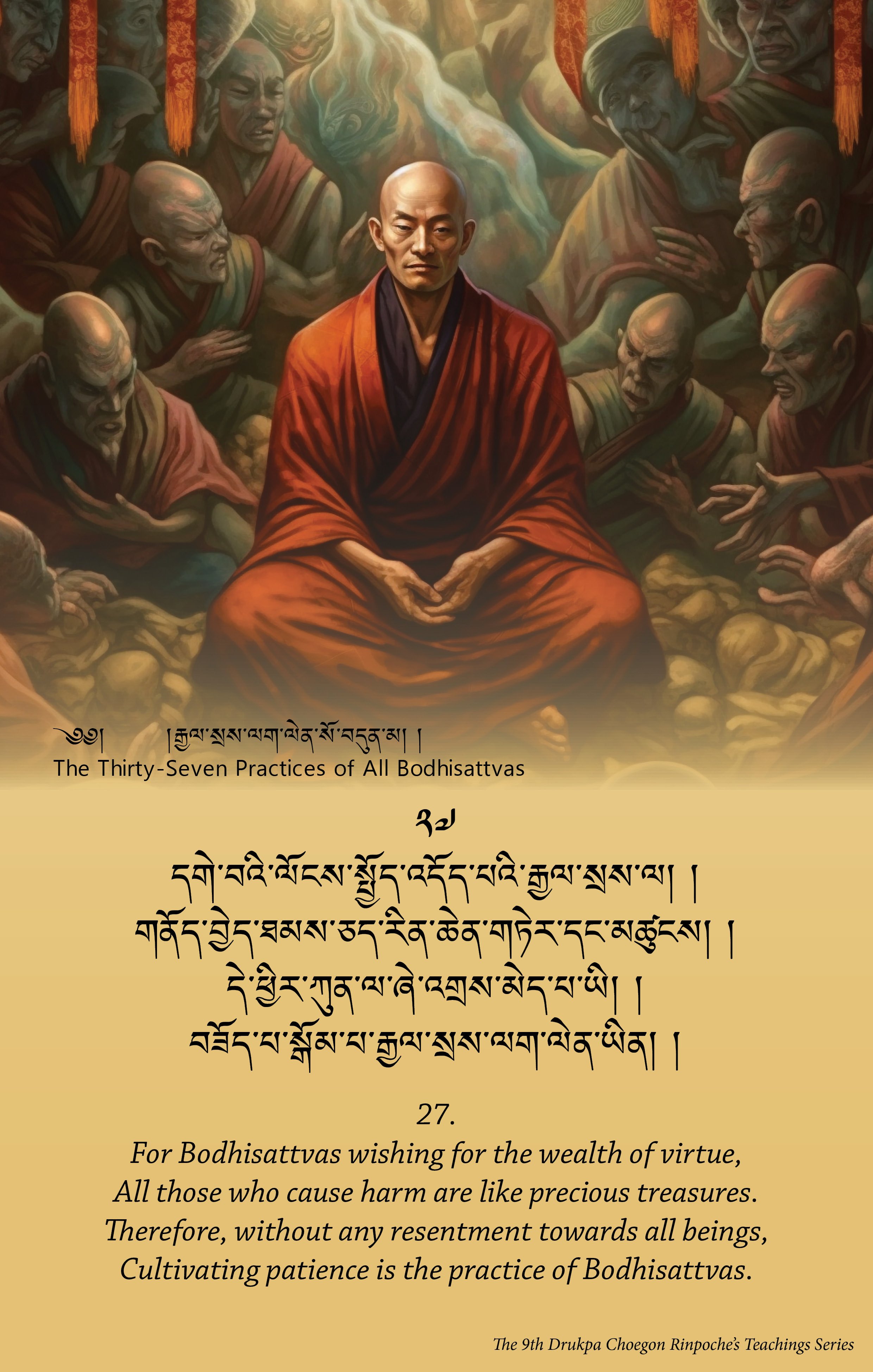
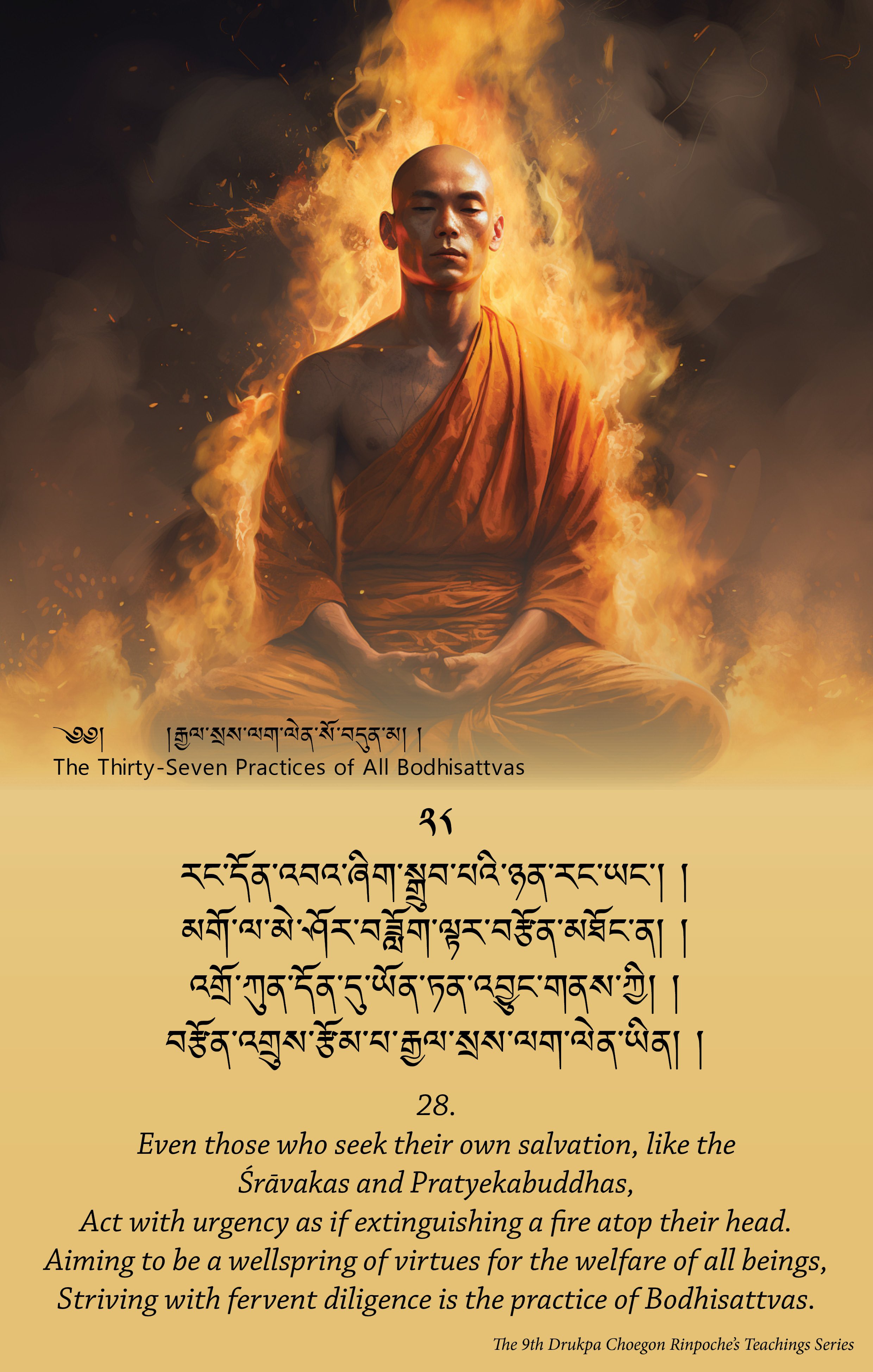
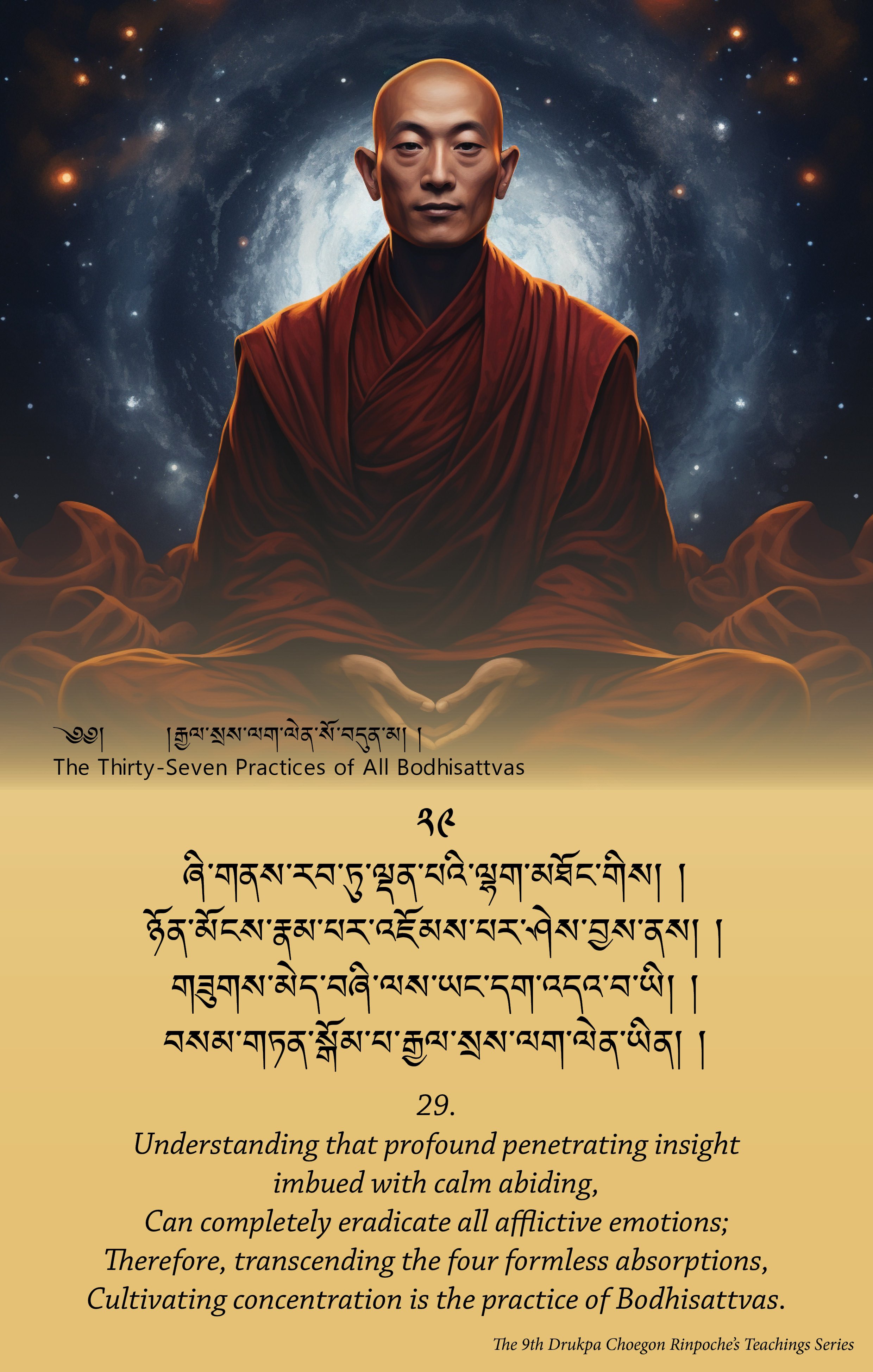
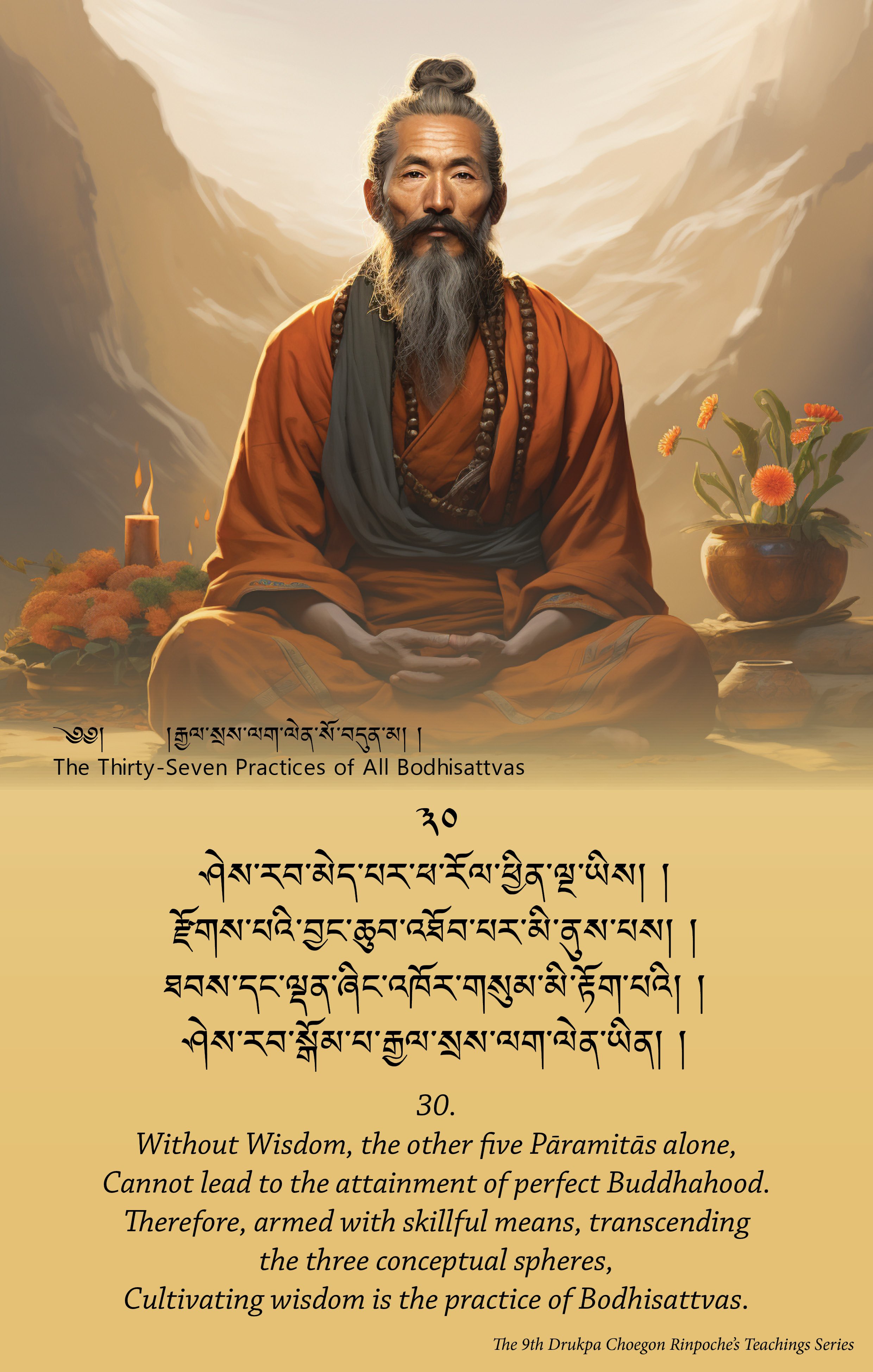
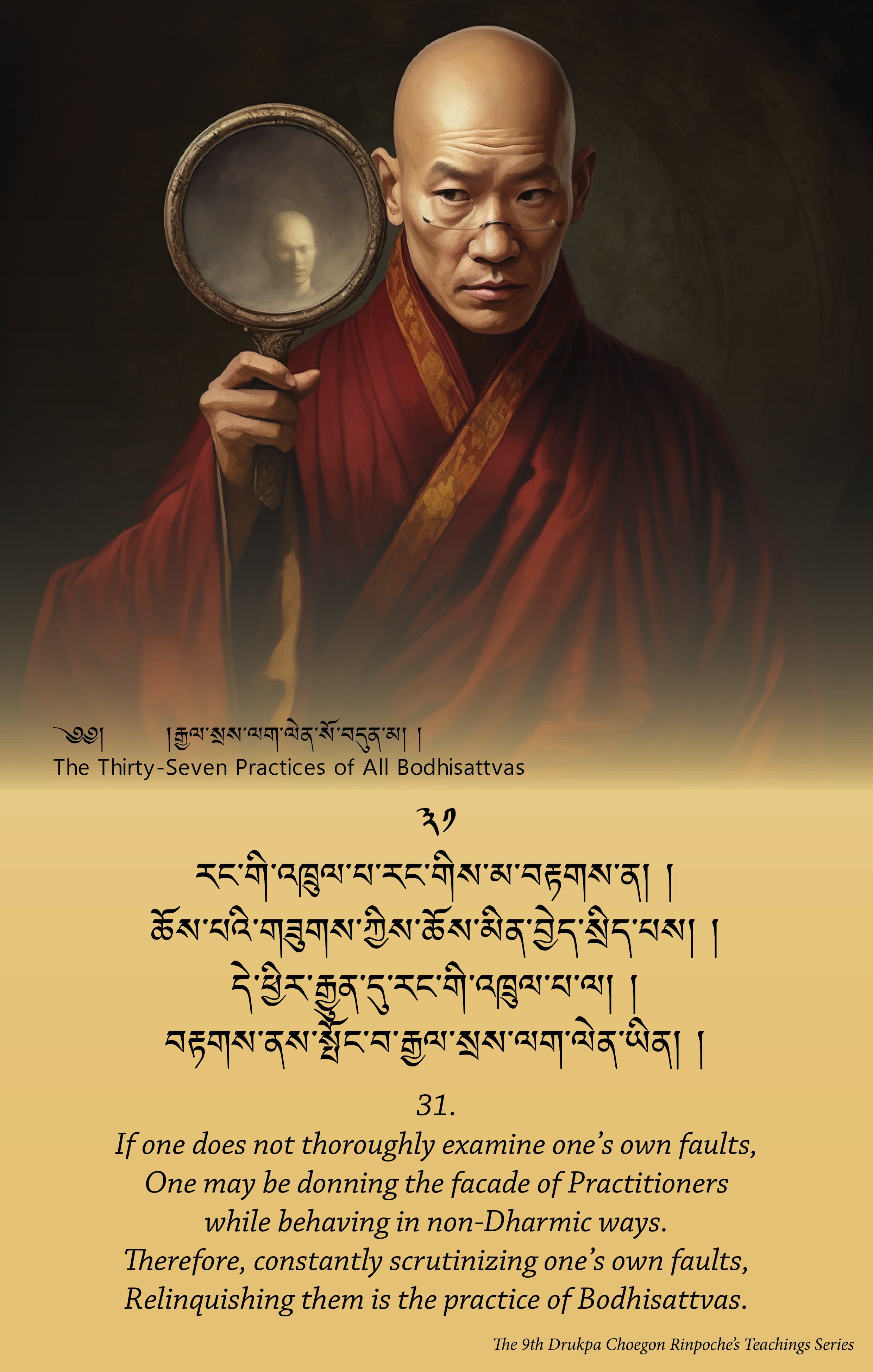

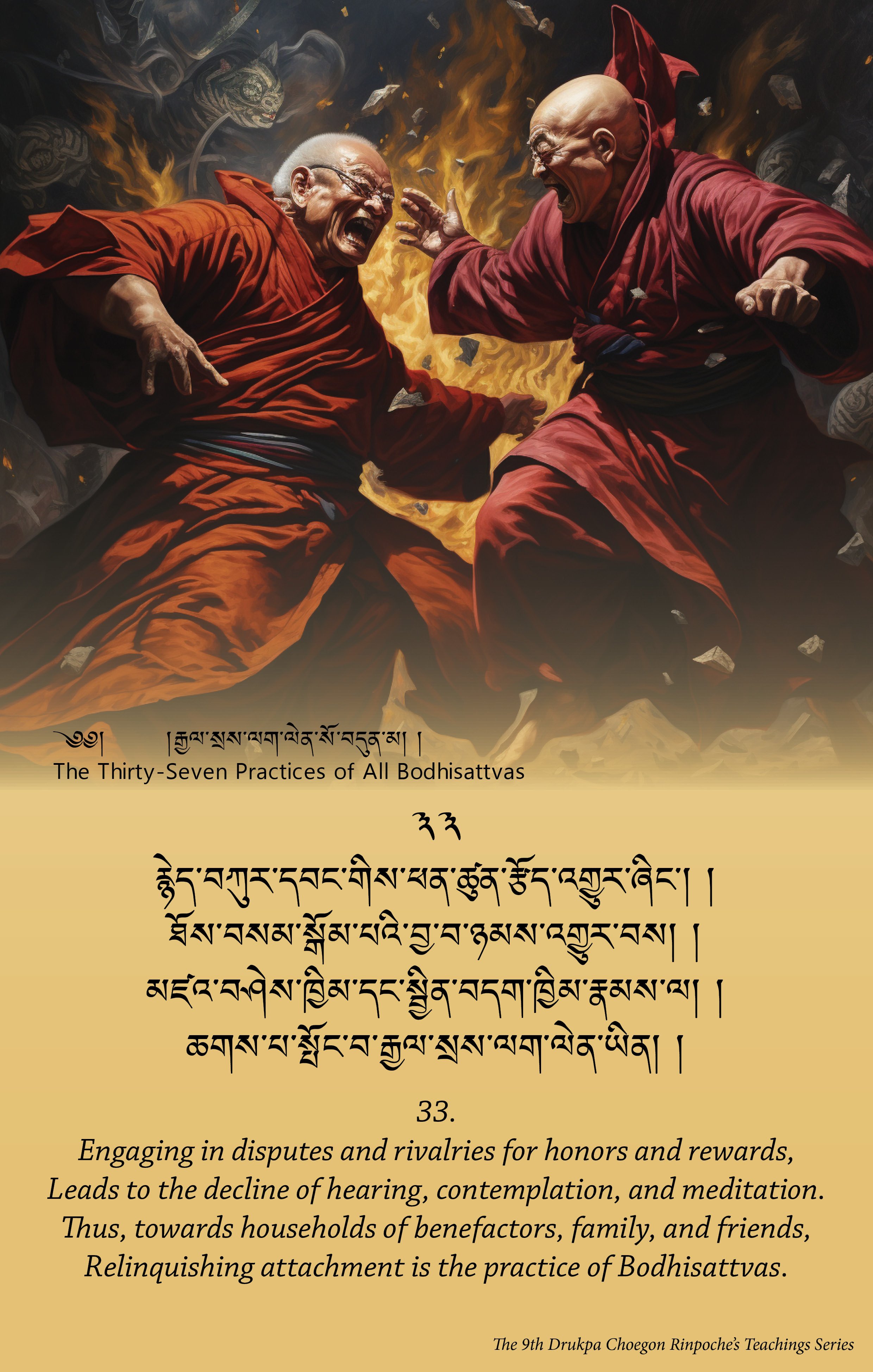
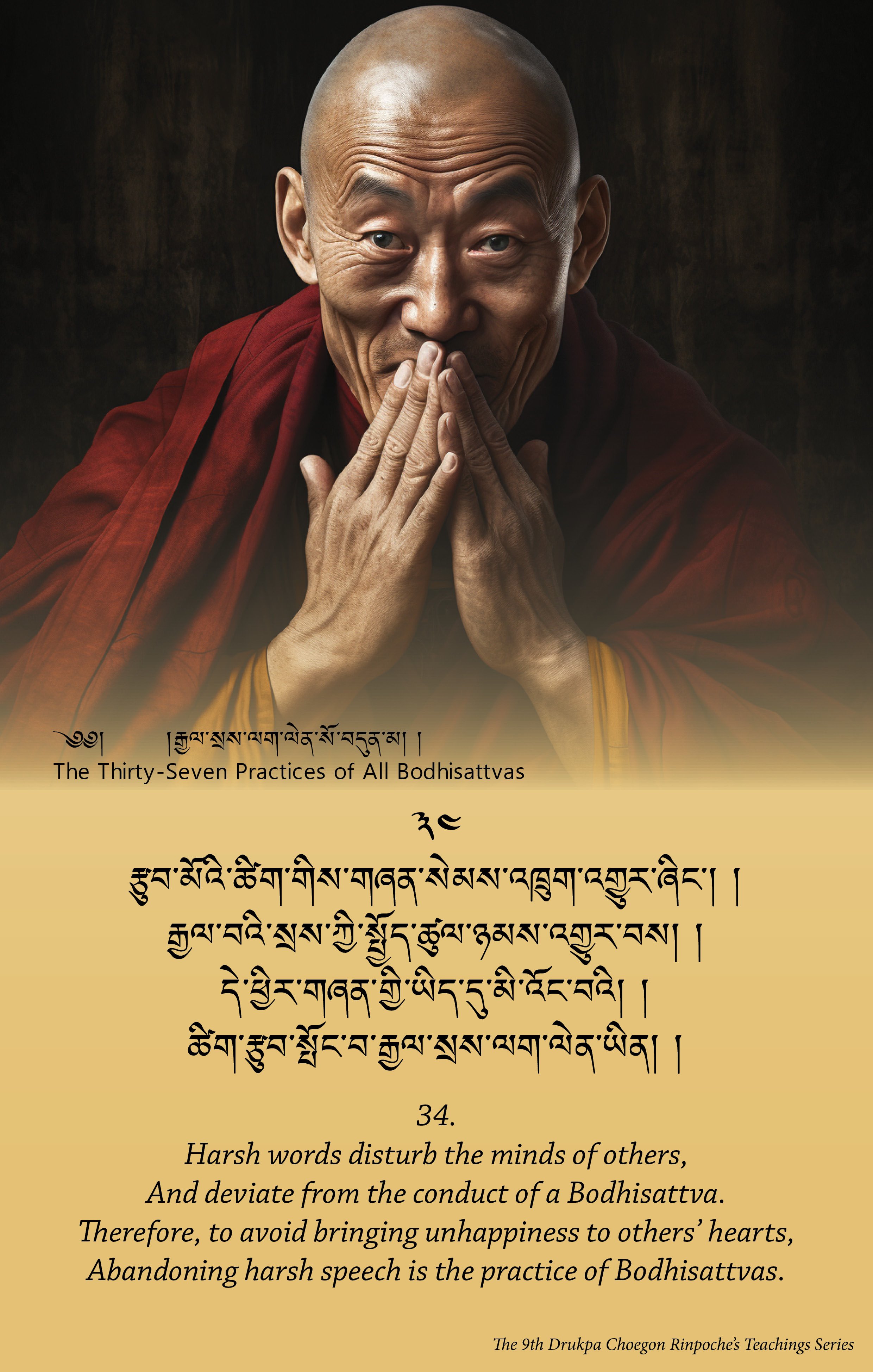
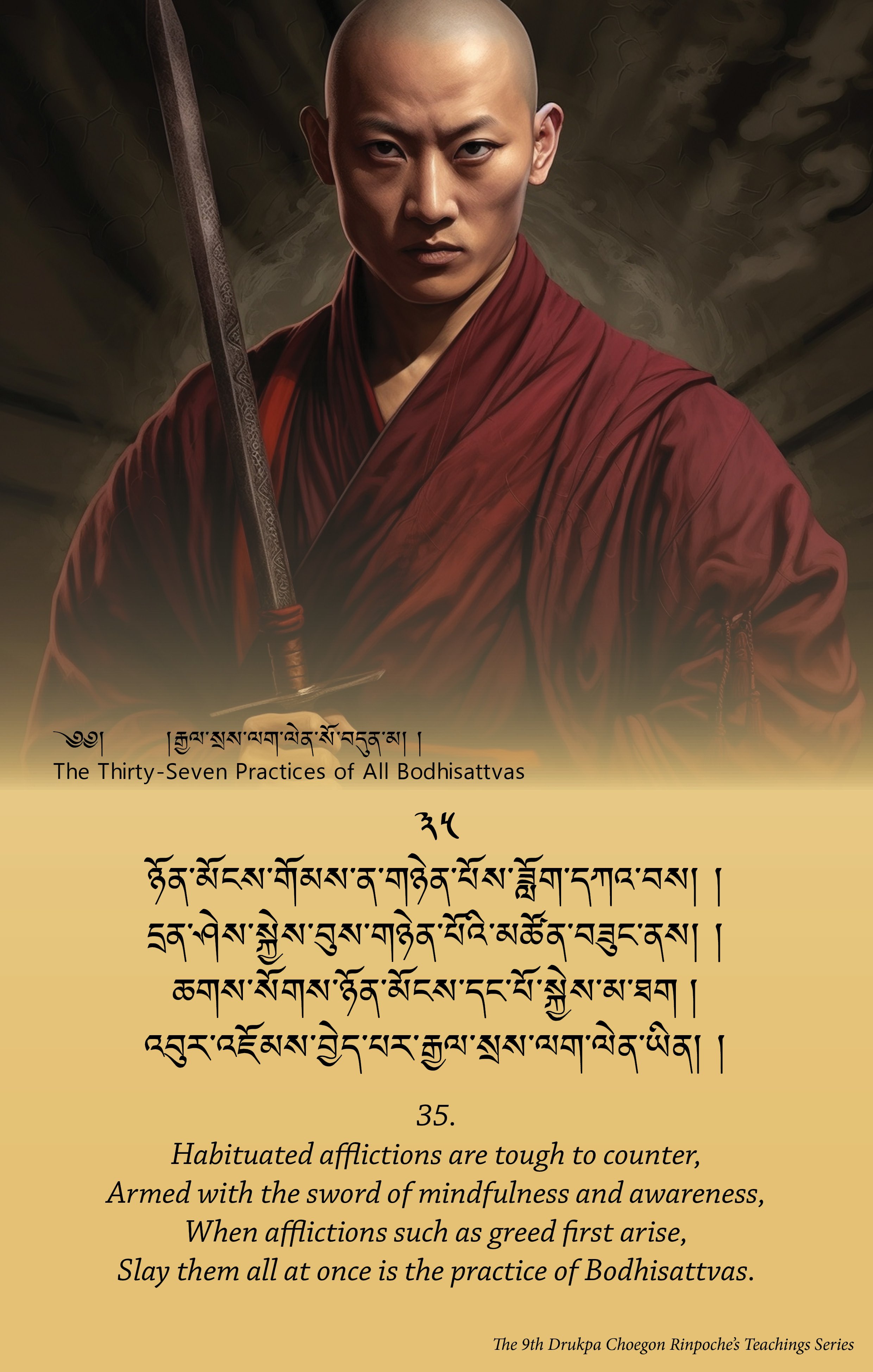
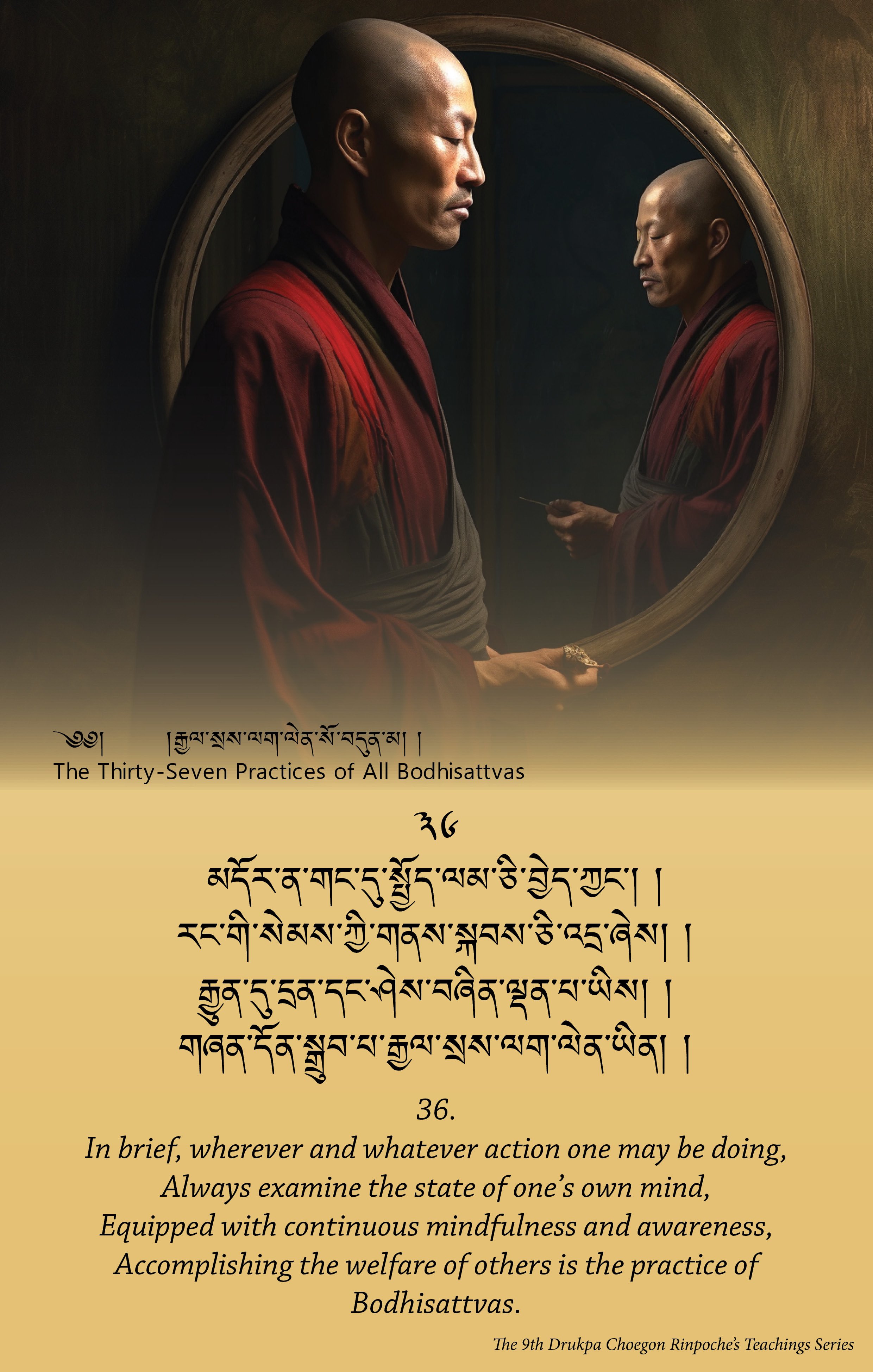
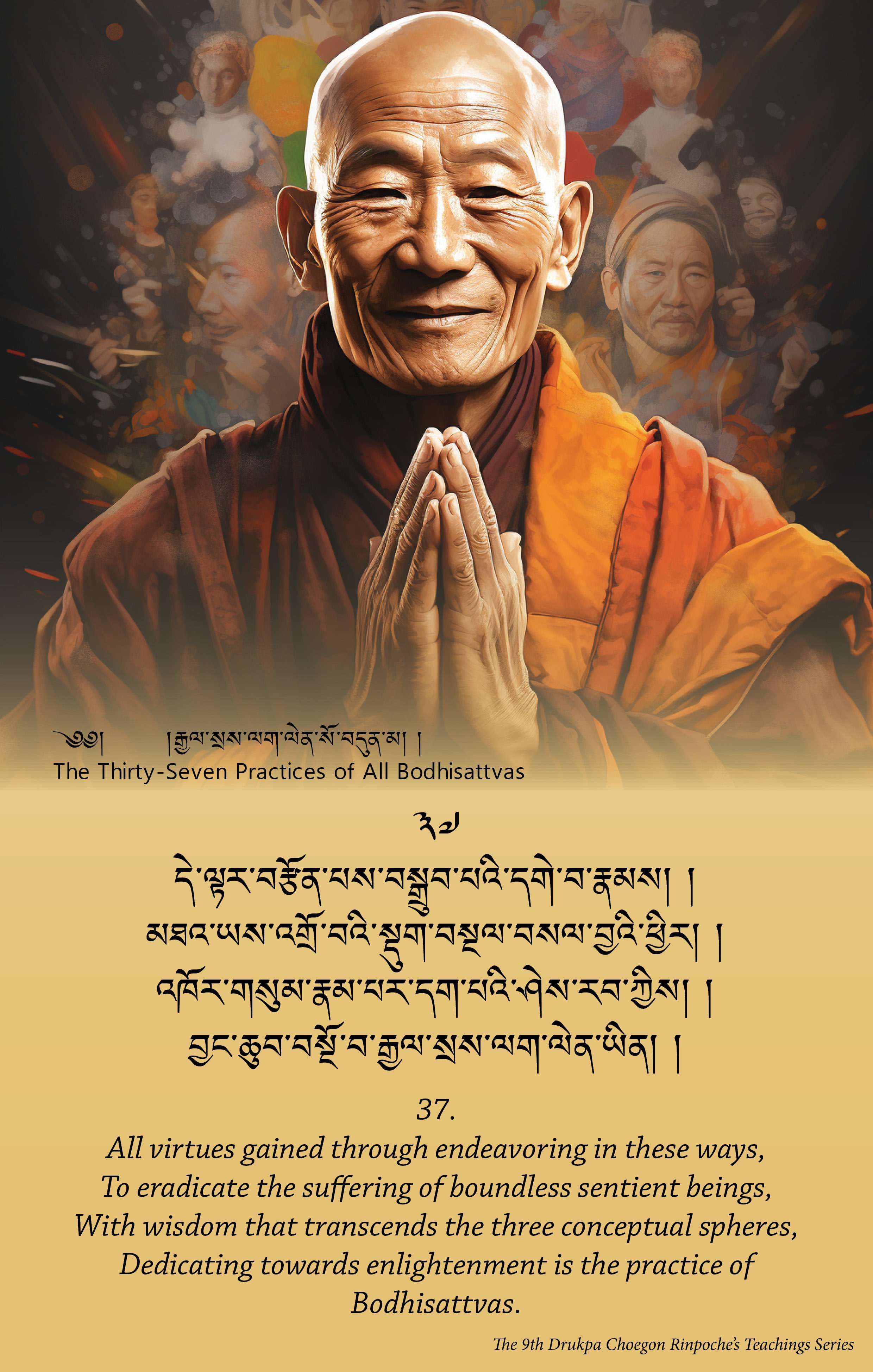
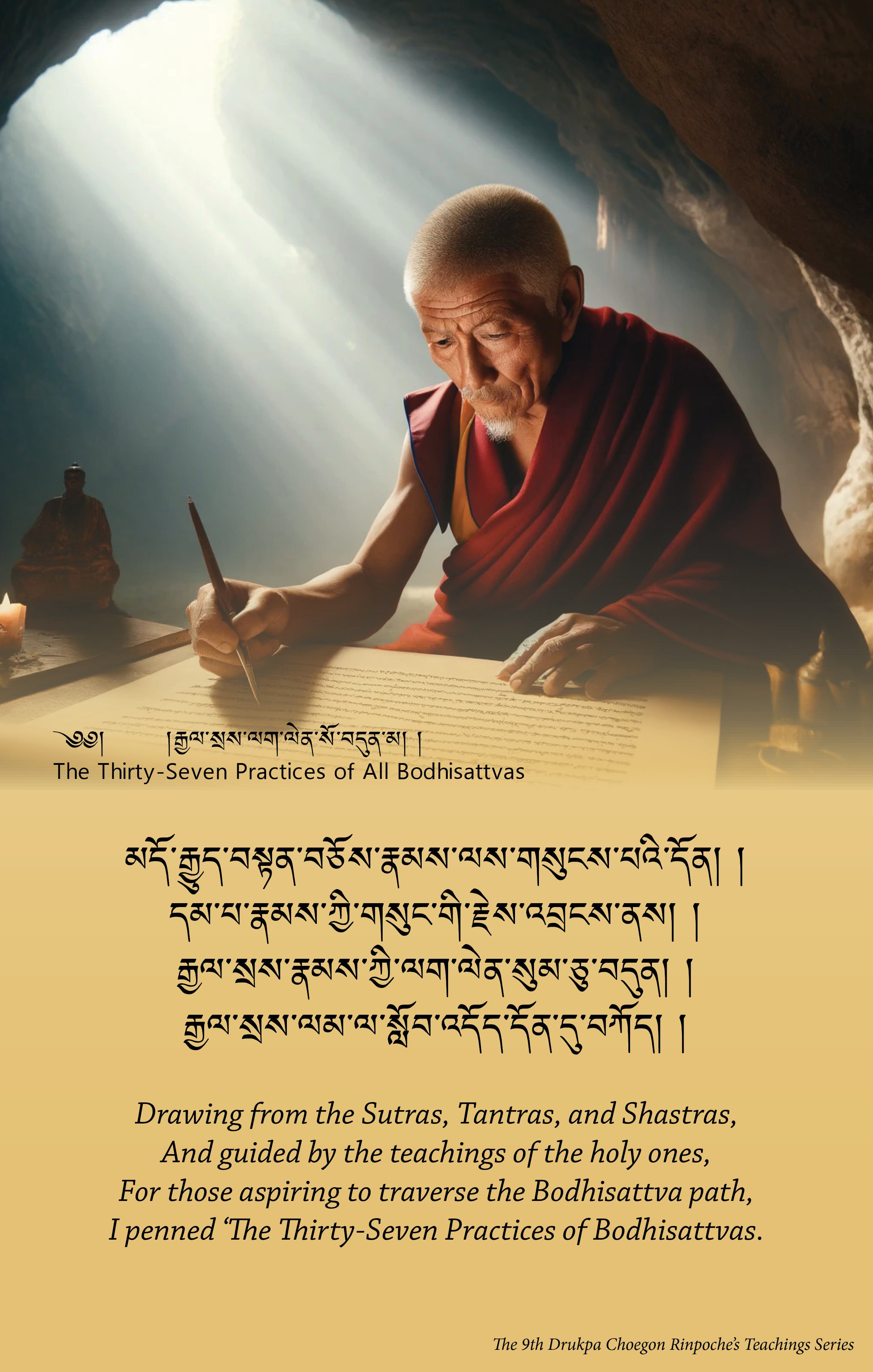
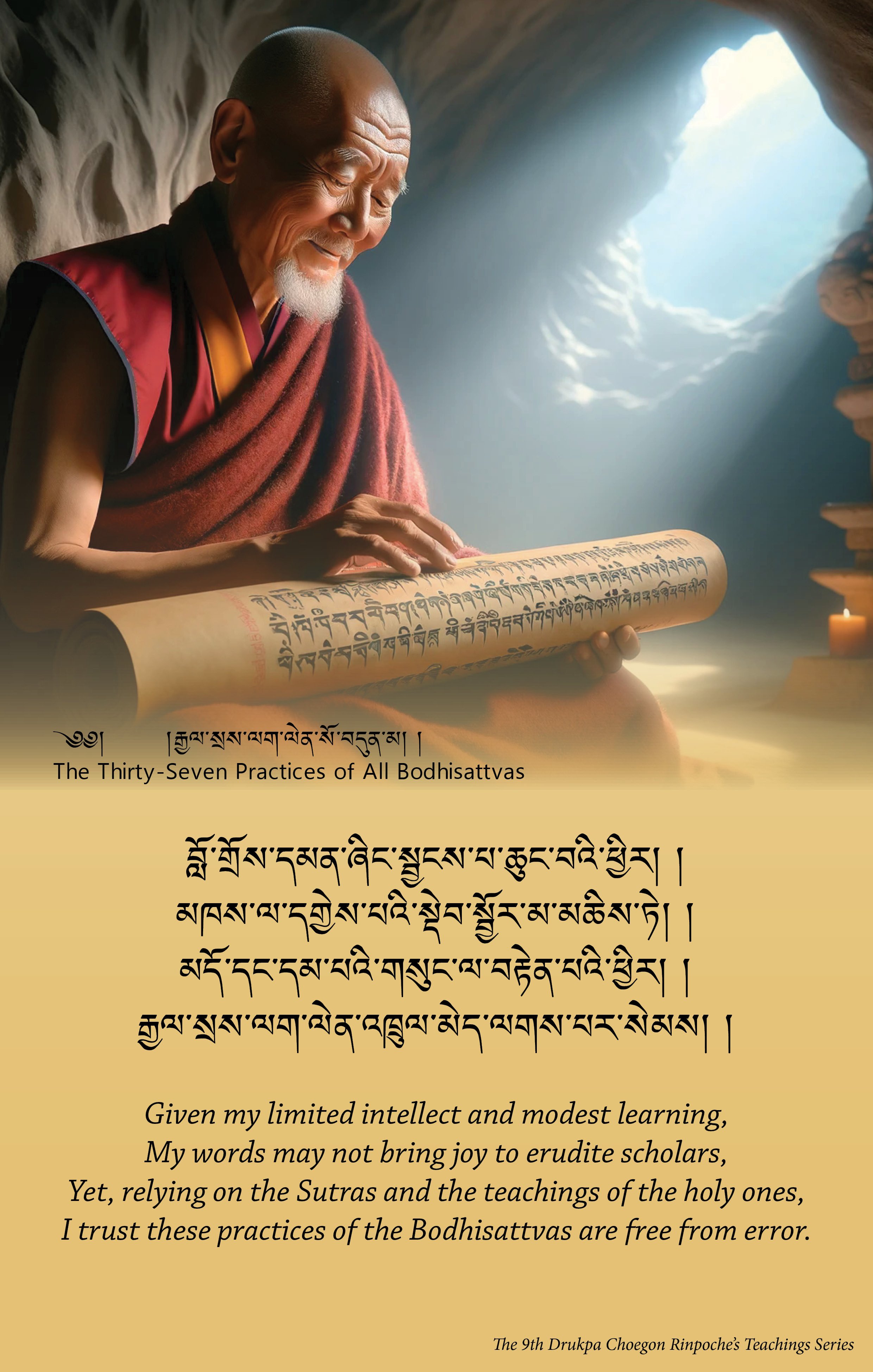
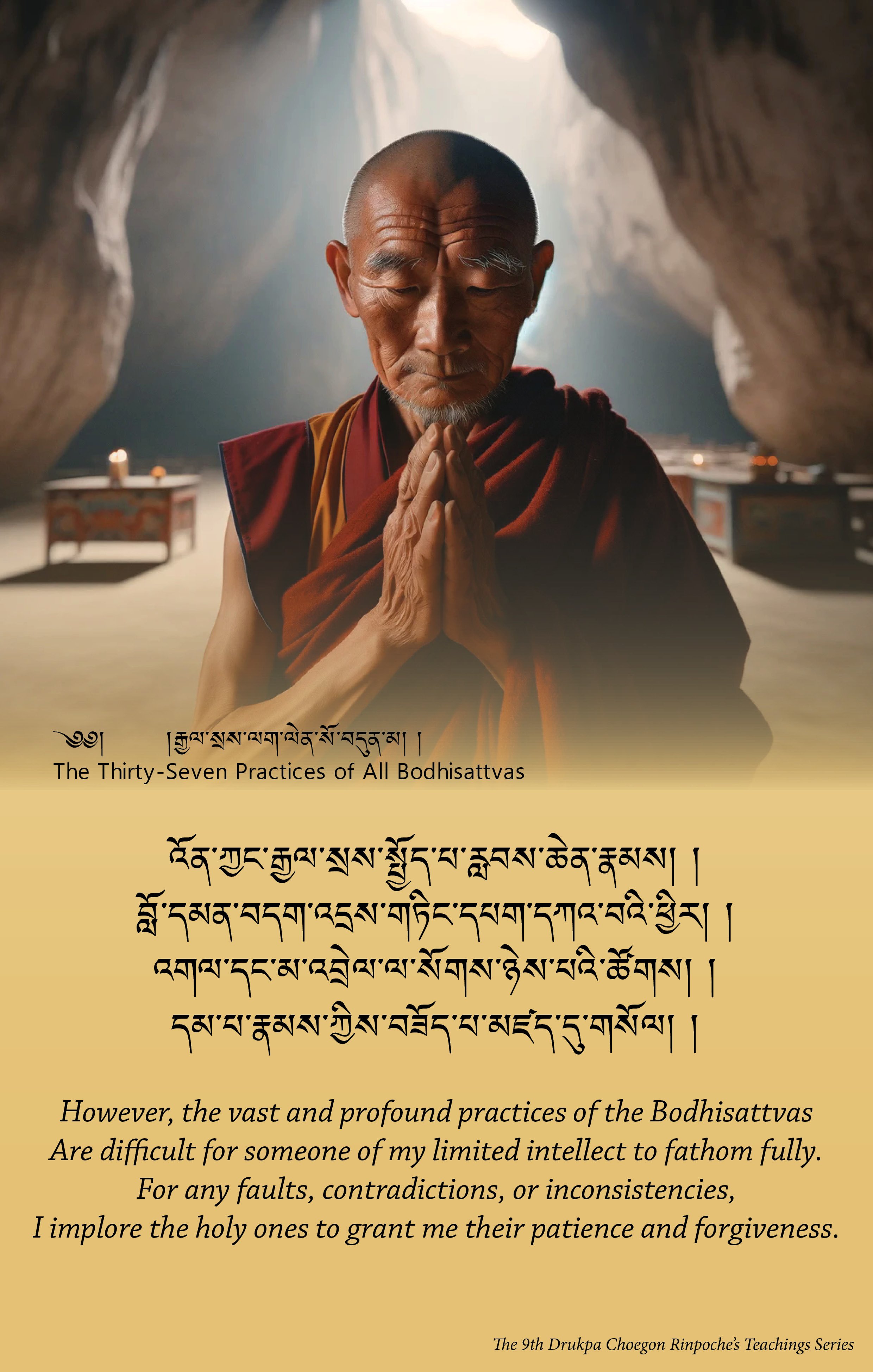
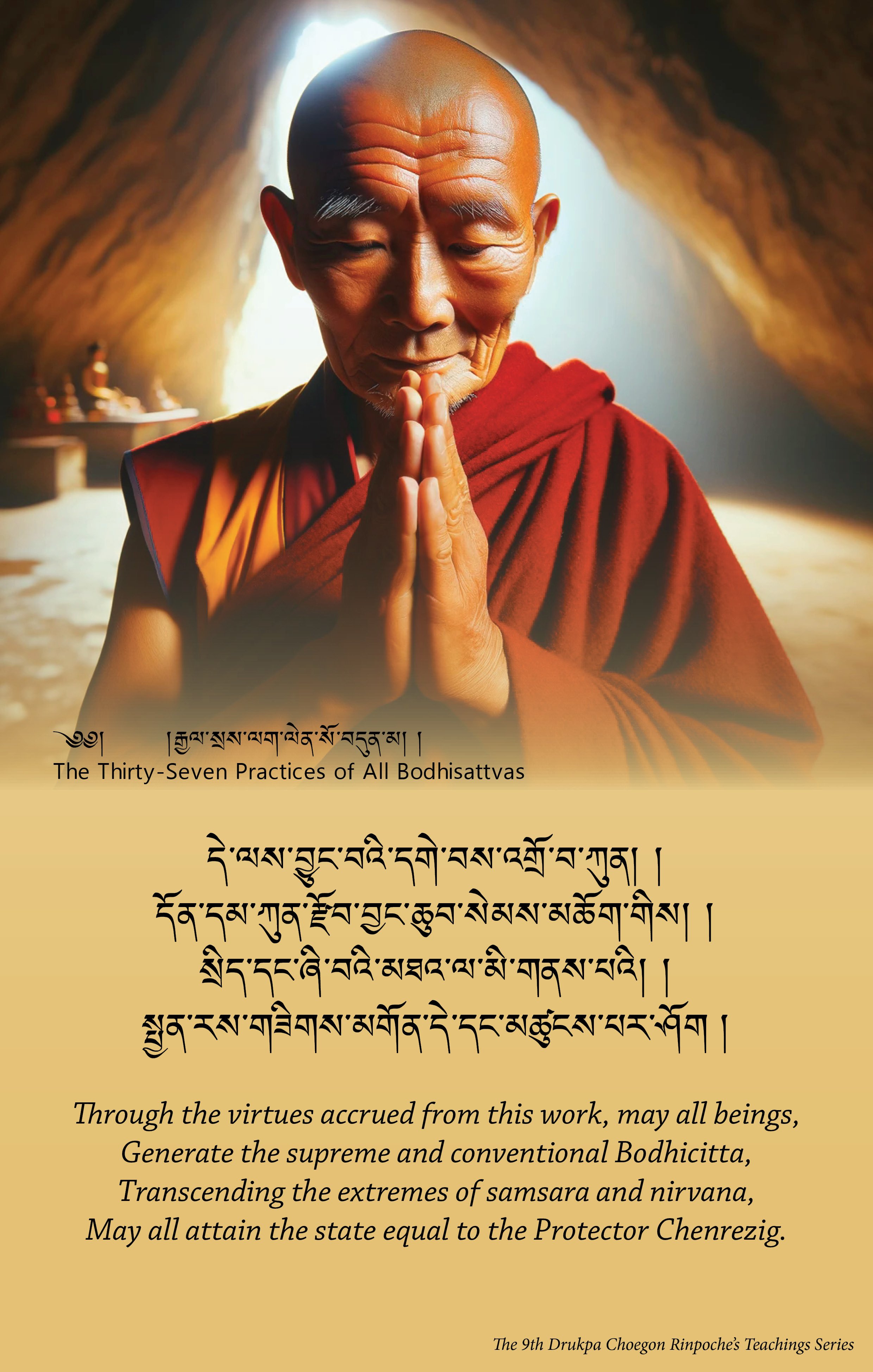
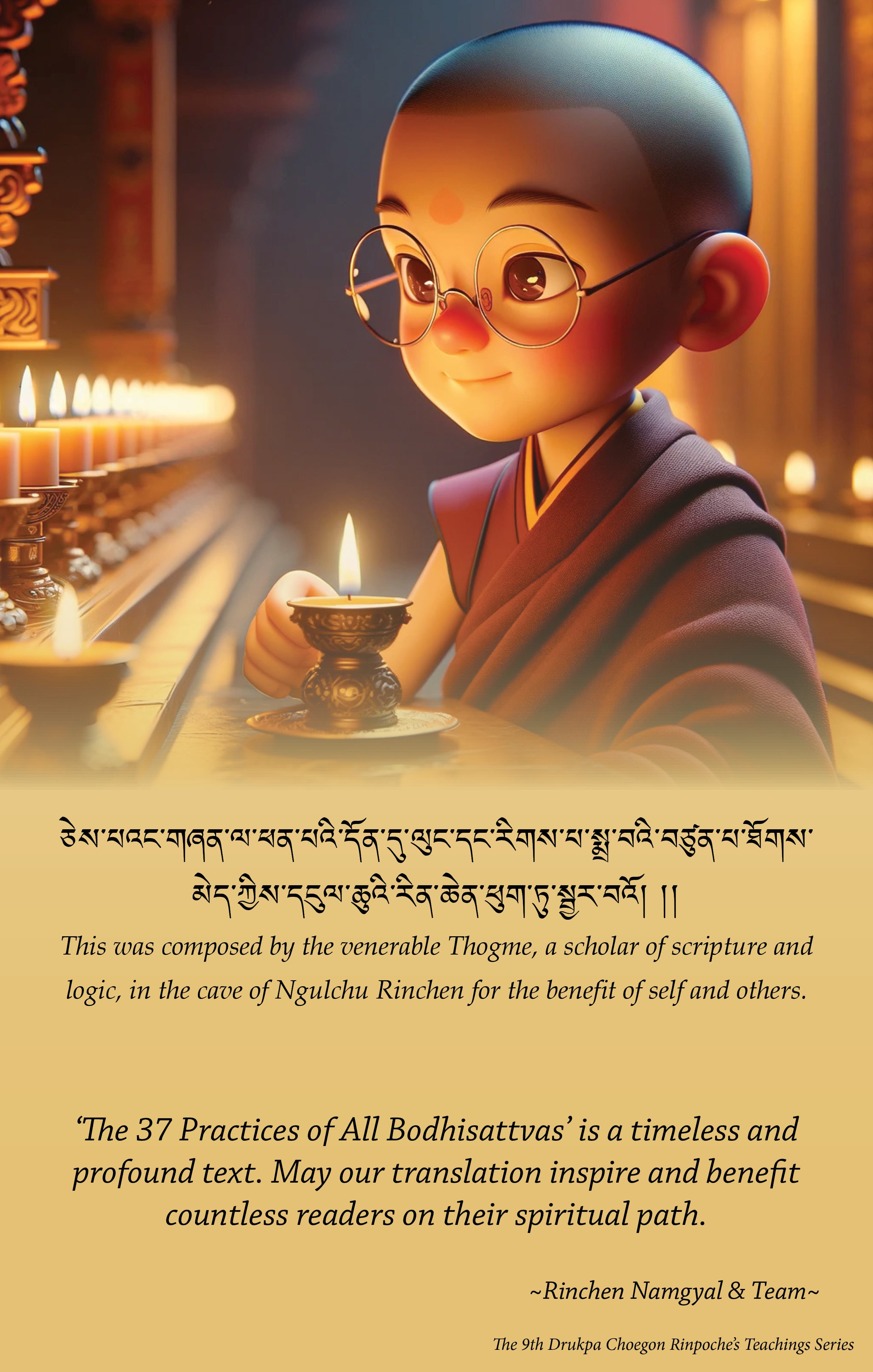
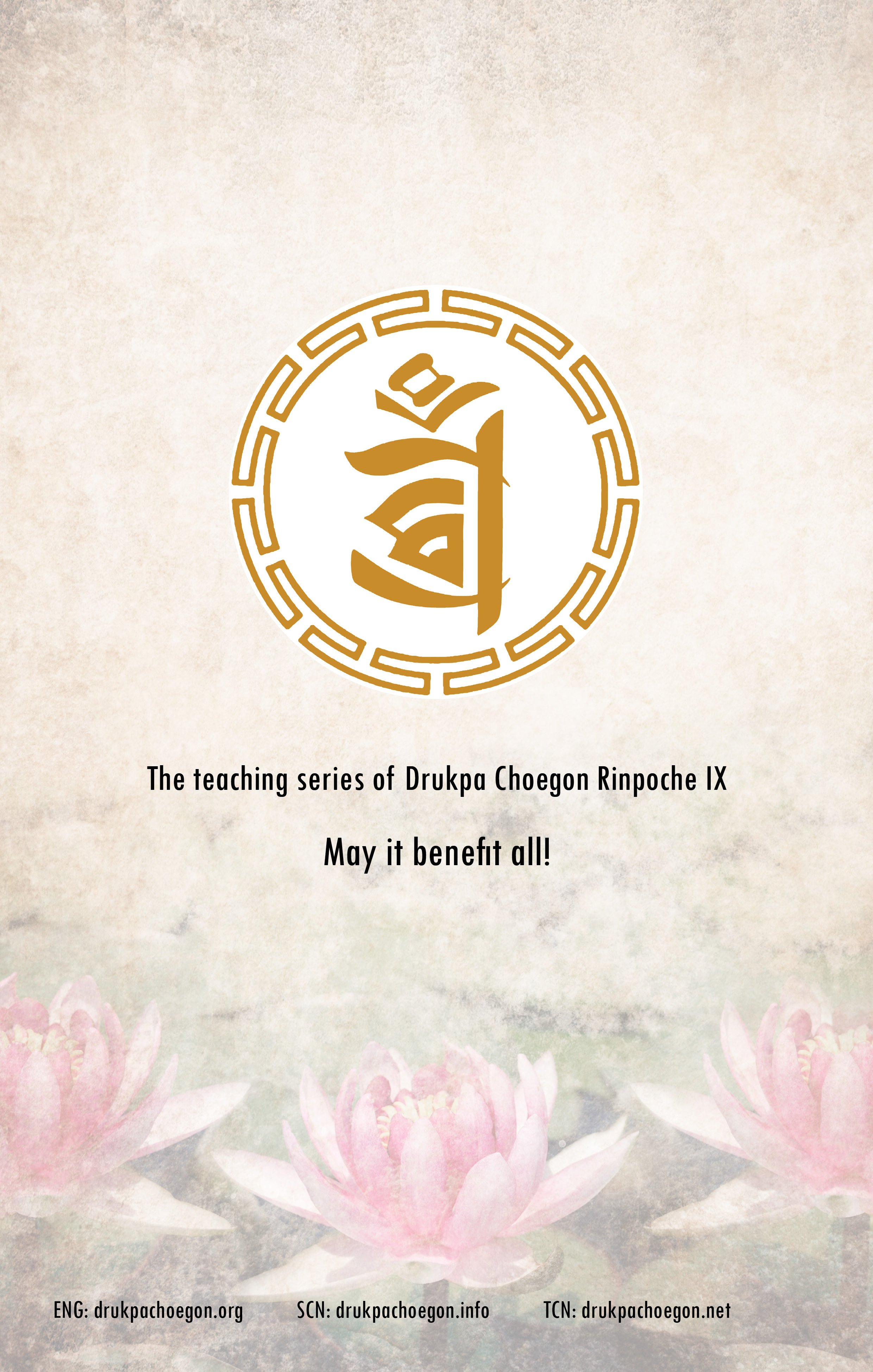
THE THREE COMPONENTS OF A BUDDHIST TEXT
All Buddhist texts follow a common structure, consisting of three sections: "The Introduction," referred to as "The Goodness of the Beginning," "The Main Body," known as "The Goodness of the Middle," and "The Conclusion," referred to as "The Goodness of the End."
"The Goodness of the Beginning" includes the title of the text, the salutation section, which expresses homage during translation, and the establishment of the intent. These three elements serve as the initial part of the text and are not considered the main content.
The Goodness of the Beginning:
-
The title allows readers to understand the content and purpose of the text at a glance, including whether it is exoteric or esoteric, and the content’s main direction. For instance, imagine having numerous medicines in our room without labels; it would be challenging to determine their specific purposes. Similarly, in Buddhism, there are 84,000 Dharmas expounded to counteract our 84,000 afflictions. These afflictions can be grouped into 21,000 types of greed, 21,000 types of anger, 21,000 types of ignorance, and an additional 21,000 types from the combination of greed, anger, and ignorance, adding up to a total of 84,000 afflictions.
The wise and compassionate masters have assigned names to these Dharmas, making it easier for practitioners to recognize which affliction each Dharma primarily addresses. This process is akin to labeling medicines, enabling practitioners to discern the purpose and function of each Dharma at a glance.
Through the tile, 'Thirty-Seven Verses on the Practice of a Bodhisattva,' we can understand that the content expounded is what all Bodhisattvas practice, outlined in thirty-seven essential points.
-
NAMO LOKESHVARA YA
Though realizing all phenomena are beyond coming and going,
Yet still you strive solely for the sake of countless beings,
Supreme guru inseparable from Avalokiteshvara,
With body, speech, and mind we prostrate at all times.
After discussing the title of the text, we move on to the salutation section. First, the phrase "NAMO LOKESHVARA YA" is in Sanskrit. "NAMO" means prostrate, " LOKESHVARA YA" refers to the Avalokiteshvara, and "YA” denotes the object.
There are several reasons for reciting the prostration verse in Sanskrit. First, it helps readers plant the seeds of opportunity to understand the Sanskrit language in the future. Second, since Buddha taught the Dharma through Sanskrit, we use the same language in our initial recitations to receive the blessings of Buddha's speech. Third, it signifies that this teaching is reliable and has valid sources, having been directly translated from Sanskrit to Tibetan, so retaining the original Sanskrit indicates its trustworthy origin.
Fourth, all Tibetan Buddhist teachings are translated from Sanskrit, and in terms of content, there is no difference between the two languages. Fifth, if the teachings had not been translated from Sanskrit to Tibetan, the Dharma would have been preserved only in Sanskrit. We can now access these teachings in Tibetan, and we should be grateful for the kindness of the translators of that time. Therefore, displaying the original Sanskrit text at the beginning is a way to express our gratitude for the translators' kindness. Based on these reasons, the Sanskrit text is used at the beginning of the text.
The first verse is a prostration verse, and the object of prostration is the guru, who is inseparable from Avalokiteshvara.
The teachings Buddha chose to expound are mainly divided into two categories: those spoken from the perspective of ultimate truth and those spoken from the perspective of conventional truth. Ultimate truth represents the actual nature of reality, the true essence, and is the manifestation of Buddha's omniscient wisdom, displaying genuine, non-deceptive, and non-illusory truth. Conventional truth refers to appearances (the way things manifest) and is the manifestation of Buddha's all-encompassing wisdom, showing deceptive and changeable phenomena. Many distinctions arise from the perspectives of ultimate and conventional truths, including definitive and provisional meanings. Ultimate truth is definitive and represents the inherent wisdom of Buddha's meditative equipoise; conventional truth is provisional and is spoken in response to ordinary beings' discriminative thoughts.
Only a guru inseparable from Avalokiteshvara can expound and express both ultimate and conventional truths.
"Though realizing all phenomena are beyond coming and going" means that the guru can perceive the essence of all phenomena. This essence is not subject to the changes of conventional truth. The guru can see it as it originally is. Although the guru can perceive the ultimate truth and abide in it, they generate great compassion within the realm of conventional truth to address the diverse needs of sentient beings. They tirelessly and diligently strive to guide all sentient beings.
A guru who possesses both ultimate and conventional truth is a supreme guru, called a "holy guru." This supreme guru is inseparable from the deity, Avalokiteshvara. We should always prostrate to the guru, who is inseparable from Avalokiteshvara, with our body, speech, and mind. This is the initial prostration verse.
When learning the Vajrayana path, we must understand that although Buddha has attained the peaceful Dharmakaya, the aspect of self-benefit, due to the power of his past aspirations for bodhicitta, he continues to manifest countless forms of rupakaya to benefit limitless sentient beings. These forms include the perfect Sambhogakaya and Nirmanakaya.
In order to benefit sentient beings, Buddha manifests as a wise and knowledgeable guru, especially in the era of degeneration, when beings are unable to see the Buddha directly. Thus, Buddha appears as a wise guru to guide and place his destined disciples on the path to liberation and enlightenment. The wise guru manifested through the Buddha's rupakaya is inseparable from the great compassionate Avalokiteshvara, and we constantly prostrate to this guru, who is one with Avalokiteshvara.
Therefore, the first verse is a praise, a way to make offerings to the guru and repay the guru's kindness through prostrations. The actual content is a prostration.
-
Perfect Buddhas – the source of all benefit and joy,
Arise through accomplishing the sacred Dharma,
And this, in turn, relies upon the full knowledge of their practice,
I (Thogme Zangpo) shall now explain “The Practices of all Bodhisattvas.
This verse is about establishing the intent. After reflecting on the great kindness of the guru guiding oneself onto the correct path of practice, how can one repay the guru's kindness? By generating an altruistic intention and composing this text. This is the author's mindset in establishing the intent, initiating an altruistic intention to write this text, and vowing to complete it well.
The first section of this book begins by outlining the main theme. It starts by explaining that the perfect Buddhas are the source of all benefit and joy. Our current happiness within samsara and the ultimate happiness of liberation and Buddhahood all originate from the Buddha. The Buddha is said to possess initial, intermediate, and final virtues, through which all present and ultimate happiness is accomplished.
Delving further, our happiness comes from the Buddha, but what is the origin of the Buddha? The Buddha has attained perfect Buddhahood through the correct practice of the Dharma. During the four stages of the path – the Path of Accumulation, the Path of Preparation, the Path of Seeing, and the Path of Meditation – the Buddha was even willing to sacrifice his own life for the sake of Dharma, devoting himself to the threefold training of hearing, contemplation, and meditation, in order to perfect the Methods and Wisdom of the teachings.
In terms of skillful means, explained from the perspective of Six Paramitas, it is covered by the first five practices: Generosity, Discipline, Patience, Diligence, and Meditative Concentration. These five are skillful means, while the practice of wisdom is the Prajnaparamita – the Perfection of Wisdom. Through the combination of hearing, contemplation, meditation, and the practice of both skillful means and wisdom, one can achieve the perfect state of Buddhahood. Therefore, it is said that one attains accomplishment through the practice of sacred Dharma.
How should the true Dharma be practiced? As a beginner, it is essential to understand the difference between the correct path and the mistaken path. By knowing the correct path, one can avoid falling into wrong or inverted practices. First, one should recognize the difference between the two, and then practice the Dharma accordingly. So, at the outset, those who want to learn the Bodhisattva's path should know how to practice it. That's why the author, Thogme Zangpo begins by establishing his intent to expound the correct path.
The Goodness of the Middle:
The main section of the text, known as the Goodness of the Middle, begins to unfold the thirty-seven essential points. It is further divided into preliminary practices, main practices, and concluding practices.
The preliminary practice, presented in the first seven verses, emphasizes the necessary preparations before embarking on the path of Dharma. These verses serve as a guide to lay the foundation for what lies ahead.
Transitioning to the main practice, we delve into the core teachings. This includes contemplation and cultivation of bodhicitta, the mind of enlightenment, as well as the observance of the bodhisattva vows. Additionally, it encompasses various aspects of learning and practice associated with the Bodhisattva path.
Lastly, in the concluding practice, there is a brief explanation of the paths for individuals of lower and intermediate capacities. In summary, the "37 Practices of Bodhisattvas" encompasses the content of the path for practitioners of the three levels – lower, intermediate, and advanced.
The Goodness of the Middle – I) Preliminary Practices
The journey begins with the preparation necessary for embarking on the Bodhisattva path, which is encompassed within the first seven verses. These seven verses outline the seven preliminary practices that are introduced in the main text of the Bodhisattva Path.
-
Having obtained this supreme vessel of leisure and endowment in this fortunate life,
We must strive to free ourselves and others from the ocean of samsara,
Day and night, unceasingly, without weariness or delay,
Hearing, contemplating, and meditating is the practice of Bodhisattvas.
How should we contemplate the significant rarity of attaining a human life endowed with the Eight Leisures and Ten Endowments? The first verse likens this precious human life, complete with the Eight Leisures and Ten Endowments, to a sturdy ship. This ship has the potential to carry us across the vast ocean of suffering toward the peaceful shores of a blissful pure land. This metaphor highlights the immense value and importance of our hard-to-obtain human existence.
Now that we possess this precious human life with all the necessary conditions, we have the capacity to accomplish both our own and others' benefits. Yet, we find ourselves deeply mired in the ocean of suffering. In order to attain eternal peace and to perfectly fulfill our aspirations for all virtues, we must diligently practice the Buddha's teachings. Our yearning should be as strong as that of a person who has been long starving and deeply craves food, or a person who has been long thirsty and yearns for a sip of water. Spurred by such intense desire, we must devote ourselves to the three studies of hearing, contemplating, and meditating on the Buddha's teachings, day and night, without idleness or wasting time. Only through such dedicated practice can we aspire to cross from the ocean of suffering to the other shore.
Hearing the Dharma in a human life endowed with the Eight Leisures and Ten Endowments is indeed very precious. These include the Eight Leisures and the Ten Endowments, five of which are personal endowments, and the other five are from others. Some of you may already be familiar with these, while others may not. While I won't delve into a detailed explanation here, it's important to note that no matter how extensively we discuss these leisures and endowments, it ultimately comes down to our personal understanding. The essence of Dharma is not just about listening, but it's about engaging in a continuous process of listening, contemplating, and practicing.
As Bodhisattva Maitreya taught, "We must first seek out a spiritual mentor and attentively listen to the teachings they expound. Yet, understanding should not stop at the point of hearing. We shouldn't feign understanding when we don't truly grasp the teachings, nor should we focus solely on listening without deeper contemplation." We need to question whether we might be misunderstanding something or whether our contemplation hasn't delved deep enough. This kind of self-reflection is crucial. Merely hearing and contemplating is not enough; ultimately, we must integrate these with meditative practice. As the Kadampa’s masters have warned, neglecting to practice after listening and contemplating leads us into a serious error: "The key points remain in the scriptures, the words linger on our lips, but our hearts fail to resonate with the essence of meditative practice." This is a grave mistake in our Dharma practice. Therefore, in recognizing the rarity and preciousness of human life with leisure and endowment, our earnest contemplation and inward meditation practice are of the utmost importance.
-
Attachment to loved ones stirred you up like swirling water,
Aversion to enemies, your flames of anger burn like fire,
In the darkness of ignorance, you forget what to adopt and abandon,
Giving up your homeland is the practice of Bodhisattvas.
Objects of affection in our hearts, often relatives and those we hold dear, can agitate our minds, much like the turbulence of boiling water. When we harbor anger or resentment towards someone, our minds can be likened to a raging fire, filled with seething fury. This illustrates the manifestations of desire and anger. Ignorance refers to our inability to distinguish what actions should be embraced and what should be avoided. So, what should we do? We need to adopt the ten virtuous actions and abandon the ten unwholesome ones. Forgetting these principles of discernment is a sign of ignorance. Furthermore, when we act without mindfully observing our actions or fail to bring ourselves back when our thoughts stray, we're in a state of mindlessness, which is also a form of ignorance.
The primary reason our minds are immersed in the darkness of desire, anger, and ignorance often lies in negative environments. These are places that lack peace, like our hometowns, where gossip and rumors run rampant. When we encounter such conditions, we need to be determined to let go, just as urgently as a person would distance themselves from the source of a contagious disease. Therefore, we must urgently abandon and step away from any environment that might fuel our greed, anger, and ignorance.
There are countless examples throughout history that reinforce the truth of this verse. Many practitioners encountered obstacles in their spiritual journey due to their attachments to family and friends. This is why the Buddha left his royal palace for a life of asceticism, ultimately attaining perfect Buddhahood. Our hometowns — places that give rise to our desires and anger — can be obstacles in our spiritual practice. Hence, historically, many monks have chosen to leave their familiar environments to seek solitude in the mountains for their spiritual practice.
Take, for example, the revered Milarepa. His love for his mother was so strong that when his aunt and uncle mistreated her, he recklessly learned and used malicious curses against his relatives, killing many and creating a lot of negative karma. All of this stemmed from his intense attachment and love for his mother. Eventually, he left his hometown and met his esteemed teacher Marpa. This encounter led to a profound realization of his negative actions, which drove him to diligently practice the Dharma.
Later, when thoughts of his hometown crossed his mind, he returned, only to find his mother had passed away and his home was deserted. At that poignant moment, he completely renounced this life and retreated to the mountains to practice earnestly and, ultimately, attained the union form of Vajradhara within his very lifetime.
These examples illustrate how our failure to let go of desire and anger can obstruct our spiritual practice, thereby reinforcing the teachings in this verse. We can learn from these accounts that detaching ourselves from such detrimental emotions is essential for our spiritual progress.
-
By distancing from troubling objects, disturbing emotions gradually decrease;
Without distraction, virtues naturally increase;
With clarity of mind, conviction in dharma arises;
Dwelling in seclusion is the practice of Bodhisattvas.
The previous verse discussed harmful places or environments. So, what kind of environment is beneficial to us? It's a serene and tranquil place, away from the hustle and bustle, a locale praised by both Sutrayana and Tantrayana. By anchoring ourselves in such serene surroundings, our distractions naturally fade, and our faith in the Dharma, as well as our compassion, loving-kindness, and Bodhichitta, naturally grow.
Our minds are an eternal battleground where good and evil constantly contend. In a peaceful environment, destructive emotions like greed and anger cease to proliferate unchecked. As the negativity within us recedes, virtues that stand in opposition naturally grow. When goodness dominates, evil retreats; when goodness wanes, evil escalates. Conversely, when evil prevails, goodness diminishes. By distancing ourselves from environments that nurture evil thoughts, their influence weakens, and guided by the principles of dependent origination and natural laws, various virtuous qualities within us naturally flourish.
Therefore, it's stated here that when we distance ourselves from negative places, our confusion, ignorance, and afflictions naturally lessen. Merits of goodness, such as diligence, faith, and compassion, naturally arise in our minds. Our faith in the Dharma strengthens, and our understanding of its principles and rules sharpens. Hence, serene environments are beneficial, and we should seek and rely on them.
In this verse, the emphasis is placed on the tranquility of the environment. Pertaining to practice, according to Patrul Rinpoche, tranquility encompasses the threefold tranquility of the body, speech, and mind.
Physical tranquility involves abstaining from frequently immersing ourselves in bustling, crowded environments or attending numerous gatherings and social events. Even if a retreat to the mountains for practice isn't feasible, we can still cultivate physical tranquility within the city by refraining from frequent gatherings and avoiding distracting activities.
Verbal tranquility entails avoiding the expenditure of energy on meaningless talk. At home, we can recite mantras and sutras. Even when we are not engaging in the recitation of sutras or mantras, we should abstain from pointless conversations. From the Tantric perspective, speaking is a form of karmic energy. When this energy is engaged, our inherent wisdom-energy transforms into karmic energy. Consequently, we fail to nurture our inherent wisdom-energy and to conserve our strength. To practice verbal tranquility within the city or at home, we should often observe silence, refrain from meaningless speech, and consider reciting mantras or sutras when possible. As Patrul Rinpoche taught, even if we inhabit a mountain retreat (a peaceful place), we can't accrue the merits of such a tranquil place without achieving verbal tranquility.
Mental tranquility is maintaining a mind that's continually in a state of meditative concentration, free from distractions and delusive thoughts.
The true meaning of tranquility is to distance ourselves from objects that incite greed and anger. Understanding the meaning of tranquility does not imply that we must retreat and live in the mountains. Rather, we should isolate ourselves from triggers of desire and anger within our environment, thus preventing excessive disturbances to our body, speech, and mind and enabling practice in a serene environment.
If we lack a genuine understanding of tranquility, even a mountain retreat wouldn't benefit us. We may waste much time in idle chatter, remain in a distracted state, and be swarmed by delusive thoughts. Some people may seclude themselves in the mountains, their doors shut, but their minds may be more overrun with delusive thoughts than when they resided in the city. This is due to a lack of a genuine understanding of tranquility. Therefore, it's essential to comprehend that tranquility includes physical tranquility, verbal tranquility, and mental tranquility. These three aspects should be kept in mind, and when we speak of relying on a tranquil environment, we should incorporate them into our practice.
In summary, to genuinely benefit from a peaceful environment, we must understand and incorporate the principles of tranquility into our daily lives. This means practicing physical tranquility by avoiding overly stimulating environments, verbal tranquility by refraining from meaningless chatter and focusing on reciting mantras or scriptures, and mental tranquility by maintaining a concentrated, meditative state of mind. By integrating these facets of tranquility into our practice, we'll be better equipped to cultivate our inherent wisdom, deepen our faith in the Dharma, and naturally foster our virtuous qualities.
-
Long-accompanying friends and family will inevitably part;
Wealth and possessions, amassed with much effort, will be left behind.
Consciousness, the guest, will eventually leave the guesthouse of the body.
To renounce fleeting worldly concerns is the practice of Bodhisattvas.
This verse speaks of the need to renounce this ephemeral life. If we can't relinquish our worldly habits and pleasures while practicing the Dharma, they become significant hindrances on our spiritual journey. As such, truly practicing the Dharma requires a renunciation of this life.
Cultivating a mindset of renunciation calls for a profound contemplation of life's impermanence, which can be understood through these three key aspects:
1. The timing of death is uncertain – no one can truly foresee when their end will come.
2. The cause of death is uncertain – countless factors could potentially lead to our demise.
3. Death is the sole inevitable truth – it's a destiny that no one can escape.
Reflecting on our existence through these three perspectives allows us to grasp the transient nature of life and the inevitability of death.
Reflect upon our worldly possessions. Every tangible thing we gather is bound to be depleted – all accumulation will inevitably diminish. All our treasured relationships, be they friendships, family bonds, or other kinships, are fated to dissolve – every union will unavoidably lead to a parting. Life, in its natural course, always leads to death – every birth is destined to die. These are the truths repeatedly emphasized by the Buddha in his teachings. To us, this life is but a fleeting moment. Thus, by meditating on impermanence, we can foster a mindset of renunciation towards this life."
Next, reflect upon our worldly possessions. Every tangible thing we gather is bound to be depleted – all accumulation will inevitably diminish. All our treasured relationships, whether friendships, family bonds, or other kinships, are fated to dissolve – every union will unavoidably lead to a parting. Life, in its natural course, always leads to death – all birth destined to die. These are the truths repeatedly emphasized by the Buddha in his teachings. To us, this life is but transient. Thus, by meditating on impermanence, we can foster a mindset of renunciation towards this life.
Among the profound teachings bestowed by Lord Manjushri to Sakya Pandita Kunga Nyingpo, there's a renowned doctrine called "Parting from the Four Attachments", which states:
If one is attached to this life, they are not a true practitioner.
If one is attached to samsara, they lack renunciation.
If one is attached to their own self-interest, they have no bodhicitta.
If there is grasping, they do not possess the View.
It's important to strive to relinquish these four attachments. Specifically, the first principle explicitly declares that if one remains attached to this life, one cannot be regarded as a genuine practitioner.
Likewise, in the renowned "Four Dharmas of Gampopa”:
Grant your blessing so that my mind may turn towards the Dharma.
Grant your blessing so that Dharma may progress along the path.
Grant your blessing so that the path may dispel confusion.
Grant your blessing so that confusion may dawn as wisdom.
The essence of the first Dharma in Gampopa's teachings, 'May my mind turn towards the Dharma', is to encourage us to relinquish our attachment to this life. One way to aid us in this renunciation is to meditate on impermanence. By ceaselessly reflecting on the immutable truth of impermanence, our attachments to this life will gradually diminish, eventually enabling us to let go.
This meditation on impermanence primarily serves to highlight the transient nature of our current life, indicating its ultimate meaninglessness, thereby assisting us in letting go. How does it become meaningless? As the verse reveals, relationships we diligently maintain, such as those with family and friends, are destined to face separation when impermanence strikes. As a result, "long-accompanying friends and family will inevitably part" – no matter how much we resist, the inevitability of death forces us to let go. "Wealth and possessions, gathered with great effort, will be left behind" – we toil to build wealth, always dreaming of the day when we can fully enjoy it, yet impermanence may come before we get the chance, facing us with death. At that moment, we realize that all our efforts in accumulating these material goods bear no significance in the face of death.
How should we perceive our own bodies? We should consider them as temporary dwellings, akin to guesthouses. Everyone harbors a deep attachment to their body, endeavoring to keep it healthy, but the body is merely a transient residence for our consciousness. When the inevitability of death manifests, our consciousness will transition to another destination. Consequently, all our strivings in this life become insignificant in the face of death. This realization encourages us to relinquish our attachment to the transient pleasures of this life.
What is the purpose of our precious human life, complete with the Eight Leisures and Ten Endowments? Fundamentally, its purpose is to serve as a tool enabling us to practice the Dharma. Through the conduit of this human life, we can achieve spiritual evolution. While this is indeed beneficial, we should not develop any attachment to the body.
-
When in their company, your three poisons surge,
Your efforts in hearing, contemplation, and meditation begin to falter,
And love and compassion are at the edge of a complete fade,
Distancing evil friends is the practice of Bodhisattvas.
This verse underscores the importance of distancing oneself from harmful associations. Evil friends can be compared to patients infected with a highly contagious plague; when we encounter them, we instinctively strive to avoid them to prevent infection. Similarly, if we knew of a region known for its frequent visitation by dangerous animals, our immediate instinct would be to keep our distance. This mindset should likewise be applied when dealing with evil friends.
The teachings of the Kadampa highlight that harmful companions can exert a profoundly negative influence on us. An otherwise ordinary individual, when guided by a wise and virtuous mentor, could transform their negative tendencies under this mentor's influence and evolve into a good practitioner. Conversely, a virtuous practitioner persistently associating with harmful companions could find their accumulation of merit stalling, and over time, their existing merit may gradually diminish due to this negative influence, resulting in a progressive deterioration of their virtue.
To illustrate this, imagine a piece of white cloth. If it's placed next to a fire for a day, it might not show much change. However, if it stays there for a month, it would inevitably turn grey or even black. The influence of evil friends is similar. Encountering such individuals for a day or two might seem inconsequential, but over time, their impact can only worsen our moral character, hindering the growth of our spiritual merits.
As we traverse the path of spiritual growth, it is imperative to mindfully scrutinize our associations. When it comes to evil friends, we should sever the ties immediately, without the slightest hesitation.
-
Relying upon them, your faults are completely exhausted,
And your virtues grow like the waxing moon.
Esteem the supreme Guru even more than your own body,
Cherishing them dearly is the practice of Bodhisattvas.
Relying on a virtuous spiritual mentor can lead to a significant enhancement of our meritorious deeds. As the Buddha declared, such reliance brings our inherent virtues into prominence, and under the mentor's guidance, new virtues previously unrealized start to gradually emerge. The mentor's guidance also helps in reducing our negative actions, thereby ensuring we do not fall into the three lower realms in the future. Moreover, this guidance continually sows seeds of virtue within our hearts.
The phrase, "Relying upon them, your faults are completely exhausted," implies that by relying on our Guru or virtuous spiritual mentor, we can gradually purify our past negative karma. As we abstain from negative actions, our virtues flourish, much like the waxing moon. With the virtuous mentor's constant guidance, our positive qualities continue to expand. Consequently, we should hold such invaluable mentors in even higher esteem than our own bodies. Cherishing such mentors nurtures our continuous growth in virtues. This is a fundamental practice of all Bodhisattvas.
In the context of Vajrayana, the virtuous mentor refers to the Guru who imparts the Tantrayana teachings. Conversely, in Sutrayana, the object of refuge is the ordained monks or Acharya. Whether it's the Guru in Vajrayana or the refuge master in Sutrayana, their teachings should guide our actions. We should strive to accomplish what our Guru or Acharya advises. With this mindset, we approach and rely on them, our virtuous mentors. Buddhist scriptures clearly state that during the degenerate age, the Buddha manifests in the form of Gurus or virtuous mentors to benefit sentient beings. Therefore, in accordance with the teachings of the Buddha, we should rely on these Gurus or virtuous mentors.
Recognizing that some people may not be able to attend teachings in person in the future, they have made an earnest request for oral transmission, enabling them to learn from recorded teachings later. However, oral transmission and teachings are two distinct things. Even after receiving the oral transmission, further guidance or instructions should still be sought. Ideally, one should receive oral transmission in person from the Guru, followed by direct, face-to-face instruction or guidance.
What does instruction mean in Tibetan Buddhism? It's a form of guidance, leading one toward a better state or place. For instance, when the great translator Marpa was instructing Milarepa, where was he guiding him? He was guiding him towards the fruition of the state of the union form of Vajradhara – the highest attainment in Vajrayana. Who was the guide? The esteemed Marpa Guru guided his disciple, Milarepa. How did he guide him? He did so through the skillful means of ripening empowerments and liberating instructions. Therefore, guidance holds paramount importance in the learning and practice of Dharma, particularly in Vajrayana.
-
While they themselves are still trapped in the prison of cyclic existence,
To whom can the worldly gods truly offer help?
Therefore, relying solely on the undeceiving protectors,
Taking refuge in the Three Jewels is the practice of Bodhisattvas.
Now let's discuss the aspect of taking refuge. Taking refuge is an essential foundation of all Buddhist teachings. Without taking refuge before engaging in Dharma practice, we will not receive any precepts, and we will not embark on the path of practice. As the source of precepts is refuge, we must first take refuge, and then we can seek and uphold the precepts.
The Five Paths and Ten Bhumis that we traverse begin with taking refuge, and refuge is the foundation of all paths to Buddhahood. Therefore, without taking refuge, any form of practice cannot be considered as entering the “Path of Practice”. Thus, taking refuge is of utmost importance.
The distinction between Buddhism and non-Buddhist paths:
Furthermore, the primary difference between Buddhism and non-Buddhist paths is determined by taking refuge. We identify someone as a Buddhist because they have taken refuge. It is through taking refuge that we categorize ourselves as Buddhists. Thus, taking refuge is a crucial part at the outset of our learning of Buddhism.
When taking refuge, different people will have different objects of refuge. Some people take refuge in the mountain god, some in the water god, some in the worldly gods, some in the Naga King, or some people specifically worship a stone-made deity, which they regard as their reliance and object of refuge.
Why are there all kinds of objects of refuge? Due to ignorance, many people, not understanding the concept of refuge, pray to various entities. The Buddhist scriptures mention that when we are in pain, we may turn to divine beings like Naga Kings or deities for relief. However, in reality, these beings cannot completely eradicate our suffering. While they may provide a temporary respite from our pain, they are incapable of permanently freeing us from our suffering, and hence, are not our ultimate refuge.
The main reason for this is that these worldly deities or Naga Kings are themselves still trapped within the cycle of existence in the Three Realms, and they cannot even resolve their own suffering. Thus, they are incapable of liberating us from the cycles of birth, death, and rebirth, and cannot lead us to the complete cessation of suffering.
Taking refuge in the Three Jewels - the Buddha, the Dharma, and the Sangha:
The only true object of refuge that can liberate us from the suffering of cyclic existence is the Three Jewels, i.e., the Buddha, the Dharma, and the Sangha. They are our sole reliance for refuge.
Let's start with a brief introduction to the Three Jewels. The Buddha does not possess the feelings of favoritism and discrimination that ordinary people have. The Buddha only has compassion for all sentient beings, without attachment or aversion. He continuously benefits all sentient beings with a compassionate heart. He does not differentiate by saying this one is a Buddhist, so I'll take special care of them, or this one is not a Buddhist, so I won't show them compassion. The Buddha has no such discrimination, instead, he shows universal compassion. The Buddha's ability to benefit all sentient beings without bias is one of his defining traits. Moreover, the Buddha possesses immense power, which is his ability to alleviate completely the suffering of Samsara. He is endowed with both mundane and transcendental virtues, the latter of which pertains to Nirvana. He is imbued with all the extraordinary virtues beyond this world.
Thus, such an entity, capable of continuously and impartially benefiting all sentient beings, possessing the power to transcend the pain of Samsara, and endowed with all the virtues of Nirvana, cannot be found in any other object of reliance, other than the Buddha. Therefore, when we seek an object of true reliance, even though Buddhists take refuge in the Three Jewels, the primary object of refuge is the Buddha.
When discussing the aspect of taking refuge, we can delve into its essence, distinctions, and benefits, among other aspects. But in simple terms, we take refuge in the Three Jewels: The Buddha, the Dharma, and the Sangha.
The Buddha Jewel refers to the inherent nature of the Buddha, who possesses the three kayas: The Dharmakaya, Sambhogakaya, and Nirmanakaya. The Buddha possesses ‘The Wisdom that Knows the Nature of All Phenomena’ and ‘The Wisdom that Knows the Multiplicity of Phenomena’. His wisdom is perfect, and he has the Dharmakaya for self-benefit and the Sambhogakaya and Nirmanakaya for the benefit of others.
The Dharma Jewel refers to the teachings expounded by the Buddha and the intentions within the Buddha's mind. This is the true Dharma. As mentioned before, it includes both the ‘Dharma of Realization’ – the realization of truth within the mind, and the ‘Dharma of Instruction’ – the teachings expressed through words. This is what we call the Dharma Jewel – The enlightenment in Buddha's mind and his guidance and teachings through words.
The Sangha Jewel refers to those who earnestly practice and follow the teachings proclaimed by the Buddha, adhering to his words and implementing them. The term 'Sangha' typically refers to the Noble Sangha, meaning those who have reached the state of enlightenment. In Mahayana Buddhism, this refers to attaining the Bhumis (reaching the level of a bodhisattva), and in Theravada Buddhism, it refers to achieving the Four Fruition (the Four Levels of Awakening). These are the individuals to whom we can turn for refuge.
As mentioned earlier, the real and only object of our refuge is the Buddha Jewel, which actually encompasses all Three Jewels - the Buddha, the Dharma, and the Sangha. The Buddha's body represents the Sangha Jewel; his teachings, the Dharma Jewel; and his mind, the Buddha Jewel, that is, the Buddha himself. Therefore, while we take refuge in the Three Jewels, they can all be embodied in the Buddha Jewel.
A Buddha, possessing such perfect virtues, surpasses any worldly deities. Therefore, in the Root Verse of the Thirty-Seven Practices of a Bodhisattva, it is said: "While they themselves are still trapped in the prison of cyclic existence, to whom can the worldly gods truly offer help? Therefore, recognizing the truly exceptional and unerring refuge, taking refuge in the Three Jewels is the practice of Bodhisattvas." This tells us that a Buddha, as one who embodies perfect virtues, is entirely incomparable to worldly gods who themselves are still within the cycle of Samsara. Therefore, we must take refuge in the unerring Buddha, who embodied the Three Jewels of Buddha, Dharma, and Sangha.
The Buddha serves sentient beings in manifold ways, one of which is his manifestation as a spiritual teacher. Especially in the degenerate age, when sentient beings cannot see the Buddha in person, the Buddha will appear in the form of a spiritual teacher, guiding those disciples with a karmic connection towards the path to liberation and ultimate Buddhahood.
-
The Dharma is categorized into the Dharma of Instruction and the Dharma of Realization:
The teachings of Shakyamuni Buddha primarily divided into two categories: the “Dharma of Instruction” and the “Dharma of Realization”. The former pertains to the spoken teachings, while the latter involves the internal realizations. The Dharma of Realization refers to the ultimate truth, embodied by the Buddha, who possesses both 'Wisdom that Knows the Nature of All Phenomena' and 'The Wisdom that Knows the Multiplicity of Phenomena'. This signifies a complete understanding of the nature and characteristics of all phenomena. Furthermore, the innate wisdom that arises within a Bodhisattva during meditation also constitutes the Dharma of Realization.
The Dharma of Realization transcends language, thought, and all conventional explanations. It encapsulates the wisdom of the Buddha and denotes the ultimate truth, reflecting the true Dharma in its most authentic sense. This reality lies beyond descriptive, differentiative, or intellectual understanding. However, to engender the Dharma of Realization or the ultimate truth in our minds, the Buddha provided a variety of guidelines and instructions. These teachings, expressed in speech and text, are collectively termed the Buddha's Dharma of Instruction.
The Buddha's Dharma of Instruction consists of teachings directly articulated by the Buddha, teachings endorsed by the Buddha, and teachings blessed by the Buddha. The teachings spoken directly by the Buddha are his personal pronouncements; the teachings endorsed by the Buddha are those are those that were spoken by others and affirmed by him. The blessed teachings are delivered by disciples expressing the Buddha's intentions through his blessings. Collectively, they are referred to as the Buddha's words or scriptures (Sutra).
Commentaries, known as treatises (Shastra), elucidate the Buddha's teachings and are authored by past great masters and scholars. Therefore, the Dharma of Instruction encompasses two parts: the Buddha's words (Sutra) and the treatises (Shastra).
Considering both the Buddha's words and the treatises written by eminent past masters, the Buddha's words stand out for their profound depth and supreme exceptionality, devoid of any confusion. As they are the Buddha's own utterances, they present a comprehensive understanding of everything, making them supremely authentic. On the other hand, treatises authored by renowned past masters like Nagarjuna, Asanga, Candrakīrti, and others are unparalleled in their wisdom and insight.
The Three Necessary Conditions for Writing Treatises:
When discussing the authors of treatises, we can categorize them into two groups: those who are Bodhisattvas that have attained the stages (Bhumis) and those who have not yet attained this level of realization.
Great Bodhisattvas like Nagarjuna, who have perceived the ultimate truth of the nature of reality, naturally compose treatises of significant value. However, treatises authored by Bodhisattvas who have not reached the Bhumis also exist. The key distinction is between those who are still within the realm of ordinary beings and those who have ascended to the realm of holy beings.
Generally, there are three necessary conditions for authoring treatises. At the highest level, one must be able to personally perceive the emptiness of the nature of phenomena. If this is unattainable, the intermediate requirement is to personally perceive one's Yidam deity and obtain their permission. At the most basic level, one must have a thorough mastery of the five sciences. Authors must meet at least one of these conditions to compose a treatise.
The Buddha's words and treatises both hold immense value. The words of the Buddha are extraordinarily profound, as seen in the essential and deep content of the "Diamond Sutra" or the "Heart Sutra". When we are unable to understand the Buddha's intent directly, we can gain insight into the Buddha's words by studying the treatises written by esteemed masters.
Therefore, the core content we aim to comprehend is the teachings given by the Buddha. We learn the content and purpose of the Buddha's teachings through the explanation and elucidation in treatises.
What can truly Eliminate Suffering and Quell Disturbing Emotions is the True Dharma
Regardless of whether it is the Sutra or Shastra, the real Dharma needs to be understood in a particular light. But what exactly is the Dharma? The primary purpose of the Dharma is to eradicate all forms of suffering and pacify all sorts of afflictions and obstacles. Therefore, for practitioners, when they cultivate the Dharma, it should serve to pacify and eliminate their inner suffering and keep them away from afflictions. If the practice can achieve this goal, then we recognize it as the Dharma, or the true Dharma. However, if the practice only seems to intensify the suffering or if the afflictions become increasingly strong, then this cannot be considered Dharma.
As previously mentioned, within the Dharma, there are two categories: the Dharma of Instruction and the Dharma of Realisation. The content we are currently studying pertains to the Dharma of Instruction. Within this Dharma of Instruction, there are the teachings of the Buddha and the treatises of the great masters. The treatises are further divided into those written by the great Indian masters and those written by the great Tibetan masters. Currently, we are studying treatises written by Tibetan masters. There are many great masters in Tibet, and our present study focuses on the writings of Thogme Zangpo. His work discusses how a practitioner enters the Mahayana Bodhisattva Path and how they put the practices of a Bodhisattva into action. This is summarized into thirty-seven points, known as "The 37 Practices of Bodhisattvas."
-
External and Internal Refuge
Refuge in Buddhism can be divided into external refuge, internal refuge, and secret refuge. However, in "The 37 Practices of Bodhisattvas," the primary focus is on exoteric teachings, and therefore it doesn't delve into the detailed distinctions found in Vajrayana. Let's briefly discuss these aspects of refuge here.
External refuge refers to taking refuge in the Three Jewels: Buddha, Dharma, and Sangha, which is a form of outward refuge.
Internal refuge, as expounded in Vajrayana, is taking refuge in the Three Roots: the Guru as the root of blessing, the Deity as the root of accomplishment, and Dakini and Dharmapala as the roots of activities. These form the objects of internal refuge.
Recognizing Our True Nature is Ultimate Reliance – The Secret Refuge
In practical terms, the refuge we often speak of is the act of seeking support when faced with pain and threats. In confronting the suffering of samsara, we seek the path of liberation and thus look towards the Three Jewels of Buddha, Dharma, and Sangha for guidance. However, the ultimate form of refuge – the secret refuge – arises when our mind recognizes its own nature, understands the principle of emptiness inherent in all phenomena, and embarks on a practice grounded in this understanding of emptiness. This enables us to attain a state of ease in all circumstances, and represents our actual, true reliance.
This ultimate reliance is not on an external guru or the Three Jewels but rather on realizing the inherent emptiness within our own mind. From a Vajrayana perspective, this refers to the recognition of our own nature and the wisdom that emerges upon reaching a Bhumi (stage of enlightenment). From the first Bhumi to the tenth, and ultimately to the eleventh Bhumi of Buddhahood, there is a progressive deepening in the understanding of emptiness. This forms the core of our reliance, the ultimate refuge. Therefore, in the secret refuge, we take refuge in the realization of our own nature in relation to emptiness.
Mahamudra talks about the recognition of our bare nature as our ultimate reliance. Dzogchen speaks about the mind: its essence is empty, its nature is luminous, and its ground is all-pervasive compassion. By realizing this union of emptiness and compassion within our own minds, we can attain liberation from all forms of suffering. Both teachings elucidate the Tathagatagarbha, the Buddha-nature that is inherently present within all sentient beings. By fully manifesting the merits of the Tathagatagarbha and actualizing them in practice, we realize what is known as the ultimate refuge, also referred to as the secret refuge.
The Most Exceptional Aspect of Taking Refuge in Buddha Compared to Other Religions
We say that we take refuge in Buddha and enter Buddhism because we understand the exceptional and perfect virtues of Buddha, and that Buddha is our ultimate reliance. However, if that's all there is to it, other religions also have similar assertions. They would also say that the entity they take refuge in and rely on is more exceptional and perfect than others. So, what exactly are the unique points and characteristics of the Buddha, our object of refuge and reliance?
Merely claiming superiority over other religions verbally is meaningless. The Buddha's teachings require us to understand and recognize them, then practice and gain benefits from them. Only then can we say that Buddhism is indeed exceptional and indeed our best reliance, the entity we solely rely on.
When compared with other religions, the distinguishing feature of Buddhism can be understood from the Four Seals of Dharma, which are:
1. All conditioned things are impermanent – everything is in a state of impermanence, it changes;
2. All tainted things bring suffering – everything in this world will ultimately perish, and their final result brings us pain;
3. All phenomena are devoid of self – all phenomena are empty and lack inherent existence;
4. Nirvana is peace – the ultimate liberation can be attained.
The Four Seals originate from the teachings expounded by the Buddha after realizing that the essence of all phenomena is emptiness.
Because everything is a manifestation of emptiness, all appearances of things are an embodiment of impermanence, and impermanence leads to suffering. However, its essence is devoid of self and lacks inherent existence, it is emptiness, and through realizing it, we can attain the peace of nirvana.
Therefore, all phenomena are manifestations of the content of emptiness. We need to recognize and understand it, then practice diligently to gain the benefit of eliminating suffering. The ability to attaining complete liberation from suffering is the distinct difference between our exceptional object of refuge and other religions, and also where Buddhism differs from other religions.
The Goodness of the Middle – II) Main Practices
The following main practice section is the essence of the journey, as it encompasses the core teachings of the Bodhisattva path. It entails the contemplation and cultivation of bodhicitta, the observance of the bodhisattva vows, and various aspects of learning and practice associated with the path of Bodhisattvas.
-
All the unbearable suffering of the three lower realms,
Is the fruition of wrongdoings, as taught by the Buddha.
Therefore, even at the cost of one’s life,
Never committing negative deeds, is the practice of Bodhisattvas.
Now, let us delve into the sequence of the path. First and foremost, we must cultivate a proper understanding of the worldly perspectives and make wise choices. Then, we embark on the path of liberation, known as the path of the Hearers and Solitary Realizers (Shravakas and Pratyekabuddhas). Subsequently, we progress towards the path of Mahayana, ultimately attaining the perfect fruition of Buddhahood. This is the order in which I will present the teachings.
The Ten Unwholesome Actions lead us to the Three Lower Realms
Let us first explore the correct understanding from a worldly perspective. It emphasizes that if we do not eliminate negative karma in our body, speech, and mind, and allow desires, anger, and ignorance to grow unchecked, we will engage in actions such as killing, stealing, and engaging in sexual misconduct with our bodies. Through our speech, we may propagate false speech, harsh speech, divisive speech, or frivolous speech. In our minds, harmful intentions, greed, and wrong views may arise. Ultimately, these actions will result in descending into the realms of hell, hungry ghosts, and animals.
Unwholesome actions of the body lead us to the realm of hungry ghosts, unwholesome actions of speech lead us to the animal realm, and unwholesome actions of the mind result in our own suffering and torment, driving us down into the realms of hell. Therefore, when we engage in these ten unwholesome actions through our body, speech, and mind, we are led to the Three Lower Realms, where we experience various forms of suffering.
How are the Three Lower Realms Created?
You may wonder how the realms of hell, hungry ghosts, and animals come into existence. Who is responsible for creating these confinements in hell for beings? In "The Way of Bodhisattva", it is stated that "the dungeons of hell and the guardians of hell are not created by other sentient beings, but rather, they form due to the collective karmic influence of sentient beings." This is the proclamation of the Buddha.
Even bodhisattvas who have attained the stage of enlightenment, let alone ordinary beings like us, lack the complete wisdom and omniscience of the Buddha. Therefore, we cannot fully comprehend the intricacies of cause and effect. However, the Buddha possesses complete insight into cause and effect and knows that all suffering originates from the negative karma created by sentient beings. Hence, the root verse states that the suffering in these unfortunate realms is the karmic result of negative actions.
Therefore, even when our lives are threatened, we should make a firm vow not to engage in such negative actions. In the Bodhisattva practice, from the perspective of worldly understanding, it is crucial to generate a strong commitment. From this moment onward, we must vow to eliminate the creation of negative karma and cultivate unwavering determination within us.
Everything Arises from Karma
In general, the world can be divided into two aspects: the world of phenomena – the environmental and physical surroundings, and the world of beings – all sentient beings existing within this environment.
Everything, both the world of phenomena and the world of beings arises from the force of karma. It is not created by anyone or any entity. Neither the world of beings nor the world of phenomena possesses inherent nature and substantial essence; they are devoid of inherent self-nature and ultimately do not exist.
In the Buddhist scriptures, it is mentioned that the same cup of water appears differently to different beings. To hungry ghosts, it may appear as pus and blood, while to beings in hell, it may appear as burning iron. In the human realm, it appears as water, and to celestial beings, it may appear as nectar. The perception of different manifestations of the same object is not due to the object itself being different but rather because the object itself lacks inherent self-nature. The varied appearances we perceive are a result of our own karmic forces, giving rise to different experiences.
Therefore, for sentient beings with heavy negative karma and intense attachment, aversion, and ignorance, the world they perceive is akin to hell. Thus, in "The Way of Bodhisattva," Lord Santideva proclaimed: "Who creates the burning red earth? From where do the hellish wardens come? Everything arises from the force of karma."
In summary, the experiences and manifestations in the world are dependent on the force of karma and the subjective perception of sentient beings. The world itself lacks inherent self-nature and is a product of the interplay of karmic forces.
It is better to Deeply Believe in Cause and Effect than to See the Yidam Deity in Person
The Buddha has taught that everything in the world of phenomena and beings arises from the force of karma.
Therefore, when we talk about the power of cause and effect, if we do not deeply believe in the principles of cause and effect, we will continue to engage in negative actions and consequently experience various forms of suffering.
Therefore, the great masters of the Kadampa have said, "It is better to deeply believe in cause and effect than to simply seek to physically see the deity." This means that even though we may have the opportunity to physically see the deity, if we lack faith in cause and effect and a profound understanding of it, we will continue to create various karmic actions and remain in a state of suffering.
Even if we physically see the deity, the force of karma will not cease because all suffering arises from the force of karma. The Kadampa masters believe that the true essence of the teachings proclaimed by the Buddha lies not in merely seeing a particular deity but in our genuine faith and understanding of cause and effect.
The key to our Dharma practice and the quality of our practice depends on how much importance we give to cause and effect. The more we value cause and effect, the more meticulous we become in our actions of body, speech, and mind, and the more complete our practice becomes. If we do not value cause and effect, our actions of body, speech, and mind will lack discipline, and our practice will be filled with various kinds of negligence and indulgence.
Therefore, in this verse, it is stated: "The Buddha has taught that the suffering in the lower realms is the karmic result of negative actions." This verse is a reminder for us to deeply believe in cause and effect and to give it the importance it deserves.
The Key to Excelling in the Yidam Practice lies in Our Reverence and Value for Cause and Effect
When we enter the realm of Buddhism, it is essential to cultivate a proper understanding of worldly perspectives, specifically a deep belief in cause and effect. If we don't value cause and effect, various obstacles will arise.
When we engage in the practice of Dharma without a profound belief in cause and effect, even if we perform the same practices, such as contemplating and cultivating devotion to the deity, reciting their mantras, and reflecting upon their teachings, we won't be able to achieve the same results as described by the Buddha.
Why is that? This is because of our lack of belief and importance given to cause and effect. For example, when practicing devotion to the deity, there are vows to uphold, and these vows are based upon the principles of cause and effect. If we don't value cause and effect, it becomes easy to violate these vows, leading to the emergence of various obstacles.
The concept of cause and effect explains that negative actions lead to suffering, while virtuous actions lead to happiness. If we disregard this concept and engage in reckless and careless behavior, we will experience obstacles and suffering in this life and be destined for the three lower realms in future lives.
It is because of our reverence, vigilance, and even fear of the karmic cause and effect that we become cautious in our actions and strive to avoid mistakes, aiming to walk the path of goodness. This allows us to practice well.
Therefore, even if we engage in the same Dharma practice, the same Yidam practice, some individuals excel while others struggle. The main difference lies in whether we have a sense of reverence and value for cause and effect.
Compared to Understanding Emptiness, developing a Deep Belief in Cause and Effect is more Remarkable
In Nagarjuna's "The Fundamental Wisdom of the Middle Way," it is stated that "emptiness can be understood through our wisdom, but what is more difficult to attain is a deep belief in cause and effect."
When it comes to understanding emptiness, there are two ways: direct perception and logical analysis. Direct perception is when you directly realize emptiness, while logical analysis involves using your own thinking and reasoning to analyze and understand that all phenomena are empty in nature. This intellectual understanding of emptiness can also be obtained through rational thinking.
However, what is more challenging is to have a deep belief in cause and effect. Why is that? Because how can we attain complete enlightenment or liberation? The teachings of the Mahamudra state that we must have fervent devotion and earnest supplication to our spiritual teacher and accumulate spiritual merits. Through the convergence of these causes and conditions, we can attain realization. This convergence is, in fact, cause and effect. It is through cause and effect that we can achieve the liberation and enlightenment we aspire to. Therefore, if we do not value cause and effect, the desired results will not manifest.
Thus, in relation to the understanding of emptiness, whether it is Nagarjuna or Santideva, they both consider having a deep belief in cause and effect as something more difficult to attain and more remarkable.
There is a story of a practitioner who was in retreat, and a mouse entered the retreat room. Because he didn't want the mouse in the room, he deliberately killed it while reciting the Heart Sutra, contemplating the emptiness of all form, sound, smell, taste, touch, and mental phenomena, and their return to emptiness. However, this act of killing the mouse was indeed creating negative karma, and in the future, he will have to experience the corresponding negative consequences. Although he had some understanding of emptiness, his actions did not reflect a genuine appreciation for cause and effect.
Guru Rinpoche taught us that even if our view is as high as the sky, our actions should align with cause and effect. Therefore, when we study Dharma, instead of solely focusing on understanding emptiness, we should place greater emphasis on being cautious and mindful of cause and effect.
The verse "All suffering endured in the three lower realms is the fruition of wrongdoings" emphasizes the importance of cause and effect and urges us never to engage in negative actions, even in the face of difficult circumstances.
-
The pleasures of the three realms, like dewdrops on a blade of grass,
Vanish in an instant, gone within a blink.
The eternal, supreme state of liberation,
Striving for this is the practice of Bodhisattvas.
In the previous verse, we discussed the importance of deeply believing in cause and effect to avoid falling into the three lower realms. However, even if we are reborn in the higher realms, is it truly beneficial to aspire for the rewards of the human and celestial realms, to desire a powerful heavenly body, or to seek enticing worldly pleasures?
The Sufferings of Samsara
The world can be divided into three realms: The Desire Realm, The Form Realm, and The Formless Realm. Alternatively, we can perceive it as the Realms of Birth, Death, and the Bardo in-between, or as the Underground, Earthly, and Heavenly domains. In all these realms of existence, there is no such thing as true happiness.
The sufferings of samsara can be summarized into three types: the suffering of pain, the suffering of change, and the pervasive suffering. There is no place in the world where one can escape these three forms of suffering. As long as we are in these realms, we will inevitably experience one of these forms of suffering.
The Fleeting Momentary Happiness
This verse “The pleasures of the three realms, like dewdrops on a blade of grass" signifies that genuine happiness cannot be found in any realm of existence. Even if there seems to be a fleeting sense of joy, it is as fragile as a dewdrop on a grass tip. Ultimately, it does not represent true happiness, as everything is impermanent and subject to decay and destruction.
The primary message of this verse is to cultivate the aspiration to attain liberation from the cyclic nature of the three realms. It urges us to develop the mindset of renunciation, seeking complete freedom from the cycle of samsara.
What is renunciation?
We must understand that every aspect of worldly existence is inherently marked by suffering. Therefore, we should not cling to it but strive to liberate ourselves from this suffering. This is the essence of renunciation.
If we are attached to the world, we cannot truly cultivate renunciation. The renowned Sakya doctrine, "Parting from the Four Attachments," states that if we attach to samsara, we cannot be considered to have the mind of renunciation.
If we can constantly contemplate and develop the thought of seeking liberation from the cycle of the three realms, day and night, recognizing that samsara is like a fiery pit and desiring to escape from it as soon as possible, then these thoughts constitute genuine renunciation. This is the state of mind described by Master Tsongkhapa in "The Three Principal Aspects of the Path," where he emphasizes three essential paths: Renunciation, Bodhicitta, and Right View. These paths lead to liberation and enlightenment through the realization of emptiness.
Renunciation, Compassion and Bodhicitta
When we think about ourselves, it is the mind of renunciation.
When we think about others, it is the mind of great compassion.
The mind of renunciation arises when we contemplate our own situation and recognize the profound suffering of cyclic existence. We no longer wish to remain in this state but to be free from it swiftly, leading us to develop the mind of renunciation. On the other hand, when we think about others, we empathize with their suffering, and this gives rise to the mind of great compassion.
Having the mind of renunciation urges us to engage diligently in the practice of the Dharma, continuously cultivating the path. With the mind of great compassion, we aspire to alleviate the suffering of others, leading us to generate the mind of bodhicitta, aspiring to attain enlightenment for the benefit of others.
The Principles of Renunciation, Bodhicitta, and Wisdom are Consistent across all Lineages:
The teachings of renunciation and bodhicitta share common principles in the teachings of all esteemed masters across traditions. For example, in the Gelug tradition, these concepts are elucidated in "The Three Principal Aspects of the Path" by Master Tsongkhapa. The Sakya tradition also expounds similar principles through "Parting from the Four Attachments," where it is highlighted that attachment to this life hinders renunciation, self-centered motivation obstructs bodhicitta, and grasping and attachment to views distorts right view. These teachings correspond to the concepts of Renunciation, Bodhicitta, and Right View as presented in "The Three Principal Aspects of the Path" by Tsongkhapa.
The same principles are echoed in "The Four Dharmas of Gampopa," which urge us to turn our minds towards the Dharma, enter the path through the Dharma, eliminate confusion on the path, and transform confusion into wisdom. The first aspect, turning our mind towards the Dharma, reflects the renunciation of attachment to worldly pursuits.
Thus, the teachings of enlightened beings across traditions are consistent in their essence, sharing the same understanding and ultimate goal. They guide us toward liberation and the attainment of true and lasting happiness.
-
Since time without beginning, they've cared for us with great kindness,
If these motherly beings suffer, what good is our own happiness?
To liberate these beings, so limitless and vast,
Cultivating the enlightened mind is the practice of Bodhisattvas.
After discussing the mind of renunciation, we move on to the contemplation and cultivation of Bodhicitta, the mind of enlightenment. This verse teaches about the practice of Bodhicitta, structured into three stages.
The Three Stages of Bodhicitta Practice and Cultivation
First is the arousal of the extraordinary mind of Bodhicitta. This is the mindset we need to cultivate within ourselves.
Second comes the actual practice of Bodhicitta. This is referred to as ‘Action Bodhicitta’, as explained in the "Bodhisattva Caryavatara". It outlines how to practically implement Bodhicitta into action, how to manifest Bodhicitta in daily life, how to contemplate Bodhicitta, etc.
Third involves the study of Bodhicitta, namely, The Six Paramitas, which are the essential teachings to be internalized.
The "Thirty-Seven Practices of Bodhisattvas" primarily focuses on Bodhicitta and the bodhisattva path, making Bodhicitta its main content.
Bodhicitta is the Union of Compassion and Wisdom
We often discuss the generation of a mind, but what kind of mindset should we cultivate? The process of arousing Bodhicitta involves two main aspects:
First is the aspiration to benefit others;
Second is the aspiration to achieve enlightenment.
Cultivating a mind for the benefit of others means to harbor a vast intention to benefit all sentient beings. This "other" refers to all sentient beings. And what is the ultimate correct practice that we need to undertake for this purpose? It is to aspire to attain perfect enlightenment. The perfect enlightenment here refers to the ultimate and complete Buddhahood.
The aspiration to benefit others involves cultivating a broad mind, which represents the great compassion in our hearts. The aspiration to achieve enlightenment concerns the ultimate wisdom we pursue. Therefore, the generation of Bodhicitta involves the union of compassion and wisdom. When discussing the cultivation of Bodhicitta, we need to remember that it involves these two key aspects.
What is great compassion?
When generating a mind to benefit others, the focus is on all sentient beings. The desire to benefit all sentient beings is an expression of great compassion. But what gives rise to great compassion?
As previously discussed, we possess the mind of renunciation when we contemplate the pervasive suffering inherent in the cycle of samsara, and find ourselves ceaselessly, day and night striving to escape this suffering.
Now, shifting our focus onto other sentient beings, what do we feel? All sentient beings desiring happiness, yet paradoxically engaging in inverted actions — committing various negative karmic deeds in their attempt to attain happiness. They yearn to avoid suffering, yet lack the wisdom to refrain from negative actions that beget the very suffering they seek to escape. Observing this jarring discrepancy between their behaviors and their innermost desires, we can't help but feel pity for them. The emergence of this thought, this feeling of profound pity for sentient beings trapped in their self-contradictory predicaments, this is what we call 'great compassion'.
All sentient beings have been our own mothers in countless past lives. When we generate the desire to repay their kindness, we touch upon the essence of great compassion, which is characterized by earnest wishes to benefit sentient beings.
There was once an elderly lady who asked a Kadampa geshe, "What is compassion?" The geshe, seemingly in a deep meditative state, said to her, "Ah, a pack of dogs is attacking your mother." The elderly woman, normally encumbered by physical disabilities and constant leg pain, momentarily forgot her pain upon hearing these words. She immediately stood up, fuelled by the urge to rescue her mother. At this moment, the geshe explained to her: "The mindset you possess right now, this urgent desire to save your mother - that is compassion!"
Such is the wisdom of the Kadampa teachings. Therefore, compassion is a state of mind where, upon reflecting on the suffering of other sentient beings, one overlooks one's own suffering and feels a compelling urge to assist others.
Compassion of the Mahayana vs. Theravada Traditions
Although practitioners of the Sravaka and Pratyekabuddha vehicles also possess the renunciation to liberate themselves from samsara, they do not exhibit the all-encompassing compassion for all sentient beings, a characteristic of the Mahayana tradition. While they certainly possess kindness and compassion for sentient beings, they do not hold the aspiration for all sentient beings to achieve liberation. This constitutes one of the main distinctions between the Mahayana and Theravada traditions.
The renunciation of the Theravada tradition is centered on self-liberation, while the renunciation of the Mahayana tradition prioritizes compassion for all sentient beings. This is why Bodhisattvas in the Mahayana tradition, through their cultivation of great compassion during practice, can manifest the courage to endure their own suffering and exert themselves in assisting others - as exemplified in the aforementioned scenario of forgetting one's own pain while rushing to aid a mother in distress."
Great Compassion is a Universal Remedy
The Buddha emphasized the vital importance of compassion throughout the scriptures, asserting that to attain Buddhahood, there is no need to master a multitude of dharma practices; learning just one is sufficient. And that singular, essential practice is the cultivation of great compassion.
Once we have developed renunciation, the key indicator that we are on the authentic path to Buddhahood is whether we have cultivated great compassion for all sentient beings. If we are able to generate great compassion for all sentient beings, then regardless how we walk the path, there will be no pitfalls; our course will invariably be correct.
Whether we practice tantra or meditate on a yidam, if we can envision the deity in person and harbor great compassion simultaneously, then our chosen path will present no hindrances; we will not veer onto other paths. Likewise, when practicing mindfulness of emptiness in exoteric Buddhism, irrespective of whether we can actualize the understanding of emptiness, if we let great compassion be our guiding light, we will not stray from our course.
For a practitioner imbued with great compassion, no adverse conditions or obstacles will obstruct their practice. The reason being, great compassion has the capacity to dispel all kinds of unfavorable conditions on the path. Just like a universal remedy capable of curing all diseases, great compassion holds the power to heal and clear all obstacles. As long as we possess great compassion, we will tread the correct path.
-
All suffering arises from the desire for one's own happiness,
Perfect Buddhahood is birthed from the intention to benefit others.
Therefore, with our own happiness and the suffering of others,
Genuinely exchanging the two is the practice of Bodhisattvas.
The previous verse touched on the generation of Bodhicitta. This verse delves into the practice of Bodhicitta. In the 'Thirty-Seven Practices of Bodhisattvas,' the central teaching is the guidance on how to gradually progress from the cultivation of conventional Bodhicitta to the realization of ultimate Bodhicitta. Ultimate Bodhicitta is practiced through meditation, while conventional Bodhicitta is enacted through post-meditative activities in our daily actions – be they walking, standing, sitting, or lying down.
Our Incessant Suffering in Samsara Springs from Our Self-Interest:
To comprehend this verse, we start by contemplating: we have been self-serving through countless rebirths, which has resulted in our deep entanglement in the cycle of Samsara. In contrast, the Buddha, dedicated through countless rebirths to serving others and benefiting sentient beings, has broken free from Samsara and attained Perfect Buddhahood. Therefore, the root of our incessant suffering in Samsara is our self-interest, while the Buddha's liberation from Samsara and his attainment of Perfect Buddhahood, accompanied by everlasting peace and joy, is derived from benefiting others.
All pain stems from the self-serving desire for personal peace and happiness, whereas Perfect Buddhahood is achieved through benefiting others. Therefore, if we wish to achieve ultimate and everlasting peace and happiness, and to attain Perfect Buddhahood, it is crucial to engage in the practice of sharing our happiness with all sentient beings and bearing their sufferings. This practice of exchanging self and others is the fundamental practice of Bodhisattvas.
Contemplation of Ultimate Bodhicitta:
This verse encapsulates the main practice of cultivating conventional Bodhicitta through the exchange of self and others, embodied in the practice of ‘giving’ and ‘receiving.’ Prior to this, there will be contemplation on supreme Bodhicitta, during which one is to visualize Avalokiteshvara, indistinguishable from the guru, in the space before us. Light rays emanating from him bestow blessings upon us and dissolve into us, becoming one with our mind; we then abide at ease in a state devoid of any discriminatory thoughts. This is the visualization practice on supreme or ultimate Bodhicitta. After that, we begin the practice of exchanging self and others through giving and receiving.
Avalokiteshvara is the deity of great compassion, the manifestation of the mind of great compassion. Therefore, we meditate on Avalokiteshvara as the deity. However, if you usually practice deities such as Tara or Shakyamuni Buddha, you can visualize the deity you usually practice in the space before you during the meditation on supreme Bodhicitta. Due to the familiarity of your regular practice, the blessings of the deity will swiftly permeate your mindstream.
The Practice of Exchanging Self with Others:
Conventional Bodhicitta is essentially the practice of exchanging oneself with others, a process that includes bestowing all our happiness and virtue upon others and willingly taking on their various sufferings and negative karma. The practice begins with considering all sentient beings as the focus of our meditation, experiencing their suffering as if it were our own, which feels unbearable.
Therefore, as we inhale, we visualize the suffering of all sentient beings entering our hearts through the breath, thereby assuming these sufferings on their behalf. As we exhale, we generate boundless compassion, bestowing our accumulated merits and happiness to all sentient beings. This is the practice of exchanging self and others.
Practice for Beginners:
However, for beginners, those initiating the cultivation of Bodhicitta may not yet possess such a broad-minded perspective, so it is recommended to start with one's own suffering. As we inhale, we bring into our hearts those trials and tribulations that we initially feared or resisted, then acknowledge that we are capable of accepting and enduring these hardships. In this way, we strengthen our resolve. As our capacity to hold these experiences expands, we gradually widen the scope of our practice to include all sentient beings. This is the recommended initial method of practice for beginners.
Further Teaching on Mind Training:
The "Guide to the Bodhisattva's Way of Life" provides an in-depth explanation of the practice of exchanging self and others. It highlights that solely focusing on self-benefit, at the expense of others, leads to our continual entrapment in the cycle of Samsara, leaving liberation unattainable. This principle is thoroughly elucidated in the "Guide to the Bodhisattva's Way of Life."
Since "The 37 Practices of Bodhisattvas" is laid out in verses, it can only briefly discuss this content within a single verse. It does not delve into how to perform the exchange of self and others or the practice of mindfulness in breathing. Essential questions such as 'How do we cultivate Bodhicitta?' and 'How do we transform our thoughts?' remain unaddressed. For this reason, I have expounded on the subject of “Mind-Training” in a separate session, aiming to provide a succinct yet comprehensive explanation.
-
Whether it's the path of Sravakayana or Pratyekayana followed by Theravada Arhats and Pratyekabuddhas, they were all expounded by the Buddha. Hence, both the paths of practices of the Mahayana and Theravada originate from the Buddha himself.
So, how did the Buddha arise?
The Buddha attained complete Buddhahood through the arising of Bodhicitta.
And from where does Bodhicitta arise?
It arises from Great Compassion, for it is this profound compassion and the intention to benefit others that inspire one to aspire for perfect Buddhahood, thereby seeking enlightenment.
Chandrakirti, in his "Entering the Middle Way" (Madhyamakavatara), elucidates this very principle, stating that “Buddha is born from Bodhicitta, and Bodhicitta is born from Great Compassion.” Our Buddha-nature, or Tathagatagarbha, is the union of compassion and emptiness – an inherent nature characterized by the inseparability of Great Compassion and Emptiness. Chandrakirti further emphasizes, “If one leaves aside Great Compassion and focuses only on the meditation of emptiness, one cannot obtain the right path." In other words, one can easily deviate towards an erroneous path.
Even though our mind, in its innate nature, is characterized by the inseparable union of compassion and emptiness, the indispensable element in this union is Great Compassion. This understanding forms the essence of the guidance that keeps us from straying from the path.
How can we discern the quality of our own practice as a Buddhist practitioner?
The measure is to observe whether our compassion is truly profound. If we possess sufficient compassion, then we can confidently state that our practice is on the right path.
The essence of all Dharma practice is Great Compassion:
As practitioners of the Mahayana, particularly of the Vajrayana, whenever we engage in any Dharma practice, we should always adhere to the Three Noble Principles or The Three Excellences – the generation of Bodhicitta at the beginning, the main practice without concepts in the middle, and the dedication of merit at the end, as taught by the revered Longchenpa.
Preliminary Practice:
The initial step – The Good in the Beginning – is to arouse Bodhicitta. The fundamental aspect of Bodhicitta is the intention to benefit others, which is an expression of Great Compassion. Therefore, Great Compassion forms an integral part of generating Bodhicitta in the preliminary practices.
Main or Actual Practice:
During the actual practice – The Good in the Middle – our main focus is on the Two Accumulations of merit and wisdom. The accumulation of merit is also performed through the means of Great Compassion to benefit others. When we later actualize the two bodies of Buddha - the Dharmakaya and Rupakaya, the Rupakaya is also a manifestation of compassion. Therefore, the actual practice is a practical cultivation of Great Compassion.
Conclusion Practice:
Finally, in the conclusion practice – The Good at the End – we dedicate merits for the benefit of all sentient beings. Thus, even the act of dedication is a practice of Great Compassion.
Whether it's arousing Bodhicitta in the preliminary practices, accumulating the twofold merits in the actual practice, or dedicating merits in the conclusion practice, all practices pivot on Great Compassion. There isn't a single Dharma practice that does not include the cultivation of Great Compassion. Therefore, the essence of all Dharma practices is the cultivation and practice of Great Compassion.
-
Bodhicitta can be divided into two categories: Ultimate Bodhicitta and Conventional Bodhicitta.
1) Ultimate Bodhicitta:
Ultimate Bodhicitta arises through the power of meditation. It cannot be cultivated through ritualistic practices or recitation. Ultimate Bodhicitta is the actual realization of the nature of mind and emptiness, which is the Prajna Paramita, the mother of all Buddhas – non-arising and non-ceasing, the original intent of the holy ones. This ultimate understanding is illuminated in the mind through the power of our meditation, and cannot be produced through any other means.
2) Conventional Bodhicitta:
Conventional Bodhicitta can be subdivided into two types: Aspiration Bodhicitta and Action Bodhicitta. These mirror the two aspects mentioned by Santideva in the 'Bodhisattva Way of Life': “Just as one aspires to embark on a long journey, and the actual undertaking of the journey itself.”
a) Aspiration Bodhicitta:
Aspiration Bodhicitta is the yearning wish to achieve perfect Buddhahood. Generating the thought, "I want to become a Buddha," is known as Conventional Aspiration Bodhicitta.
b) Action Bodhicitta:
Action Bodhicitta, in contrast, refers to the actual implementation of practices such as generosity, discipline, patience, and the rest of the Six Paramitas. This also includes the actual practice of The Four Means of Embracing, all aimed at achieving Buddhahood.
Aspiration Bodhicitta and The Four Immeasurable Thoughts:
The key focus in the practice of Aspiration Bodhicitta primarily lies in the contemplation of the Four Immeasurable Thoughts. The generation of Aspiration Bodhicitta — the wish to attain perfect Buddhahood for the benefit of all sentient beings — principally involves cultivating the Four Immeasurable Thoughts of loving-kindness, compassion, sympathetic joy, and equanimity.
a) Loving-kindness (Metta) is the wish for all sentient beings to have happiness and the causes of happiness. One might envision, "How wonderful it would be if all sentient beings could have happiness." This is the expression of loving-kindness.
b) Compassion (Karuna) signifies the desire for all sentient beings to be free from suffering and the root causes of such suffering.
c) Joy (Mudita) is the wish for all sentient beings to never be separated from the great happiness that is free from suffering. This predominantly refers to the inner joy that arises during meditative concentration.
d) Equanimity (Upekkha) is the practice of maintaining a state of impartiality, free from attachment and aversion, irrespective of whether beings are close or distant to us. This represents equanimity.
While we typically explain these in the sequence of loving-kindness, compassion, joy, and equanimity during teachings, the actual practice begins with establishing equanimity. We strive to free ourselves from partiality, attachment, and aversion before proceeding to cultivate loving-kindness, compassion, and joy. To truly embrace all sentient beings, it's essential to first abandon any partiality, attachment, and aversion. With this unbiased attitude, devoid of any distinctions towards all sentient beings, we aspire to provide them with comfort and happiness, and free them from suffering.
The Practice of Cultivating Bodhicitta — Exchanging Self and Others
What does the method of cultivating Bodhicitta entail? As previously mentioned, it revolves around the acts of giving and receiving. This process involves the practice of exchanging oneself with others, synchronize with the rhythm of breathing – the cycle of inhaling and exhaling. The act of 'giving' implies offering all the merits and virtues we possess to all sentient beings. Conversely, 'receiving' refers to our acceptance and assumption of all the sufferings, obstacles, and illnesses of sentient beings. Embracing this broad-minded approach, in which we willingly distribute our merits to all sentient beings and accept their afflictions, is the core of cultivating conventional Bodhicitta.
Generating Bodhicitta to Free All Sentient Beings from Samsara
Let’s examine the verse again, Verse 10: "Since time without beginning, they've cared for us with great kindness." This implies that from the beginningless cycle of Samsara until now, all sentient beings have been adrift in the vast ocean of cyclic existence. Over such a vast span of time, there isn't a single sentient being who hasn't been my mother. When they were my mothers, they provided me with all kinds of care. Now, they yearn to escape from suffering and attain happiness, yet they don't know how to do so. This realization is heart-wrenching. From this, we generate great compassion and a fervent desire to help them escape suffering and attain happiness.
If we only achieve the level of an Arhat or a Pratyekabuddha, we won't be able to liberate all sentient beings. Therefore, just like the Buddhas and Bodhisattvas of the past, we too should generate Bodhicitta to attain perfect Buddhahood with the aim of benefiting all beings.
In the main practice of the "37 Practices of Bodhisattvas," the initial verses instruct us to take refuge in the Three Jewels: the Buddha, the Dharma, and the Sangha. Additionally, we should cultivate a renunciation mind towards the mundane world. However, it is even more crucial that we generate Bodhicitta, the mind that seeks to benefit all sentient beings. This is what sets the Mahayana path apart from the Theravada.
The Merits of Generating Bodhicitta:
In the text "A Guide to the Bodhisattva's Way of Life", the virtues of Bodhicitta are discussed. It is highlighted that once we generate Bodhicitta, from that very moment, we earn the designation of 'sons of the Buddha'. As such, we merit the respect of all beings in the world. This marks a significant shift in our identity, making us worthy of reverence - the initial virtue of Bodhicitta. Subsequently, with the arising of Bodhicitta, our merit will naturally and continuously grow, even when we are at leisure or sleeping. There's no need for us to make a deliberate effort; the merit within our minds naturally increases on its own.
Once Bodhicitta is Aroused, Merits will Naturally Grow Without Effort.
-
Last time, we discussed that Bodhicitta is an essential path that all Buddhas must traverse. It's the singular path trodden by the Buddhas of the past who have entered parinirvana, those currently present in various lands, and those who will achieve Buddhahood in the future. Patrul Rinpoche once said, "Without Bodhicitta, the path to Buddhahood is severed.” In other words, the path to Buddhahood arises through Bodhicitta.
The essence of Bodhicitta – Aspiring to benefit others and Seeking enlightenment:
So, what exactly is Bodhicitta?
We touched upon this earlier. The essence of Bodhicitta stems from compassion, but we cannot say that the essence of Bodhicitta is merely compassion. Although the essence of Bodhicitta encompasses the ‘loving-kindness’ wishing for all sentient beings to possess eternal peace and happiness; and the ‘compassion’ wishing for all beings to be free from all forms of suffering, the Bodhicitta that extends from this compassion and loving-kindness is not limited to these aspects. It encompasses the heartfelt recognition that all sentient beings in this present moment have been my parents in past lives and are currently experiencing various forms of suffering in the cycle of Samsara, which is indeed heartbreaking. To enable them to escape suffering and attain happiness, I generate the supreme Bodhicitta to attain perfect Buddhahood to save them. Hence, from compassion springs the earnest wish of attaining perfect Buddhahood. This is what we call Bodhicitta.
Therefore, Bodhicitta encompasses two aspects: possessing compassion for all sentient beings and simultaneously aspiring to attain the supreme wisdom of Bodhi. This aligns with what we discussed earlier - the intention to benefit others and the aspiration for enlightenment, both of which constitute the essence of Bodhicitta. When we generate such a mindset, it truly reflects the essence of Bodhicitta.
The Characteristics of Bodhicitta:
What are the characteristics of Bodhicitta, as described in the scriptures? Every entity, every Dharma, has its unique nature. For instance, the nature of fire is heat, and it has the capacity to burn; the nature of water is wetness, and it possesses the ability to flow. So, what is the nature of Bodhicitta? What kind of qualities does it embody?
Bodhicitta is imbued with two sentiments – loving-kindness and compassion. These emotions affect our state of mind and inspire the aspiration to achieve perfect enlightenment for the benefit of others.
At the level of body, speech, and mind, it necessitates the abandonment of all evil, vowing to eliminate all wrongdoings. Loving-kindness and compassion steer our minds, cultivating aspirations to attain Buddhahood for the benefit of others. Simultaneously, they commit us to abandon all forms of negative actions at the level of our body, speech, and mind. Such a mindset, marked by these characteristics, we call Bodhicitta. As Buddhists, as practitioners cultivating Bodhicitta, it's vital for us to understand and embrace these characteristics of Bodhicitta.
Ultimate Bodhicitta arises through the cultivation of conventional Bodhicitta:
Bodhicitta is divided into two types: ultimate Bodhicitta and conventional Bodhicitta.
Ultimate Bodhicitta is beyond all descriptions, beyond our articulations and thoughts. It is free from artifice and transcends all our conceptual ideas. Its main subject is the nature of all phenomena — emptiness, also known as Prajnaparamita, the Mother of all Buddhas. This belongs to the realm of ultimate truth. The Bodhicitta of ultimate truth is the nature of all phenomena and things experienced by enlightened beings in their meditative state. The nature of all phenomena and things directly observed in their meditation, we call it the ultimate Bodhicitta of ultimate truth.
The ultimate Bodhicitta can only arise through the power of meditation. It cannot be generated through undertaking the sadhana rituals, only through meditation can one realize the true ultimate emptiness. In the exoteric tradition, the method of realizing ultimate Bodhicitta is to first generate conventional Bodhicitta, using it as a skillful means. Then, through the practice of conventional Bodhicitta, we gradually perfect our stores of merit and wisdom, and we will be able to perceive the nature of all phenomena, i.e. emptiness in our meditation. Therefore, in terms of method, we first generate conventional Bodhicitta, and through conventional Bodhicitta, we give rise to ultimate Bodhicitta. If we do not cultivate conventional Bodhicitta and want to directly meditate on ultimate Bodhicitta, it would be difficult for the meditator to directly understand the nature of ultimate Bodhicitta.
Therefore, in the "Thirty-Seven Practices of Bodhisattvas," the main teaching is through the explanation of conventional Bodhicitta, instructing us on how to gradually progress from conventional Bodhicitta to the generation of ultimate Bodhicitta. Ultimate Bodhicitta is cultivated in meditation, while conventional Bodhicitta is accumulated through our conduct in post-meditation — while walking, standing, sitting, and lying down.
Ultimate Bodhicitta corresponds to the ultimate nature of all phenomena:
As previously mentioned, the ultimate Bodhicitta pertains to the nature of all phenomena. Before we realize emptiness, when we engage in the cultivation of ultimate Bodhicitta, we are merely adopting a similar mode of contemplation; we are not truly recognizing the nature of phenomena.
Nevertheless, the "Thirty-Seven Practices of Bodhisattvas" does briefly mention a kind of practice of ultimate Bodhicitta. This involves abiding in the uncontrived innate wisdom of the mind's nature, using our own awareness to observe the nature of all things, then returning to the nature of the mind.
Although this is a form of ultimate Bodhicitta practice, it initially presents itself as a semblance of thought rather than true meditation within the scope of ultimate truth. It is only after we have truly accomplished the practice and realized the nature of the mind that it evolves into an authentic meditative experience within the ultimate truth.
The Actual Practice of Conventional Bodhicitta is the Exchange of Self and Others:
In the "Thirty-Seven Practices of Bodhisattvas," the main focus is the practice of conventional Bodhicitta. As mentioned before, the actual practice of conventional Bodhicitta involves an exchange between self and others, where we give away all our happiness and virtues and willingly accept various forms of suffering and negative karma.
In carrying out this exchange, we first take all sentient beings, especially those dwelling in the three lower realms, as the objects of our meditation. We contemplate their suffering, and the mere thought of their agony evokes unbearable pain in our hearts. We find it devastating to see them in such states of suffering.
Therefore, when we breathe, we inhale with the thought of drawing all the suffering of sentient beings into our hearts, taking on these pains on their behalf. When we exhale, immeasurable compassion arises in our hearts, and we give away all our accumulated roots of virtues and the happiness we have achieved to all sentient beings. This giving and receiving process constitutes the exchange between self and others.
Practicing Bodhicitta: A Beginner's Perspective
However, for a beginner, it may be challenging to cultivate such a vast capacity of heart when first starting to meditate on Bodhicitta. Thus, we should initially focus on our own sufferings as the objects of our meditation. When we inhale, we take in our past sufferings and setbacks that we were initially hesitant or unable to accept, harboring the thought that we can indeed accept and endure these sufferings and pains. This approach serves to cultivate our resilience and willpower first. Gradually, as our capacity for compassion expands, we will be able to embrace all sentient beings as the objects of our meditation. This represents the initial practice method for beginners.
-
Different approaches are utilized to address afflictions within the three vehicles.
Cutting off, Transforming, and Utilizing Afflictions for the Path:
In dealing with our afflictions, the three vehicles adopt different methods.
The Sravakayana approach involves eradicating afflictions. The method here is to sever and eliminate afflictions.
In the Bodhisattva Vehicle, the method employed transforms afflictions, converting them into Bodhi or the enlightened mind.
The Vajrayana, on the other hand, employs the afflictions as a path to enlightenment. The Matrayana has numerous skillful means and techniques that enable afflictions to be used on the path. Although the Vajrayana doesn't explicitly talk about cutting off or transforming afflictions, this doesn't mean that we don't need to cut off and transform afflictions. Rather, it uses another skillful means where afflictions naturally dissipate on the path, essentially equivalent to cutting them off.
So, how does the Vajrayana approach this?
In the Mantrayana, as afflictions arise, their inherent nature is recognized as empty.
Mahamudra approach uses the arising of afflictions as an opportunity to practice recognizing the nature of mind:
The wisdom in Mahamudra recognizes that the inherent nature of all phenomena is emptiness. When this primordial wisdom arises, liberation from afflictions happens instantaneously. In other words, when afflictions arise, they turn into an opportunity to practice recognizing the nature of the mind. This is the Mahamudra way of employing afflictions as a path.
Dzogchen directly perceives and abides in the nature of mind where afflictions have no place to cling:
The approach in Dzogchen involves “Direct Perception into the Nature of Awareness”. The practice focuses on the luminous nature of the mind and is capable of perceiving the nature of mind in an instant. Abiding in the realm of this nature of mind, even when afflictions arise, there is no place for them to adhere, nor is there any opportunity for them to arise.
An analogy is a smooth wall with no place for anything to hang. Similarly, when we abide in the realm of the nature of mind, the arising of afflictive thoughts is like throwing something at a smooth wall – it just falls down because there's nothing for it to stick to. When afflictions arise, because we are constantly within the sphere of the natural state, there is no attachment. Without nourishment from attachment, the afflictive thought cannot grow and naturally dissipates.
This phenomenon, where thoughts arise and dissolve simultaneously, is known as 'simultaneous arising and liberation.' This is the Vajrayana method of using afflictions as a path.
However, what we are learning now is the "Thirty-Seven Practices of Bodhisattvas." It discusses the method of the Bodhisattva Vehicle – transforming afflictions into the path. Here, when we encounter afflictions, we engage in a process of transformation that not only helps us accumulate spiritual merit, but through the transformation of afflictions, we also eliminate various obstacles.
The cutting-off of afflictions in the Sravakayana, transformation of afflictions in the Bodhisattva Vehicle, and utilization of afflictions as the path in the Vajrayana: these are just different methods, but the foundation is that afflictions must be eradicated.
The Sravakayana's cutting off of afflictions, the Bodhisattva's transformation of afflictions, and the Vajrayana's utilization of afflictions as the path represent three different handling methods. However, this does not mean that having learned the Vajrayana, there's no need to eliminate afflictions or that we can generate afflictions as much as we like. This is not the meaning.
Similarly, in the Bodhisattva Vehicle, although it involves transforming afflictions, this does not mean that, just because we can transform afflictions, we no longer have anything left to cultivate. The tasks of accumulating merit, eliminating obstacles, and indeed eliminating afflictions, are still very much necessary. The belief to the contrary is a misunderstanding.
The Dharma of the Lesser Vehicle serves as the foundation for the Greater Vehicle:
In the Sravakayana, afflictions need to be eradicated. However, when it comes to the Bodhisattva Vehicle, the method is not eradication but rather transformation to make afflictions disappear. The Greater Vehicle of Vajrayana also aims at making afflictions disappear, but not through aggressive eradication or suppression. Instead, it skillfully utilizes them.
Although the methods of handling are different, the underlying principle is that afflictions must be eradicated; in fact, they all involve eradicating afflictions. Thus, we say the practice of the Lesser Vehicle is the foundation of the Greater Vehicle. If we do not have the Lesser Vehicle as the foundation and directly apply the methods of the Greater Vehicle in our practice, it will lead to deviation. Or, if we believe that what we are practicing is Vajrayana, and thus we can generate afflictions at will, this would only lead us to fall into the three lower realms, particularly the hell realm.
The reason Vajrayana can utilize afflictions as tools of the path is because of its profound insight and comprehensive understanding that our true nature is emptiness. With this deep understanding, it can penetrate and discern these afflictions without the need to deliberately suppress or eradicate them.
However, whether we're talking about Śrāvakayāna, Bodhisattvayāna, or Vajrayana, the goal across all these paths is to eliminate afflictions. These afflictions compel us to commit negative actions and, consequently, experience suffering. Therefore, the objectives of all three vehicles—the Śrāvaka, Bodhisattva, and Vajrayana—are fundamentally aligned, all aiming to eliminate afflictions, albeit through varying approaches.
-
The Bodhisattva Way of Transforming Afflictions:
What we're learning now is the Bodhisattva path's method of resolving afflictions - transforming afflictions. In our world, we encounter various pains, setbacks, illnesses, unfavorable conditions, and mishaps. When we encounter these adversities and trials, we should think in our hearts that these are all manifestations of karmic forces. And who created these karmic forces? They were all created by us in our past countless lives. Now, we are experiencing these consequences because the karmic forces have ripened; it's not the fault of others causing us harm. Therefore, we must embrace them with equanimity.
When we endure the setbacks or pains instigated by ourselves, the first response we need is a mindset of equanimous acceptance. Because when we accept these karmic consequences, our karma is purified, leading to the emergence of joy. Not only should we manage to accept them with equanimity, but we should also learn to generate joy. Advancing one step further, we should reflect on all sentient beings, recognizing that they all may have committed similar or identical negative karma in the past. Hence, we should make an aspiration, wishing that the pains, illnesses, or setbacks we are enduring now could stand in place of the same transgressions or illnesses that all sentient beings would have to bear, so that these sentient beings will be spared from repeating these sufferings in the future.
Numerous historical events testify to the reciprocal benefits of such contemplative practices for oneself and others. For instance, the lineage master Phagmo Drupa once grappled with leprosy. During this time, he turned his own affliction into the object of his aspiration, promising to bear this suffering on behalf of all sentient beings afflicted with the same disease. Consequently, no disciple within the lineage of Phagmo Drupa ever contracted leprosy thereafter.
Another account speaks of a devastating epidemic of a parasitic disease in a certain region. This disease caused painful boils teeming with worms to erupt all over the body, resulting in extreme pain followed by a tormented death with no hope of survival.
Upon the outbreak of this parasitic disease, the local spiritual teacher sought to supplicate Tara. They had a statue of Tara in their temple, before which they prayed fervently, seeking the eradication of this parasitic disease. During this earnest plea, Tara appeared to the teacher, instructing him to hold a grand Tara group practice the following day, which would eliminate the disease. They adhered to her guidance, conducting a grand group Tara puja the very next day. A few days later, they discovered the same parasitic boils had manifested all over the statue of Tara. Tara had willingly accepted the pain onto herself, shouldering the suffering of sentient beings, and in doing so, she alleviated the local populace of their agony and eradicated this deadly disease.
Therefore, if we can bear the pain, we should accept it with equanimity, thinking in our hearts that this is the result of our past negative karma. For pain that is unbearable, we should broaden our hearts and mind, thinking, "Although I am in such pain, I wish to take on this suffering on behalf of all sentient beings, freeing them from similar torment." With such an aspiration, we can transform our afflictions into spiritual sustenance on the path through the practice of bodhicitta. There are countless ways to transform afflictions like this.
Using a Different Mindset to View Afflictions:
The practice of the Bodhisattva path is the path of transformation – transforming afflictions into spiritual sustenance. There are numerous ways to transform our afflictions, in addition to the methods mentioned earlier.
Central to the teachings of the Bodhisattva path is the idea that our minds should not be enslaved or swayed by afflictions. When afflictions arise, we are encouraged to view them through a different mindset.
In the face of afflictions, specifically anger, we should contemplate: the anger now surfacing is my valuable teacher. Without encountering this anger, I would not have the opportunity to cultivate patience, nor understand how to nurture it. Now, I've been offered a chance to practice. Therefore, the present anger isn't my enemy, nor is it something I need to eradicate. Through this transformation of thinking, a shift in perspective, I can face my anger with positivity. I will not treat it as an enemy to be defeated, but rather, recognize it as an opportunity to deepen my understanding of the Dharma through the practice of patience.
When our minds find peace through the process of transformation and the cultivation of patience, when anger no longer holds us, we can further broaden our hearts and minds, extending our thoughts to all sentient beings. While I have a method to calm my mind, many sentient beings cannot manage or eliminate their anger. I aspire to use my ability to quell the anger in my heart to also pacify the anger of sentient beings. Formulating such a grand aspiration is also a means of amassing vast merits.
Navigating and Transcending Anger:
After making such an aspiration, if the person in question remains ensnared by anger, how should we frame our thinking in such circumstances?
We should reflect within our hearts: This sentient being, ensnared by anger, has lost touch with their inherent compassion and peace. Their virtuous merits have vanished, and they have further incited anger and affliction within themselves. They are currently tormented by these afflictions, suffering intensely. Moreover, due to the seeds of their anger, they shall face repercussions in the future.
Upon reflecting on their current predicament and their pitiful state, a unique form of compassion towards them spontaneously arises within us. As we nurture this compassion, we should form an aspiration within our hearts: we hope they will be spared the bitter fruits of their anger-affliction in the future. Our thoughts should not be about retaliation or confrontation, but on invoking a deep, compassionate aspiration for them.
This is the essence of mind-training in the Mahayana tradition, a method that teaches us to deal with afflictions without resentment, and instead cultivate even greater compassion for those who are afflicted. This approach to mind transformation constitutes a vital part of the Mahayana practice in dealing with afflictions.
In texts such as the 'Thirty-seven Practices of Bodhisattvas' penned by Ngulchu Thogme Zangpo, and the 'A Guide to the Bodhisattva's Way of Life' composed by Shantideva, the focal teachings revolve around methods of mind training. They introduce various ways to modify our thought processes, transform our afflictions, and turn them into spiritual nourishment.
Therefore, in our study, we must strive to understand how Mahayana practitioner transforms their thoughts, how they meditate on Bodhichitta, and what the essence of actual practice is. This is a crucial aspect we need to focus on when studying the 'Thirty-seven Practices of Bodhisattvas'. It's not just about understanding the words; more importantly, we should learn how to actualize this transformation of the mind as taught in Mahayana teaching.
Implementing All Actions through Words:
All practices aimed at transforming our mind along the Mahayana Bodhisattva path must be internalized, which isn't easily accomplished. When studying, there's an essential principle we can first grasp, that is: "Implementing all actions through words."
Transforming the mind is not easily achieved, but we can at least start by verbally articulating our intended actions. The more we vocalize it, the more gradually our mind will transform.
What does this mean? All practices in Mahayana must culminate in the transformation of our mindset. Although it is challenging to truly follow the Dharma and transform our minds, and it is hard to actualize teachings such as those in the 'Thirty-seven Practices of Bodhisattvas' or 'A Guide to the Bodhisattva's Way of Life,' when encountering suffering or adverse circumstances, we can begin to put into words the actions and attitudes that we, as Bodhisattvas, should adopt according to the teachings of Mahayana. "Implementing all actions through words" means initiating with speech. For instance, when someone is angry with us, we hope they will not suffer the karmic consequences. We aspire to bear all the suffering on their behalf, and we start this process by expressing this sentiment verbally. Changing our minds is difficult, but articulating these thoughts isn't as challenging. Everyone can use this method, starting the practice with speech.
Of course, practices are not confined to action and speech; they are primarily rooted in the mind. Our ultimate goal is to transform our thoughts. However, as beginners, we start by implementing this in our speech. The more we verbalize these words, the more our minds can gradually transform, and our afflictions can also be gradually transformed.
The Unique Mahayana Method of Accumulating Merit and Overcoming Obstacles by Viewing Adverse Circumstances as Spiritual Teachers:
This method of practice involves viewing adverse circumstances as spiritual teachers when we encounter them. This is a transformative approach. By considering adverse circumstances as spiritual teachers, we can widely accumulate merit and eliminate obstacles. This is a unique method in Mahayana for gathering merit and overcoming obstacles. Therefore, when studying Mahayana, we should place significant emphasis on learning how to "view adverse circumstances as spiritual teachers", as it will be extremely beneficial for us.
-
The Mahayana Approach to Mind Training in the Face of Adversity:
In the key points of our mind training, we deal with three sets of 'threes': three objects, three poisons, and three virtues. Let's delve into each set:
The Three Objects and The Three Poisons:
a) Greed:
The first category encompasses the objects of our affection, which include our beloved family members and friends. From these objects of affection, we generate 'greed' or ‘attachment’, the first of the three poisons.
b) Hatred:
The second category includes the objects of our hatred, such as our enemies or those who impose various obstacles upon us. From these resented entities, we generate 'hatred', the second of the three poisons.
c) Ignorance:
The third object pertains to those whom we neither like nor dislike, akin to strangers on the street. In response to such individuals, we generate 'ignorance', the third of the three poisons. We neither aim to perform good deeds nor avoid evil ones, and we do not strive to enhance our merit or pacify obstacles. We merely exhibit indifference.
In the face of these three objects, we cultivate the Three Virtues during our process of mind training:
a) The virtue of pacifying one's own mind:
When confronting our own anger or hatred, we adopt alternative thought processes to calm our minds. This comprises the first virtue – the virtue of pacifying one's own mind.
b) The virtue of aspiring for the well-being of all sentient beings:
The second virtue involves making an aspiration, hoping that all sentient beings do not suffer the same pain and are not tormented by hatred. This represents the second virtue – the virtue of aspiring for the well-being of all sentient beings.
c) The virtue of not generating suffering results:
Lastly, for those who have already harbored hatred, we make an aspiration, hoping that the karmic consequences induced by this affliction will not mature. This relates to the result aspect – the virtue of not generating suffering results.
When we encounter afflictions, adversities, and the objects of greed, hatred, and ignorance, we are offered a learning opportunity through the practice of conventional bodhicitta. It provides a chance for us to continually recall the teachings we have learned from the Bodhisattva path, including the contents of the “Four Immeasurable Thoughts:” We wish for all sentient beings to attain happiness and the causes of happiness; to be liberated from suffering and the causes of suffering; to dwell in profound happiness devoid of suffering; and to rest in great equanimity free from attachment and aversion.
These teachings are revisited and reinforced when we encounter the three types of objects, give rise to the three types of poisons, and in the process, cultivate these three virtues. Similarly, when we face instances of greed and ignorance, we employ the same method to address them and cultivate the same virtues. This approach embodies the characteristic method of mind training in the Mahayana Bodhisattva path when tackling afflictions and adversities.
-
When it comes to mind training, it's beneficial to begin with the teachings of the Kadampa. The Kadampa offer skillful and substantive methods for this training. Although we might regularly recite the Four Immeasurables, which serve as both a practice and a way to train the mind, the teachings on mind training from the Kadampa provide practical steps, showing us how to methodically proceed in our meditation and contemplation.
Reflect Upon the 'I' in All Karmic Retribution:
The principle "reflect upon oneself when experiencing karmic retribution" suggests that we should perceive all karmic outcomes as directly related to ourselves. Throughout our lives, we encounter various karmic consequences. For instance, certain individuals may harbor deep aversion towards us, criticize us, cause harm, or create numerous challenges, all of which can negatively impact our endeavors.
But who is the true subject bearing the brunt of these karmic results? It is the "I". This sense of suffering arises because of our attachment to the self. Only when there is a concept of "I" do we undergo diverse types of distress. When others criticize, obstruct, or harm me, it's all anchored in the existence of this "I". The root of enduring these karmic outcomes is self-attachment or ego.
Thus, our primary realization should be that the true recipient of all karmic retributions is the "I" or the self. When we face these karmic repercussions, the origin of these discomforts and challenges fundamentally rests within the notion of "I".
The Opportunity to Embrace the Six Paramitas:
In reality, the adversities we face are invaluable opportunities to internalize the Six Paramitas, which include virtues like compassion, patience, morality, among others. While our "self-attachment" makes "I" feel pain, letting go of this attachment allows us to see the present moment as a profound learning experience.
Our understanding and practice of the Six Paramitas in Buddhism hinge upon the convergence of specific external causes and conditions. It's only under such circumstances that we can truly immerse ourselves in the practice. Without these converging factors, virtues such as patience or upholding precepts become impossible to cultivate. Encountering such situations is essential for practicing the Six Paramitas.
This thought aligns with what was discussed earlier: our current adversities are indeed our most beneficial spiritual allies. Through these challenges, we acquire myriad virtues. The root of our suffering lies in our attachment to the notion of "I."
Contemplate the Great Kindness in Everything:
We should cultivate the understanding that everything around us is filled with immense kindness toward us. This perspective also finds expression in Mahamudra meditation. As articulated in Mahamudra's teachings: "All objects in the world are seen as the guru, and all sentient beings in the world are viewed as the deity." While this saying hails from the Vajrayana tradition, it suggests that everything in the universe – both sentient and insentient – is steeped in profound kindness towards us.
When walking the path of the Bodhisattvas, the Kadampa teachings also convey the same principle: everything — both sentient beings and insentient phenomena — bestows immense kindness upon us. Recognizing this nurtures our inherent goodness, especially when we encounter situations that could provoke feelings of greed, anger, and ignorance. In such circumstances, we should perceive these challenges as profound expressions of kindness.
In this realm of sentient beings and insentient phenomena, adversity embodies profound kindness. It assumes a role akin to that of a guru. As discussed earlier, adversities provide recurring opportunities to revisit and reinforce both the aspiration and action bodhicitta and the Bodhisattvas's precepts. Aspiration bodhicitta involves continuous contemplation of the Four Immeasurable Thoughts, while action bodhicitta demands the practice of the Six Paramitas.
Initially, it may not be possible for us to transform our minds instantly, to shift our perspective towards immense compassion for all sentient beings. When anger flares up within us, we might struggle to transform that anger into compassion. However, we can gradually train our minds through the power of words, as highlighted previously: "All actions are actualized through words."
In the beginning, if we can't directly practice the action bodhicitta of the Six Paramitas, we can commence with the Four Immeasurable Thoughts: kindness, compassion, joy, and equanimity. Let's cultivate a mindset of kindness, compassion, joy, and equanimity toward all sentient beings. Even if we can't manage to do so, we can start with verbal expressions.
-
The Contemplation of Great Kindness in Everything" is a tenet in the Drukpa Kargyu's distinctive practice known as the Six Spheres of Equal Taste. This practice encompasses six unique aspects or esoteric experiences, converging them into a singular, unified experience. "Equal Taste" signifies the ability to view all phenomena with equanimity, anchored in the realm of bodhicitta. Consequently, challenges such as illnesses and suffering are not seen as adversarial experiences. This approach aligns with the Mantrayana's method of transforming adversity into the path.
First and foremost, one must have the View of Mahamudra. Upon grounding themselves in this foundational perspective, they can then progress to the Six Dharmas of Naropa, followed by the practice of the Six Spheres of Equal Taste. In every action — be it walking, standing, sitting, or lying down — and irrespective of any adversities faced, such as illnesses or unfavorable circumstances, we must maintain the state of Mahamudra.
However, to truly embody and apply this practice, one first needs to realize the core essence of Mahamudra, which is the nature of emptiness. Only then can one transform their afflictions into the path through the application of the Six Spheres of Equal Taste.
The Six Equal Taste vs. Mahayana Transformation Approach in Addressing Afflictions:
However, when referencing "Equal Taste," we can also utilize the transformation approach of the Mahayana tradition using conventional bodhicitta. When we encounter inner afflictions, we can redirect our mindset through the previously mentioned contemplations, transforming these current disturbances into constructive avenues for our spiritual practice. This technique, transforming afflictions into the path, is characteristic of the Mahayana transformational method.
To practice the Six Spheres of Equal Taste, one must first possess the Mahamudra View. Relying on “the simultaneous arising and liberation of thoughts,” we remain unattached, especially when faced with adversities, illnesses, or any form of harm. This represents the Mantrayana method of channeling afflictions into the path.
The transformation through Bodhicitta involves utilizing relative Bodhicitta, loving-kindness, and compassion. By amplifying this mindset and altering our thought processes, our current afflictions undergo a transformation, ultimately serving as valuable tools for our spiritual practice. This approach is rooted in the Mahayana tradition, where Bodhicitta is used to transform afflictions into the path.
By consistently practicing Conventional Bodhicitta, our awareness of Ultimate Bodhicitta progressively unfolds. Once we attain an understanding of Ultimate Bodhicitta, the merits of compassion and loving-kindness associated with Conventional Bodhicitta will naturally amplify and become even more profound. Thus, Conventional Bodhicitta serves as the means to nurture Ultimate Bodhicitta, while Ultimate Bodhicitta in turn enriches the virtues of our conventional compassion and loving-kindness. They are intrinsically interconnected and enhance one another.
-
Adverse Conditions are Our Spiritual Teachers:
In the "Thirty-Seven Practices of Bodhisattvas", the method of transformation of the Mahayana tradition is discussed. This approach is referred to as "Transforming Adversities into the Path".
So, what are the various forms of this transformation?
1) Patience as the Path: This involves utilizing situations that call for our patience as opportunities for spiritual practice.
2) Displeasure as the Path: This means employing situations we find unpleasant as paths of practice.
3) Fulfillment and Exhaustion as the Path: Also known as the Path of Gain and Loss Cycles. This means employing situations of growth (fulfillment) or decline (exhaustion) as paths of practice.
4) Desire and Anger as the Path: This involves using situations or objects that arouse our desire (attachment) or provoke our anger (aversion) as paths of practice.
5) Non-attainment as the Path: This means using situations where we can't obtain what we desire as paths of practice.
6) Suffering as the Path: This involves employing various life sufferings as paths of practice.
7) Obscurity as the Path: This refers to using situations where we remain unknown or unfamous as paths of practice.
8) Criticism as the Path: This involves employing criticism from others as a path of practice.
Skillful Use of Adverse Conditions to Accumulate Merit and Cultivate Virtue:
In many situations, through these transformative methods and the practice of bodhicitta, we amplify the virtues of compassion and wisdom in our hearts, ultimately eliminating the root of all suffering: self-grasping. The emergence of adverse conditions not only bolsters these virtuous qualities but also aids in severing self-grasping.
Great bodhisattvas of the past skillfully harnessed adverse circumstances, accumulating spiritual growth even in the face of challenges. Guided by their boundless compassion, they made expansive aspirations and dedications, gathering immeasurable merits along the way. Recognizing adversities as virtuous mentors, they transform them into the path of bodhisattva practice. Thus, from the Mahayana perspective, adverse conditions are beneficial guides in our spiritual endeavors.
The above outlines the essentials of Mahayana mind training. By understanding these key points, we can gain deeper insights into the practice of the Mahayana tradition.
So, what is the Tangible Method of Practice in Mahayana?
It is the act of giving and receiving, a method characterized by an exchange between oneself and others during breathing. When inhaling, we visualize drawing all beings’ suffering and negative karma as black smoke into our hearts. Upon exhaling, we project our virtues and happiness as white light, offering them to all sentient beings. This is the practical approach to the bodhicitta practice of the Mahayana tradition.
The Bodhisattva Path of Affliction Transformation – Steps from Adversity to Altruistic Aspiration:
Encounter Adversity or Pain → Recognize it as a Karmic Manifestation → Embrace with Equanimity → Achieve Purification of Karmic Forces → Experience the Birth of Joy → Cultivate the Aspiration to Bear Sufferings for All Beings.
-
Even if someone, driven by great desire, should steal,
Or persuade others to seize all your wealth;
Your body, possessions, and all merits of the three times,
Dedicating entirely to them is the practice of Bodhisattvas.
Beginning with this verse, the teachings are about transforming all kinds of negative conditions into the path during the contemplation and cultivation of Bodhicitta.
The Bodhisattva Way of Transforming Afflictions:
This is the Bodhisattva path's method of resolving afflictions - transforming afflictions. In our world, we encounter various pains, setbacks, illnesses, unfavorable conditions, and mishaps. When we encounter these adversities and trials, we should think in our hearts that these are all manifestations of karmic forces. And who created these karmic forces? They were all created by us in our past countless lives. Now, we are experiencing these consequences because the karmic forces have ripened; it's not because others are harming us. Therefore, we must accept them with equanimity.
When we endure the setbacks or pains generated by ourselves, the first thing we need is a mindset of equanimous acceptance. Because when we accept these karmic consequences, our karma will be purified, leading to the arising of joy. Not only should we be able to accept them with equanimity, but we should also be able to generate joy. Going one step further, we should think about all sentient beings, as they all have committed similar or the same negative karma in the past. So, we should make a vow, wishing that the pains, illnesses, or setbacks we are enduring now could replace the same sins or illnesses that all sentient beings have to bear, so that these sentient beings will not suffer from the same sins in the future.
The Bodhisattva Path of Affliction Transformation: Steps from Adversity to Altruistic Aspiration:
Encountering Adversity or Pain → Recognizing it as a Manifestation of Karmic Forces → Embracing it with Equanimity → Achieving Purification of Karmic Forces → Experiencing the Arising of Joy → Cultivating an Aspiration to Bear Suffering for All Beings.
Verse 12: Transforming Unfulfilled Desires into the Path
The 12th verse is about transforming unfulfilled desires into the path. As we embark on our journey in Buddhism, we need to cultivate a mentality of reducing desires and being content. We should not cling to wealth. Especially as practitioners of the Mahayana path, we should not harbor intense greed, or even go further to commit negative karma by forcibly taking others' wealth.
What should we do if our possessions or items we greatly cherish are taken or destroyed by others?
The 12th verse tells us that if others, out of their greed, seize our wealth, we should remember that these karmic retributions are not caused by others. Primarily, it's our negative karma from past lives that results in such suffering. Hence, we should accept it with equanimity.
Moreover, we should go a step further, viewing such experiences as opportunities to practice. We can dedicate all the merits and goodness of our past, present, and future deeds to those who have caused us harm and taken our wealth, aspiring for them to attain complete Buddhahood. Through such aspirations and dedications, our past karma will be purified, and we will simultaneously accumulate immense merits.
-
Though I have not done them the slightest wrong,
Yet someone is seeking to cut off my head,
Through the power of compassion, bearing their wrongdoings,
Taking upon myself the consequences is the practice of Bodhisattvas.
The previous verse is about transforming unfulfilled desires or nonattainment into the path, and how we should react when someone takes away our wealth or destroys something we greatly cherish.
All Sufferings Are Due to One’s Own Actions:
This verse tells us how to transform suffering into the path. What should we do if we find ourselves in a situation where we've committed no fault, haven't offended anyone, or done anything improper, and yet we face criticism, accusations, and even to the point of someone wanting to kill us or sever our heads? As we've previously discussed, we must first realize that all negative karma stems from our own actions, not those of others. The reason why we experience the consequences of our negative actions is because of the karma ripening that led us to endure such suffering in this life.
Arouse Deep Compassion for those who Harm Us:
Secondly, when someone intends to harm us, they must certainly be driven by anger and hatred, thus creating serious negative karma for themselves. Such negative karma will inevitably result in suffering in the future. Therefore, we should feel deep compassion for them, recognizing that they, too, are unfortunate beings who will have to endure the results of their actions, just as we do now.
In our hearts, we should wish: "May I bear this suffering on their behalf." We should then dedicate our virtues and happiness to them. This, too, is a way to practice giving and receiving, a profound method for cultivating Bodhicitta.
Adversity is Our Virtuous Teacher:
In past teachings, we've delved into many aspects of Mind-Training related to Bodhicitta cultivation when we touch on the verse on the practice of exchanging self with others. Through these discussions, we clarify and reaffirm the logic of this practice. Otherwise, we might wonder why we should give our virtues and happiness to others and bear their suffering in return. This method of transforming adversity into a virtuous teacher helps us to accumulate vast merits and remove obstacles and foster Bodhicitta - a quintessential aspect of the Mahayana Bodhisattva path.
Put It into Practice When Facing Adversities:
The conduct of a bodhisattva might seem challenging and difficult to emulate. However, when we truly encounter such adversities, we must steadfastly strive to practice this Dharma. Every adversity offers a golden opportunity for practice, deepening our cultivation. Before practicing, it's essential to have a thorough understanding of the "Mind-Training" in Bodhicitta. This understanding comes from listening to and contemplating the teachings, and then putting them into practice. As we read these teachings, we might find that there is nothing we can't understand. However, what's more important is the contemplation and realization within our minds.
The Bodhisattva Path of Affliction Transformation: Steps from Adversity to Altruistic Aspiration:
Encountering Adversity or Pain → Recognizing it as a Manifestation of Karmic Forces → Embracing it with Equanimity → Achieving Purification of Karmic Forces → Experiencing the Arising of Joy → Cultivating an Aspiration to Bear Suffering for All Beings.
-
Even when one unjustly slanders without rightful cause,
False rumors echo throughout the realms unabated;
Still, harboring deep loving-kindness,
Praising their virtues is the practice of Bodhisattvas.
The previous verse talked about transforming suffering into the path and how to respond when confronted by those who wish to harm or kill me, even to the extent of beheading me.
Transforming Defamation into the Path:
This verse touches on utilizing defamation as a tool for cultivating Bodhicitta. A universal trait of sentient beings is our emotional response to feedback: joy surfaces with praise, whereas criticism or reprimand often evokes anger or sadness. This is an intrinsic aspect of human nature. Until we reach any of the Bhumis or attain the realization of emptiness, such emotional reflexes persist. Yet, a key aspect of a Bodhisattva's practice is the transformation of defamation into a means for spiritual growth. People brimming with pride often struggle to see criticism as anything other than an attack. But, a Bodhisattva can ingeniously navigate such adversities, using them to heighten their practice.
So, when confronted with defamation, how can we cultivate Bodhicitta? If someone relentlessly seeks to malign our reputation, spreading rumors and casting shadows on our character far and wide, their motives might stem from jealousy or aversion. In such times, we must deepen our compassion towards them, acknowledge their good qualities, and treat them with a genuine heart of kindness.
Hurtful Words: Echoes in an Empty Valley
In the face of malicious attempts to tarnish, defame, or besmirch our reputation, we should perceive such hurtful words akin to echoes in an empty valley; they lack substance and are mere fabrications.
Patrul Rinpoche once said: "The Buddha taught that all sounds resonate like echoes in an empty valley." In such moments, what resonates with us is nothing but echoes layered upon echoes — a transient illusion without tangible essence. As such, we should not place importance on any criticisms others direct at us.
The Bodhisattva Path of Affliction Transformation: Steps from Adversity to Altruistic Aspiration:
Encountering Adversity or Pain → Recognizing it as a Manifestation of Karmic Forces → Embracing it with Equanimity → Achieving Purification of Karmic Forces → Experiencing the Arising of Joy → Cultivating an Aspiration to Bear Suffering for All Beings.
-
Even if someone amidst a grand assembly,
Exposes my hidden faults with harsh words,
Still, seeing them as true spiritual friends,
Offering utmost respect is the practice of Bodhisattvas.
This verse concerns transforming harsh words for spiritual use. It is closely related to the previous verse on transforming defamation into the path, where we faced baseless accusations. Our reputations are tarnished even when we have done nothing wrong. Others simply create something out of nothing. This verse addresses what we should do when our concealed faults are pointed out publicly.
Viewing the One Who Exposes Our Faults as a Virtuous Friend:
When someone, amidst a vast gathering, spotlights our mistakes, it's imperative that we perceive them not as adversaries but as spiritual friends. We should greet them with deference and respect. Such encounters offer us the chance to introspect, acknowledge, and amend our wrongs — a pivotal aspect of spiritual growth, be it as spiritual practitioners, those who uphold the precepts, or as Bodhisattvas.
In the "Four Dharmas of Śramaṇas," Lord Buddha highlighted how a Śramaṇa — a term for an ascetic, a renunciant, or a monastic practitioner — should conduct themselves when faced with criticism or aggression.
The Four Dharmas of Śramaṇas:
These are the four pillars of forbearance every Śramaṇa or spiritual practitioner should steadfastly uphold:
1. "Do not meet anger with anger." When others are angry with us, refrain from responding in anger.
2. "Do not retaliate to insults." This suggests that if someone berates us, we shouldn’t retaliate with harsh words.
3. "Do not strike back when struck." A call for restraint in the face of physical confrontation.
4. "Do not expose others’ faults when ours are revealed." If someone points out our flaws, avoid exposing theirs in return.
If we were to counter anger with anger, or react violently when provoked, what becomes of the sanctity of our monastic discipline? How do we then uphold the dignity of our ordination and the purity of our precepts? Furthermore, cultivating a compassionate and loving heart would remain elusive.
Hence, when life presents us with opportunities to rectify our flaws, it's crucial that we recognize those highlighting them not as foes but as invaluable spiritual friends, and treat them with respect and appreciation.
The Bodhisattva Path of Affliction Transformation: Steps from Adversity to Altruistic Aspiration:
Encountering Adversity or Pain → Recognizing it as a Manifestation of Karmic Forces → Embracing it with Equanimity → Achieving Purification of Karmic Forces → Experiencing the Arising of Joy → Cultivating an Aspiration to Bear Suffering for All Beings.
-
Even when those I've nurtured as my own child,
Turn against me, treating me as a bitter enemy,
Like a mother's tender care for her ailing child,
Shower them with even deeper love is the practice of Bodhisattvas.
The core of this teaching emphasizes that, when confronted with challenges or negative karmic ties, we should perceive them as cornerstones of our spiritual growth. We must transform them into catalysts for practice, akin to the priceless guidance we treasure from a revered spiritual mentor.
Embracing Ingratitude with Boundless Compassion:
The previous verse touched upon transforming harsh words into the path. This particular verse is about transforming “acts of ingratitude” into tools for spiritual practice. It emphasizes the appropriate mindset when someone reciprocates our kindness with hostility. Imagine if, after safeguarding someone incessantly day and night with utmost care and dedication, treating them as our child, they eventually regard us as their most despised enemy. In such instances, our instinctual response ought to mirror the concern a parent holds for their child. We should embrace them even with greater compassion, just as a mother would for her gravely ill child.
As previously mentioned, it's crucial to recognize and introspect upon our past actions and comprehend their ramifications. Whether in this life or past ones, if we haven't committed negative deeds, why would someone harbor unwarranted animosity toward us? Such behaviors are deeply rooted in the law of cause and effect. And who should bear the consequences? Naturally, one reaps the results of the karma they sow. The negative actions we commit will eventually circle back to us. Furthermore, when grappling with detrimental karmic connections, the key is to turn these challenges into fuel for spiritual growth. We should engage patiently and empathize with the other party, nurturing them as one would a sick child. This is a form of mind training.
Obstacles and Sufferings Stem from Ignorance and Karmic Actions:
For those unfamiliar with the Dharma, falling ill might lead them to question why they've become sick, unaware of its link to their past actions. Those with a foundational grasp of the Dharma understand that their illness results from past karmic actions, leading them to experience karmic consequences.
As one's understanding deepens, this perspective goes beyond illnesses. For example, if someone acts out in anger toward them, they will interpret it as a result of past karmic repercussions. With each advancement in understanding, responses and behaviors transform.
An adept practitioner doesn't only apply this mindset during illness but also when confronted with various afflictions, seeing it as a reflection of their past negative deeds. The behavior and reactions adapt based on one’s level of understanding and practice.
All Sentient Beings Possess Inherent Buddha-Nature:
Some religious beliefs suggest that humans inherently carry a sinful nature, proposing the concept of original sin. However, Buddhism doesn't align with this perspective. It propounds that all sentient beings intrinsically hold the Tathāgatagarbha, or "Buddha-nature."
Primordially, every sentient being's nature is pure and perfect, embodying the Tathāgatagarbha, which is endowed with all virtues. Yet, due to the emergence of subtle innate ignorance, sentient beings, trapped in a dream-like illusion, commit negative actions and create distinctions between self and others. Consequently, they get ensnared in the samsaric cycle. Over time, the weight of this karma intensifies, leading us to our present conditions.
Thus, the obstacles, sufferings, and faults of sentient beings are all born from actions driven by ignorance, not from an innately malevolent nature.
Not Responding in Kind to Those Who Harm Us:
All these teachings revolve around the theme of transforming negative circumstances into spiritual practice. The core message is that when we face various challenges, we should harness the cultivation of Bodhicitta to transform these challenges into exercises and tests for our spiritual path.
Thus, regardless of whether we are dealing with harm from others, instances where our kindness is met with hostility, or, as mentioned earlier, facing criticism and accusations, we should not retaliate in kind to those who hurt us. Instead, we should approach such situations with the practice of Bodhicitta, observing and training our minds.
Embracing the teachings of the "Practices of Bodhisattvas" is predominantly about active practice. It focuses on transforming adverse situations into positive opportunities, making them instruments for spiritual growth.
The Bodhisattva Path of Affliction Transformation: Steps from Adversity to Altruistic Aspiration:
Encountering Adversity or Pain → Recognizing it as a Manifestation of Karmic Forces → Embracing it with Equanimity → Achieving Purification of Karmic Forces → Experiencing the Arising of Joy → Cultivating an Aspiration to Bear Suffering for All Beings.
-
Even when those of equal or lower standing,
In arrogance bully, insult, and mockingly disparage me,
Treat them respectfully as I would my teacher,
Placing them atop my crown is the practice of Bodhisattvas.
The previous verse addressed transforming “acts of ingratitude” into spiritual tools. This verse provides guidance for times when we are subjected to bullying or insults by someone of equal or lesser stature.
Those who, out of arrogance, insult or disrespect us, even if they are our equals or inferiors, should still be seen and honored as if they were our esteemed teachers. Adopting this mindset transforms insults and harm into opportunities for spiritual growth.
In a Buddhist association or Dharma center, when gauging our knowledge, virtues, or abilities—whether it's in the practice of listening, contemplating, meditating on the Dharma, discussing and debating scriptures, or writing treatises—there will always be those who excel beyond us, those on par with us, and those a step behind. Such variations are inevitable.
At times, motivated by pride or jealousy, some individuals may act with bias towards us or even inflict harm. In such moments, we should resist the urge to retaliate. Instead, our response should be to extend to them the same respect and reverence as we would to our revered teachers.
In our spiritual journey, every challenge is a door to growth, every surge of anger a test of our patience, every insult an opportunity to embrace humility, and every harm a reminder to practice compassion. Transforming adversity into the path is a vital skillful means we must master to truly embrace and uphold the Bodhisattvas’ conduct — a journey every dedicated practitioner must embark upon in their quest for enlightenment.
The Bodhisattva Path of Affliction Transformation – Steps from Adversity to Altruistic Aspiration:
Encounter Adversity or Pain → Recognize it as a Karmic Manifestation → Embrace with Equanimity → Achieve Purification of Karmic Forces → Experience the Birth of Joy → Cultivater the Aspiration to Bear Sufferings for All Beings.
-
Though destitute, constantly scorned and despised,
Stricken with grave illness and plagued by malevolent spirits,
Yet, taking all beings' misdeeds and suffering upon oneself,
Without a hint of fear is the practice of Bodhisattvas.
The previous verse discussed transforming the hurt from “insults” into spiritual growth. This verse delves deeper, guiding us through life’s more profound challenges: facing extreme poverty, enduring relentless disrespect from peers, managing severe illnesses, and even confrontations with demonic forces.
Transforming 'Life's Lows' into Catalysts for Practice:
The core of this teaching reveals how, when our life transitions from a peak of completeness and abundance to the profound depths of despair, we can transmute this 'fall from prosperity to adversity' into a catalyst for our spiritual ascent.
Imagine being at the pinnacle of our lives, where everything seems perfect, but suddenly, everything spirals downward. We find ourselves engulfed in financial turmoil, feeling marginalized or undervalued by society, battling health issues, and navigating myriad challenges. How, then, should we perceive and respond to these situations?
Purifying Karma and Taking Upon the Sufferings of All Beings:
As highlighted earlier, on an internal level, we should reflect on the understanding that the obstacles and pains we are enduring now serve to purify the negative karma amassed over countless lifetimes. Externally, it's essential to voice our sincere aspiration, stating, 'May the sufferings I currently bear be taken on for the sake of all sentient beings, ensuring they're spared from similar future afflictions.' Such aspirations should resonate clearly through our words.
When we find ourselves at a low point or in a downturn in life, we should embody the mindset of a Bodhisattva. Especially in these extremely challenging moments, our determination should be even stronger, more steadfast, and more expansive. At such times, our minds shouldn't be limited to thinking only of ourselves or our own problems, nor should we be timid. Instead, we should bravely face challenges, always bearing in mind the well-being of countless sentient beings.
Both Health and Sickness Are Blessings to Our Practice:
Drawing from the teachings of the Kadampa tradition: "If I fall ill, that's good, I am happy. Why rejoice? Because the karmic debts from countless lifetimes are finally being purified. If I'm not sick, that, too, is a joy. Why? Because in health, one can wholeheartedly practice the Dharma.
Whether we find ourselves in good health or facing illness, both states offer blessings that can profoundly enhance our spiritual practice. While sickness offers an opportunity to purify karmic obstacles, it also provides a space to cultivate deep-seated compassion for all beings, leading to the accumulation of vast merit. With a heart that's expansive and unwavering, we can then fully immerse ourselves in the practice of Lord Buddha’s teachings.
The challenges and setbacks we face are our greatest teachers. By acknowledging and transforming adversity into a powerful catalyst, it propels us forward in our spiritual journey. Each obstacle not only tests our resilience but also deepens our wisdom, facilitating genuine growth and ascension in our spiritual endeavors.
The Bodhisattva Path of Affliction Transformation – Steps from Adversity to Altruistic Aspiration:
Encounter Adversity or Pain → Recognize it as a Karmic Manifestation → Embrace with Equanimity → Achieve Purification of Karmic Forces → Experience the Birth of Joy → Cultivate the Aspiration to Bear Sufferings for All Beings.
-
Though showered with praise and revered by all,
Possessing wealth rivaling that of deities,
Yet, seeing worldly splendor holds no true essence,
To remain free from conceit is the practice of Bodhisattvas.
The previous verse we discussed moments of personal adversity, and how to transform 'life's lows' into catalysts for practice. This verse speaks about utilizing the pinnacle and fulfilled moments of one's life for spiritual cultivation.
"When fame spreads far and wide, drawing the reverence of many, amassing wealth akin to a wealth deity; recognize that worldly blessings lack true significance, the sons of Buddha remain free of arrogance."
Among the Eight Worldly Dharma, we all experience pleasure and pain, gains and losses, fame and obscurity, praise and criticism. Suppose we are currently in a state of being praised, achieving great things, and our wealth is abundant. What challenges might arise from this?
Nagarjuna mentioned in the "Letter to a Friend" that: “One might start to see the Dharma as an enemy due to their high caste or prestigious status. They may feel that Buddhist teachings contradict their life philosophy and even deem these teachings harmful, leading to a disdain for the Dharma.”
Transforming the Pinnacle of Life for Spiritual Cultivation:
When we possess such wealth and fame, if we approach the Dharma with arrogance and a sense of superiority, we will cast the Dharma far away, refusing to accept it, making it inaccessible to us.
Therefore, when blessed with such advantages, with fame and wealth, the mindset we should possess is humility and modesty, and an openness to the teachings of the Dharma. Thus – staying away from arrogance and conceit is the conduct of Bodhisattvas.
Dharma is our true reliance amidst the turbulence of samsara, an infallible source of eternal happiness. When one is at their highest, they shouldn't forget the teachings that ground them. All the success in the world is fleeting, but a heart anchored in Buddhadharma, that's where real treasure lies.
-
If the enemy of inner anger is not subdued,
Though outer foes be vanquished, they soon grow stronger.
Therefore, swiftly muster an army of love and compassion,
Subduing one's own mind is the practice of Bodhisattvas.
The previous verse speaks about utilizing life's peak moments for spiritual cultivation, while this verse highlights the transformation of anger into a spiritual path.
“If the anger within remains undefeated, battling external foes only strengthens them. Thus, wield the army of loving-kindness and compassion to tame one's own mind, just as a Bodhisattva does.”
This approach transforms the external triggers of our anger into catalysts for spiritual growth, redirecting attention from external irritants to inner spiritual evolution.
Anger: The Gravest Misdeed
Anger is the utmost evil. As Chandrakirti illustrated, when a virtuous individual is consumed by anger, they appear devoid of merit. Although they might be inherently virtuous, anger conceals it all. Likewise, for a beautiful woman or a handsome man, the moment anger takes hold, their beauty or charm diminishes.
The Buddha emphasized that the gravest misdeed lies in the anger and hatred within, and the most noble act is the practice of patience. As highlighted in the 'Bodhisattva Way of Life', there is no fault graver than anger, and there is no ascetic practice more profound than patience. The Buddha taught that spontaneous anger can instantly erase merits gathered over countless lifetimes and good habits cultivated, leaving the heart immersed in sheer rage.
However, when we can practice patience amid anger, it epitomizes the ultimate form of asceticism.
Anger: The Foremost Enemy
Anger is our most formidable enemy. The foes we usually identify, if treated as friends, can, in turn, become our allies, living in harmony and assisting us.
Conversely, befriending our internal anger only magnifies it, potentially plunging us into hellish realms. Thus, our most potent foe isn't external but the anger residing within. When we confront this anger with compassion, it wanes. The true enemy we should vanquish is inner anger, not external rivals.
If we do not confront and overcome the anger within us, it could eventually lead us to a hellish fate. Shantideva delves deeply into the dangers of anger in 'The Bodhisattva Way of Life', warning us of its profound implications.
Self-reflection:
Buddhism emphasizes introspection, urging us to delve inward rather than being swayed by external distractions. This verse indicates that without quelling our inner anger and instead trying to control external circumstances, those situations will only become more intense and escalate beyond our control. Only by mastering our own minds can we truly pacify both inner and outer disturbances.
Raising the Army of Compassion to Subdue the Afflictions of Anger:
So, how do we achieve this mastery?
It is through the antidote to anger. The counter to anger is compassion. When anger arises, meditating on compassion can pacify it. The only force capable of defeating anger is compassion. The verse thus inspires us to invoke our innate army of compassion to quell inner rage.
To put it metaphorically: extinguishing a stove's fire inside a house ensures no smoke emerges from the chimney. External manifestations are reflections of our inner states. If external scenarios appear hostile, they reflect our inner afflictions of anger and hatred. To pacify these outer challenges, first subdue the inner anger. Just as to keep a chimney smoke-free, first extinguish the stove's inner flame.
As elucidated in 'Bodhisattva Way of Life': How could one possibly level every path, ensuring no roughness or uneven spots? The solution is simply to wear shoes. This means there's no need to pave or fix every path; one merely protects one’s feet by wearing shoes. If we manage to tame our own minds, everything else naturally comes under control.
-
All sensual pleasures akin to saltwater,
The more one indulges, the stronger the thirst creeps.
Towards all that breeds attachment and craving,
Renounce at once is the practice of Bodhisattvas.
The previous verse discussed turning anger into a valuable tool for our spiritual journey. This verse introduces a method for transforming the objects of our attachment into means for spiritual growth, offering guidance on how to integrate deeply desired things or situations into the practice of the Bodhisattva Path.
It's crucial to understand that delightful desires are like saltwater: while they might seem to quench our thirst initially, indulging in them only intensifies our longing. Giving in to such pleasures does not alleviate our cravings; instead, it feeds and amplifies our inner greed.
Greed and Desires: The Great Obstacle to Dharma Practice
Recognizing desires as obstacles to the Bodhisattva’s Path is vital, necessitating the immediate renunciation of such pleasures. As practitioners, it is essential to maintain minimal desires and practice contentment, being discerning about when we have enough without succumbing to endless indulgence.
Excessive greed renders our hearts perpetually unsatisfied, creating significant obstacles for both monastics and lay practitioners, especially when striving to uphold the precepts, cultivate concentration, and develop wisdom. Intense desires prevent us from reaching a state of calmness and tranquility when we practice calming the mind and fostering insight through deep meditation. Thus, excessive desires significantly obstruct our spiritual practice.
Restrain Desire and Embrace Contentment: Key Markers of Spiritual Progress and Alignment with Dharma
Understanding what is sufficient and embracing contentment is fundamental. Past venerable masters have taught that the signs of progress and attainment in one's practice are visible in one’s ability to restrain desires and practice contentment. Having fewer desires and embodying contentment are markers of achievement in spiritual endeavors. However, if strong desires persist after intensive meditation or a long retreat, it indicates that one's heart has not genuinely aligned with the Dharma.
-
All appearances are but creations of the mind,
Primordially, mind’s nature is free from the extremes of elaboration.
Knowing this, in the face of dualistic notions of subject and object,
To not engage is the practice of Bodhisattvas.
The previous ten verses are about the bodhisattva’s way of transforming afflictions—unfulfilled desires, suffering, defamation, criticism, ingratitude, insult, fulfillment, exhaustion, desire, and anger—into the path.
CONTEMPLATION OF THE ULTIMATE BODHICITTA
This verse, 22nd, primarily discusses how we should contemplate and practice the essence of the Ultimate Bodhicitta.
"All phenomena are manifestations of mind; the nature of mind is originally beyond all play and elaboration. Understanding this principle, one neither grasps nor rejects anything, and this is the practice of a Bodhisattva."
In this context, all phenomena refer to both thoughts within the mind and external objects, all of which are created by the mind. These are delineations and distinctions made by the mind, as well as manifestations of actions and speech generated by the mind.
While external manifestations or illusions may arise, abide, and cease, our inherent nature is beyond arising, abiding, and ceasing. This nature transcends the play of conceptual thought, free from the play and elaboration regarding the existence or non-existence of thoughts. Whether it's external phenomena or the inner arising of thoughts, in reality, their true nature does not arise, abide, or cease, representing a state beyond all play and elaboration.
This freedom from elaboration cannot be established by the dichotomy of subject and object—the grasping mind and the grasped external objects. It transcends dualistic grasping. When we do not affirm the existence of external phenomena, our grasping mind realizes its non-inherent existence. Then both external objects and the inner mind cease all deliberate activities and fabrication. When all fabrication subsides, the mind naturally abides without construction. This is the practice of a Bodhisattva, focusing on the contemplation and practice of the Ultimate Truth.
For Bodhisattvas who have reached enlightened stages, they can realize the Ultimate Truth of Emptiness during deep meditation. When they emerge from meditation and engage in daily activities like walking, standing, sitting, and lying down, how do they perceive these actions? They perceive all these activities as dream-like and illusionary, with no inherent reality—like magical illusions or dreams—viewing all actions as devoid of inherent existence.
For these enlightened Bodhisattvas, while in meditation, they engage with the Ultimate Truth. When out of meditation, their consciousness navigates within the realm of Conventional Truth, engaging with the world with wisdom and compassion. However, their perception of the Conventional Truth is different from that of ordinary beings: they see it as dream-like and illusionary, without giving rise to grasping or aversion.
-
The Exoteric Tradition approaches understanding emptiness through initial analytical learning, contemplation, and logical reasoning, culminating in realizing the truth of emptiness directly within contemplative meditation.
Middle Way Philosophy in Contemplating Ultimate Truth:
Concerning the contemplation of the Ultimate Truth, the practice of contemplating emptiness in Exoteric (mainstream practices, including Mahayana and Theravada) Buddhism primarily adheres to the Middle Way philosophy. This philosophy avoids extremes and follows a moderate path, differing slightly in terms of interpretation and actual cultivation from Esoteric (less common, secretive traditions like Vajrayana) practices such as Mahamudra or Dzogchen. Nonetheless, both traditions share the core understanding that the nature of our mind is beyond all play and elaboration. No insight is deeper than that offered by the Middle Way philosophy.
Approach and Process in Exoteric Tradition:
In the Exoteric tradition, the method primarily involves studying and reflecting on teachings until attaining certainty through meditation. For instance, while engaging with Nagarjuna’s "Fundamental Wisdom of the Middle Way", practitioners use analytical reflection to clarify their understanding of emptiness. This process involves continuous studying, reflecting, and meditating until gaining direct insight into emptiness, characterizing the approach of the Exoteric School. Initially, practitioners delve into analytical study and reflection, engage with scriptures, and employ logical reasoning. Upon grasping the concept of emptiness obtained through study and reflection, they familiarize themselves with this understanding through meditation, thereby gaining direct insight into emptiness.
Unique Approaches in Esoteric Realization:
Esoteric Buddhism, unlike the Exoteric, does not approach the understanding and realization of emptiness through hearing and contemplating scriptures and treatises. In terms of View, both traditions aim to understand the mind's true nature—its inherent emptiness, beyond all fabrications and elaborations. Yet, in Esoteric Buddhism, disciples realize emptiness through specific techniques and instructions imparted by their Gurus. These essential or 'pith instructions' are conveyed through empowerments, transmitting spiritual blessings and insights and enabling disciples to directly and vividly perceive the true nature of the mind. This awareness allows them to recognize the mind’s inherently empty nature.
Aligned Views, Divergent Methods:
Therefore, while the methods of realizing emptiness in Exoteric and Esoteric Buddhism differ, their views or understandings of emptiness are aligned. Both traditions discuss emptiness but employ different methods to facilitate practitioners’ direct realization of it. For example, the Exoteric tradition doesn’t utilize ritual procedures or "sadhanas" to evoke the arising of Ultimate Bodhicitta, and realization isn’t achieved through these ritual means. However, Esoteric Buddhism offers specific empowerment rituals, like the Empowerment of Clear Awareness, facilitating practitioners' realization of the mind's inherent empty nature. Hence, the primary differences between Exoteric and Esoteric Buddhism lie in their practices and methods, not in their fundamental understanding or View.
Uniform View Among Enlightened Beings:
For enlightened beings—whether practitioners of Mahamudra, Dzogchen, or Exoteric Mahayana Buddhism—there are no differences in their perception of emptiness once they reach the Path of Seeing or attain the status of first Bhumi Bodhisattvas, signifying a uniformity in their View. Distinctions between Mahamudra, Dzogchen, and Exoteric Madhyamaka primarily lie in the pathway to enlightenment and the methods of practice engaged before reaching the first Bhumi. However, upon attaining the first Bhumi, practitioners exhibit no differences in their views, irrespective of whether their practices are Exoteric or Esoteric.
-
Bodhisattvas:
For Bodhisattvas who have reached enlightened stages, they realize the Ultimate Truth of Emptiness during deep meditation. When they emerge from meditation and engage in daily activities like walking, standing, sitting, and lying down, how do they perceive these actions? They perceive all these activities as dream-like and illusionary, with no inherent reality—resembling magical illusions or dreams—viewing all actions as devoid of inherent existence.
For these enlightened Bodhisattvas, while in meditation, they engage with the Ultimate Truth. When out of meditation, their consciousness navigates within the realm of Conventional Truth, engaging with the world with wisdom and compassion. However, their perception of the Conventional Truth is different from that of ordinary beings: they see it as dream-like and illusionary, without giving rise to grasping or aversion.
Buddhas:
As for the Buddha, having attained the ultimate state of Buddhahood, how does He exist within the two truths? Regardless of whether Buddhas are in or out of meditation, they are always within the realm of the Ultimate Truth, constantly abiding in their true nature without any defilements.
Ordinary Beings:
So, what about the state of ordinary beings? Ordinary beings primarily exist within the realm of the Conventional Truth since they haven’t realized the Ultimate Truth of emptiness. Whether they are in meditation or not, they remain entirely within the realm of the Conventional Truth due to their lack of realization of emptiness.
Gradients of Purity: From Ordinary Beings to Buddhahood
In the 'Ratnagotravibhāga (Uttaratantra)', it is said: 'Impure, impure, pure is indeed pure.' Here, the first 'impure' refers to those who have not entered the path and have not yet generated the bodhicitta. Such ordinary beings have not purified their obscuration to tathāgatagarbha (Buddha-nature), as the external defilements remain unclean, leaving it tainted. The next 'impure' refers to those who have generated bodhicitta but have not yet realized emptiness. While they have generated bodhicitta, it's a conventional bodhicitta, and thus they have not attained purity. The term 'pure' refers to the Bodhisattvas who have reached the bhumis (stages) and have seen the inherent emptiness. However, they are still partially tainted, meaning they are part clean and part impure. Finally, the ultimate purity refers to full Buddhahood.
Enlightened Perception in Ordinary Actions:
Therefore, even though enlightened Bodhisattvas, much like us, might appear to lead ordinary lives, engaging in daily activities such as walking, standing, sitting, and lying down outside of their meditative states, their experience of these actions vastly differs from ours. While on the surface, their activities might seem akin to those of ordinary beings, their inner perception and understanding stand distinct. They perceive all phenomena as dream-like and illusory, free from the slightest attachment and aversion, highlighting a profound difference in their experience compared to ordinary beings.
-
When faced with pleasing circumstances,
See them as transient as a summer's rainbow.
Though appearing splendid, they are void of substance,
Giving up attachment is the practice of Bodhisattvas.
The previous verse introduces the contemplation and practice of Ultimate Bodhicitta. The doctrine, "Form is emptiness, and emptiness is form," highlights the idea that whatever we perceive is merely a projection of the mind, whose true nature is emptiness. Within the meditative state, one should endeavor to transcend the duality of subject and object, the observer and the observed.
But what should our perception be as we emerge from the meditative state? Enlightened Bodhisattvas, having realized the Ultimate Truth of Emptiness, perceive worldly activities as dream-like and illusory outside of meditation, recognizing the absence of inherent existence in them. Consequently, they are free from both attachment and aversion to pleasant or unpleasant circumstances.
For regular practitioners yet to understand the essence of emptiness, how should one navigate the myriad of emotions and experiences outside of meditation, especially when confronted with circumstances that evoke joy or sorrow? Coping with these emotions would highly depend on one's meditative depth and experience.
This verse illuminates our response to pleasing events:
“When faced with delightful circumstances, view them as fleeting as summer's rainbows. Though they might seem splendid and captivating, they lack inherent essence. Abandoning craving is the practice of Bodhisattvas.”
This teaching offers insight into how to train our minds when experiencing delightful situations. When we encounter circumstances or things that deeply please us and evoke deep affection or happiness, we should regard them akin to summer rainbows. Even if their charm might appear captivating, these moments lack true essence and inherent existence. The Bodhisattva's path emphasizes the importance of recognizing this transience and consciously letting go of our innate desires and cravings.
-
All suffering is akin to the death of a child in a dream,
Clinging to the deceptive as real wears one down.
Therefore, when faced with unfavorable conditions,
Seeing them as mere illusions is the practice of Bodhisattvas.
Enlightened Bodhisattvas, having realized Emptiness, view worldly actions as dream-like outside of meditation, remaining free from biases towards any circumstance. For practitioners still grasping the essence of emptiness, how does one handle emotions, especially when faced with joy or sorrow? This largely depends on the depth and breadth of one's meditative experience.
The previous verse focuses on our reactions as we come out of meditation, particularly when faced with pleasing circumstances. In contrast, this verse delves into how we should respond when confronted with unfavorable situations.
“All forms of suffering can be likened to dreaming about a child's death; holding onto delusions and accepting them as reality is genuinely draining. Thus, when faced with challenging conditions, it's essential to view them as illusory, adopting the perspective of a Bodhisattva.”
So, how should we approach and practice when we come across situations that are displeasing, things we're averse to, or events that bring pain? The key is to perceive them in the same manner as we would dreams or illusions. It's beneficial to meditate on them, treating them as if they are mere dreams or fleeting mirages.
The phrase "All forms of suffering can be likened to dreaming about a child's death" emphasizes that the agony we feel can be compared to the trauma of envisioning the loss of our child in a dream. Such intense attachment and adherence in our psyche can leave us feeling profoundly drained and pained. This torment primarily stems from our strong attachments.
Hence, when adversity strikes, if we can view these hardships as mere dreams or illusions, it can significantly diminish the extent of our suffering.
As we navigate the myriad challenges of life, it's pivotal to remember the transient nature of all experiences, both pleasant and unpleasant. This awareness can serve as our anchor, ensuring we're neither swayed nor overwhelmed by life’s transient trials. By perceiving situations as an enlightened Bodhisattva would—with wisdom and detachment—we grant ourselves the serenity and clarity to face each day with renewed hope and compassion.
-
For enlightenment, one might offer their very body,
So, what of mere worldly treasures and possessions?
Expecting no reward, nor karmic returns,
Generously giving is the practice of Bodhisattvas.
In the next six verses, we delve into the practice of the Six Paramitas.
The Six Paramitas are the practical aspect of cultivating the Action Bodhicitta. What we actually engage in on the Bodhisattva Path, how we practice or put Bodhicitta into action, is through the Six Paramitas.
The Six Paramitas are: Generosity (Dana), Moral discipline (Sila), Patience (Kshanti), Diligence (Virya), Meditative concentration (Dhyana), and Wisdom (Prajna). From Dana to Dhyana, all primarily aim to lead us to the realization of Prajna Paramita, the wisdom perfection. This outlines the relationship between the first five paramitas and the last one.
In this verse, we are introduced to the first paramita: Dana Paramita—The Perfection of Generosity:
“To achieve full enlightenment, one might even give up their own body, let alone external possessions. Thus, do not seek any karmic rewards in return, Generously give, as a Bodhisattva does.”
This passage teaches that when practicing the Bodhisattva path, in order to attain complete enlightenment, one should be ready to relinquish even one's own body, not to mention external material possessions. This is a teaching that Buddha has emphasized. Therefore, to achieve the perfect fruition of Buddhahood, we should be willing to let go of all these, cultivating the mindset of giving and relinquishment. This is the essence of the perfection of generosity.
Generously Giving without Seeking Recompense:
In our acts of giving, we shouldn't hope for compensation, seek a good reputation, or anticipate favorable karmic outcomes. Our sole intention should be to benefit others. Such giving is the true conduct of a Bodhisattva.
We often talk about the "Threefold Emptiness" in giving, which means during the act of giving, neither the giver, the act of giving itself, nor the recipient is perceived as truly existent. Giving, which is as illusory as dreams and bubbles, is the kind of Dana Paramita that an enlightened Bodhisattva should practice.
There are three types of giving (Dana):
1. Giving of Material Possessions (Dana of Wealth)
2. Giving of Fearlessness (Dana of Fearlessness)
3. Giving of the Dharma (Dana of the Dharma)
The Dana of Wealth is the actual act of giving tangible assets, such as money or material goods.
The Dana of Fearlessness offers refuge or security to beings who are helpless or in danger. It ensures they are kept away from threats to their lives or other dire situations. This act, which aids beings in avoiding fear and harm, is termed the Dana of Fearlessness.
The Dana of the Dharma consists of giving the true teachings of the Buddha to sentient beings. When offering the true Dharma, one should give with the perspective of "Three Equalities." The first is the "Equality of Intention," which means to offer with an impartial mindset. The second is the "Equality of Non-expectation," signifying action without any specific expectations. The third is the "Equality of Dedication." Offering the Buddha's teachings with these three types of equality is the Dana of the Dharma.
True Giving is Letting Go of Attachment:
Here, the main emphasis is on the Dana of Wealth. The essence of this kind of giving lies in our sense of contentment and our ability to be content with what we have. Crucially, true giving involves letting go of our attachments to the sense of "I" and "mine." As Milarepa aptly said: "Without renouncing the attachment to self, there is no genuine act of giving." This underscores that at the heart of giving, the most crucial aspect is to relinquish our attachments. Only by truly letting go of such bonds does one genuinely give.
Therefore, it's not about the amount of wealth. Even without material wealth, one can still practice the Dana of Wealth. Letting go of our clinging and attachments, in itself, is also a form of this Dana.
-
Without ethical discipline, self-benefit remains unattained,
Aspiring to benefit others without it, is laughable.
Therefore, without aspiration for samsaric existence,
Guarding pure precepts is the practice of Bodhisattvas.
Last week, we began the practice of Action Bodhicitta, starting with the Pāramitā of Generosity. Now, we delve into the second Pāramitā, that of Morality.
Karmic Outcomes of Generosity and Morality:
Through the act of generosity (dāna), we receive the karmic fruits of fulfilment and the enjoyment of perfect resources. What, then, are the fruits of observing precepts (śīla)? One gains the reward of obtaining human birth once again, specifically a precious human life with its freedoms and advantages.
So, what happens if we practice generosity without observing precepts? One might be reborn as an animal living a life of luxury, or perhaps as one of the Dragon Kings or its retinues, wealthy but not in human form. Therefore, compared to generosity, observing precepts is more crucial. For our aim is to attain a human birth, the perfection of morality (śīla-pāramitā) is more important than the perfection of generosity (dāna-pāramitā).
The Importance of Observing Precepts Over Generosity:
In the stages of Bodhisattva attainment, between the perfection of and the perfection of morality, the latter is of greater importance. A first-bhūmi Bodhisattva perfects the pāramitā of generosity, while a second-bhumi Bodhisattva perfects the pāramitā of morality. For the sake of perfecting moral discipline, one may allow for some compromise in the perfection of generosity, but one must not compromise the perfection of moral discipline for the sake of perfecting generosity. This is the hierarchical relationship between the two. Thus, in our practice, the emphasis on observing precepts should be greater than that on generosity.
The Essence of Observing Precepts is to Abandon the Intention to Harm Others:
The essence of upholding the precepts is to sever and relinquish the intention to harm others. We must eradicate and abandon any thoughts that inflict harm on sentient beings.
The Three Types of Precepts:
In the practice of observing precepts, there are primarily three kinds of moral disciplines:
1. The Precepts of Proper Conduct (Vinaya Precepts):
The first type involves the precepts of proper conduct or discipline, which means renouncing all forms of evil actions. One should not commit any wrongdoing and must endeavor to regulate one's own body and speech according to the precepts. This category includes all the individual liberation precepts (Prātimokṣa vows), aimed at ceasing wrongdoing.
2. The Precepts of Gathering Virtuous Dharmas:
The second concerns the precepts of the accumulation of virtuous dharmas. This involves actively engaging in all forms of virtuous deeds, especially those based on the Six Perfections (Pāramitās).
3. The Precepts of Benefiting Sentient Beings:
The third is dedicated to helping and benefiting sentient beings. One must not abandon the intention to benefit sentient beings extensively. This means maintaining the aspiration to greatly benefit all sentient beings and then acting in ways that provide such help.
The first is to cease evil; the second is to promote good; and the third is to benefit sentient beings. These are the three types of precepts a Bodhisattva observes in cultivating bodhicitta.
Without observing precepts, it is fundamentally impossible to benefit sentient beings, for one cannot even achieve self-benefit. Hence the teaching states:
“Without the foundation of ethical discipline, one cannot even benefit oneself, and the desire to benefit others is laughable. Therefore, with no aspiration for the three realms of existence, maintain pure precepts as the Bodhisattva practice."
This implies that only through upholding the precepts can we truly benefit others.
-
For Bodhisattvas wishing for the wealth of virtue,
All those who cause harm are like precious treasures.
Therefore, without any resentment towards all beings,
Cultivating patience is the practice of Bodhisattvas.
Last week, we touched on the second Pāramitā of Morality. Now, we delve into the Third Pāramitā, that of Patience or Forbearance.
There is No Greater Fault than Anger, and No Austerity Greater than Patience:
This verse talks about the perfection of patience (kṣānti-pāramitā).
"For those desiring a wealth of virtues, viewing all who inflict harm as akin to precious treasures is essential. Therefore, without harboring resentment towards anyone, cultivating the practice of serene patience is the conduct of a Bodhisattva."
Patience and Forbearance as a Remedy for Anger:
Patience is the antidote to the anger within our minds. When anger arises, it should be countered through the cultivation of serene patience. As previously mentioned, and as stated in the 'Bodhisattvacaryāvatāra' (The Way of the Bodhisattva), among all mental afflictions, there is no greater fault than anger, and in the practice of austerities, there is nothing more challenging than patient forbearance. Therefore, for a Bodhisattva to counteract the afflictions of the mind, the first step is to be able to practice serene patience, which is the conduct of a Bodhisattva.
The Three Types of Patience:
Regarding forbearance or serene patience, there are mainly three types:
1) Patience to Endure Harm from Others:
This form of patience emphasizes maintaining composure and serenity in the face of hostility and harm from others. It involves not retaliating against aggression and hatred, and enduring negativity from others without disturbing one's peace of mind.
2) Patience to Endure Sufferings and Adversities:
This type of patience is about accepting and enduring personal suffering with equanimity. It's based on the understanding that if a problem is solvable, one should act without anger or worry, and if unsolvable, anger is unhelpful. This perspective views suffering as a means to exhaust negative karma and recognize its benefits in reducing arrogance, fostering compassion, and reminding oneself to avoid harmful actions.
3) Patience in Understanding Profound Teachings:
This approach to patience emphasizes the importance of not being intimidated or fearful of profound Dharma teachings. Instead, it suggests embracing these teachings with patience, openness, and a willingness to understand their depth and complexity. This type of patience is essential for spiritual growth, allowing practitioners to delve into the deeper aspects of Buddhists philosophy and practice without being hindered by impatience or misunderstanding.
Patience: The Indispensable Key to Enlightenment:
This verse highlights the importance of patience and forbearance as fundamental practices on the Bodhisattva path. In the context of Patience Paramita, it involves enduring harm and personal suffering with a serene and undisturbed mind, and embracing profound teachings with openness and courage. This cultivation of patience, in its various forms, is not merely an act of endurance but an inner transformative process leading toward the ultimate goal of Buddhahood.
-
Even those who seek their own salvation, like the Śrāvakas and Pratyekabuddhas,
Act with urgency as if extinguishing a fire atop their head.
Aiming to be a wellspring of virtues for the welfare of all beings,
Striving with greater diligence is the practice of Bodhisattvas.
Next, we discuss the Perfection of Diligence (Virya Paramita). The essence of diligence lies in delighting in virtuous deeds, characterized by a strong sense of joy and eagerness to actively and promptly engage in these deeds. This is what we refer to as diligence.
The verse says, 'For those of the Lesser Vehicle seeking only self-benefit, diligence is akin to extinguishing a flame on one's head. For those aspiring to be a source of merit benefiting all beings, striving with even more fervent diligence, such conduct is the practice of Bodhisattvas.'
Cultivating a Heart of Diligence:
When practicing virtue, one should cultivate a heart of diligence. To illustrate this, consider the analogy of a timid person suddenly finding a snake on their body. They would immediately fling it off. This instant response represents the swiftness of diligence we should aspire to.
As the verse suggests, this is like having a fire on one’s head and urgently seeking to extinguish it – a heart filled with such pressing urgency and a desire to act immediately is what we call diligence.
Diligence: The Key to Virtuous Achievement for All Practitioners
Within the Six Paramitas — generosity, moral discipline, patience, diligence, meditation, and wisdom — the first three are commonly practiced in everyday life by laypeople. The latter two — meditation and wisdom — are typically practiced by meditators dwelling in seclusion. However, diligence is essential for both lay practitioners and mountain-dwelling meditators. Whether you are practicing generosity or meditation, whether as a layperson or a meditator, diligence is essential for all.
-
Understanding that profound penetrating insight imbued with calm abiding,
Can completely eradicate all afflictive emotions;
Therefore, transcending the four formless absorptions,
Cultivating concentration is the practice of Bodhisattvas.
Now we delve into the fifth of the Six Paramitas — Meditation.
This verse is about the unity of tranquility (Samatha) and insight (Vipassana) in our meditation practice. It highlights the importance of melding meditation with wisdom cultivation, ensuring that sacred insight is integral to the state of tranquility.
This unified approach of tranquility and insight sets Buddhist meditation apart from other religious practices. It's a state of tranquility deeply intertwined with wisdom. Through this integrated practice, we can fundamentally root out all mental afflictions and ego-attachment within our hearts.
The verse essentially conveys:
“Profound penetrating insight, essential within calm abiding, can extinguish all mental afflictions. Without it, meditation may only reach the Four Formless Realms. Therefore, the conscious cultivation of concentration transcending these realms is pivotal in the Bodhisattva practice.”
This form of meditation —an intricately woven state of tranquility and wisdom— transcends even the most advanced meditative states —The Four Formless Realms: Infinite Consciousness, Infinite Space, Nothingness, and Neither Perception Nor Non-Perception, which are still within the confines of samsara, the cycle of birth, death, and rebirth.
This verse emphasizes the integrated practice of tranquility (calm abiding) and insight (penetrating wisdom) in Buddhist meditation, transcending all conditioned states, including the Four Formless Absorptions (arūpajhānas), to achieve complete liberation from samsara. The ability to transcend these realms and thereby break free from samsara is unique to Buddhist meditation — a superior, distinctive practice.
-
Without Wisdom, the other five Pāramitās alone,
Cannot lead to the attainment of perfect Buddhahood.
Therefore, armed with skillful means, transcending the three conceptual spheres,
Cultivating wisdom is the practice of Bodhisattvas.
“Without the Perfection of Wisdom, the other five Perfections alone, one cannot attain the complete fruit of enlightenment. Therefore, with Skillful Means and the understanding of emptiness in the three conceptual spheres, those on the Bodhisattva's path should practice Wisdom.”
This verse is about the Perfection of Wisdom—Prajñāpāramitā.
The primary purpose of the first five pāramitās is to understand Prajñāpāramitā, the Wisdom Pāramitā. If one practices only these first five pāramitās without Prajñāpāramitā, it is impossible to reach the ultimate shore of complete Buddhahood. Hence, the verse says— “Without Wisdom in the five pāramitās, one cannot achieve the complete fruit of enlightenment.”
This means that without Prajñāpāramitā, even if one perfected the first five pāramitās and gains the capacity to let go, to relinquish and eradicate various negative karmas, one cannot achieve the complete fruition of Buddhahood. Therefore, Prajñāpāramitā is essential.
Practicing Skillful Transcending the Three Conceptual Spheres :
Prajñāpāramitā is indispensable, and equally essential is the practice of skillful means as outlined in the first five pāramitās. The harmonious integration of skillful means and wisdom involves applying the five practices—generosity, morality, patience, diligence, and meditation—coupled with an understanding of emptiness, and transcending the three spheres: the triad of subject (the doer), object (the deed), and action (the doing). This holistic approach forms the cornerstone of practicing Prajñāpāramitā on the Bodhisattva path.
Whether we speak of the Two Accumulations or the Two Bodies of the Buddha, they are primarily attained through the accumulation of merit and wisdom—the unity of skillful means and wisdom. The basis of this is accumulating merits guided by Prajñāpāramitā enabling the realization of perfect Buddhahood and attaining the Buddha's two bodies—Dharmakāya and Rūpakāya. It is through the manifestation of Rūpakāya—Nirmanakaya and Sambogakaya—that Buddha benefits beings.
-
If one does not thoroughly examine one's own faults,
One may be donning the facade of Practitioners while behaving in non-Dharmic ways.
Therefore, constantly scrutinizing one's own faults,
Relinquishing them is the practice of Bodhisattvas.
Having completed the verses on the practice of “Action Bodhicitta” laid out in the Six Paramitas, we now move on to the Four Practices, also an integral part of cultivating Bodhicitta.
The first practice emphasizes self-examination, highlighting the importance of recognizing and confronting our own delusions and faults. This involves more than a superficial assessment; it demands deep and honest introspection.
It's crucial for revealing the potential gap between our outward identity as Dharma Practitioners and our actual adherence to Dharma principles.
The essence of Dharma goes beyond outward appearances and rituals, surpassing the superficial adoption of a practitioner's appearance or demeanor. It's about ensuring that our actions and intentions are deeply rooted in the genuine teachings and spirit of Dharma.
This verse underscores the need for continuous self-awareness and integrity in our spiritual journey. It encourages us not just to identify our flaws, but to actively work on eliminating them, ensuring that our external expressions of faith are consistently and genuinely aligned with our internal spiritual growth.
-
Under the influence of delusive emotions, one speaks of other Bodhisattvas' faults.
It leads to one's spiritual decline and accumulation of negativity.
For those who have entered the path of the Great Vehicle,
Not discussing their faults is the practice of Bodhisattvas.
The previous verse touched on introspection and self-reflection. The following verse is a crucial part regarding not discussing the faults of other Bodhisattvas.
This verse simply means:
“When one speaks of the faults of other Bodhisattvas out of confusion or delusion, it leads to one's own spiritual downfall, accumulation of negativity, and the destruction of one's own merit. Therefore, for those who have embarked on the Mahayana path, it is important not to speak of their faults; this is the conduct of all Buddha's sons.”
In our daily lives, speaking of the faults of other Bodhisattvas, especially those with more profound and greater merit than ourselves, often stems from our impure views, misunderstandings, or delusive emotions. This not only becomes a significant obstacle but also leads to the diminishment of our own merit and a regression in our spiritual practice.
Therefore, as practitioners on the Mahayana path, it is imperative to cultivate mindfulness and refrain from engaging in or endorsing discussions that criticize or highlight the faults of other Bodhisattvas.
-
Engaging in disputes and rivalries for honors and rewards,
Leads to the decline of hearing, contemplation, and meditation.
Thus, towards households of benefactors, family, and friends,
Relinquishing attachment is the practice of Bodhisattvas.
In pursuit of personal gains and sustenance, people often succumb to conflict, which erodes their spiritual disciplines. Therefore, for practitioners treading the Buddha's path, it is essential to eradicate greed and attachment, especially in dealings with loved ones and supporters.
This verse highlights the spiritual harm caused by competitive behaviors in the quest for wealth and esteem. It urges disentanglement from worldly and familial disputes, underscoring the Bodhisattva's practice of transcending greed and attachment, fostering compassion, and cultivating wisdom—avoiding actions that diverge from these virtues.
-
Harsh words disturb the minds of others,
And deviate from the conduct of a Bodhisattva.
Therefore, to avoid bringing unhappiness to others' hearts,
Abandoning harsh speech is the practice of Bodhisattvas.
Next, we come to the renunciation of harsh speech. Harsh speech is like a knife or an arrow; it pierces directly into the hearts of others, causing them severe harm.
Harsh words wield immense power. They have the potential to topple one’s achievements, similar to how a misplaced statement by a politician or a successful entrepreneur can have significant repercussions. While a physical injury like a punch may heal in a few days, the wounds inflicted by hurtful words can last a lifetime. Such words can leave an indelible mark on a person's heart, lingering unless there is an effort to clarify or rectify them.
Therefore, if we aspire to be Bodhisattvas, intent on benefiting all sentient beings, we should not harm them with our words. The principle of helping others begins with not harming them.
Hence, the verse says:
"Harsh words wound the hearts of others and mark the loss of Bodhisattva conduct. Therefore, do not utter words that displease others; abandoning harmful speech is the way of all Buddha’s sons."
With this, we have completed the Four Practices that the author of 'The 37 Practices of Bodhisattvas,' Thogme Zangpo, carefully extracted from the Sutra expounded by Lord Buddha:
1. Self-Examination and Fault Correction (Verse 31)
2. Refraining from Speaking Ill of Other Bodhisattvas (Verse 32)
3. Renouncing Attachments in Relation with Wealth and Honor (Verse 33)
4. Abandoning Harsh Speech (Verse 34)
-
Habituated afflictions are tough to counter,
Armed with the sword of mindfulness and awareness,
When afflictions such as greed first arise,
Slay them all at once is the practice of Bodhisattvas.
This verse emphasizes the importance of severing afflictions.
As previously discussed, befriending our afflictions only serves to strengthen them, eventually leading us to a fall into the three lower realms. It is mentioned that becoming accustomed to these afflictions renders them stubbornly resistant to eradication. Thus, we should avoid fostering them or allowing them to sprout and take root alongside us.
It's essential to steadfastly maintain awareness and mindfulness. By wielding the sharp sword of mindful awareness, we ensure constant vigilance over our thoughts. This practice empowers us to confront and transform afflictive emotions, always guiding us back to the state of enlightened awareness.
In Mahayana practice, we deal with afflictive emotions by visualizing ourselves as deities, like Avalokiteshvara. Applying the Giving and Receiving method, we breathe in the afflictions of all beings, taking upon ourselves all their suffering, and sparing them from experiencing the affliction and its consequences. This practice deepens our compassion and dissolves ego-driven afflictions, crushing the self-centric 'I' — the root of the three poisons.
In contrast, Vajrayana, relying on the non-inherent nature of emotions, visualizes the five Buddhas corresponding to the five afflictions. For instance, in the face of jealousy, one visualizes oneself as Buddha Amoghasiddhi, contemplating the ephemeral and empty nature of jealousy. Realizing that it has no rising, no staying, and no ceasing, we understand its empty nature, thus transforming it into the All-Accomplishing Wisdom of Amoghasiddhi. Similarly, upon the arising of greed or desire, we visualize ourselves as Buddha Amitabha.
The verse's core message is the imperative to sever afflictions such as greed, anger, and ignorance the moment they arise. We should not befriend or become complacent to these afflictions, but rather, decisively eliminate them at their onset. Otherwise, if left unchecked, they can grow like weeds, becoming more entrenched and pervasive, and extremely difficult to uproot.
-
In brief, wherever and whatever action one may be doing,
Always examine the state of one's own mind,
Equipped with continuous mindfulness and awareness,
Accomplishing the welfare of others is the practice of Bodhisattvas.
This verse highlights the dual focus on inward awareness and outward compassion, which are central to the Bodhisattva path. In the "Bodhisattvacharyavatara" (A Guide to the Bodhisattva's Way of Life), Bodhisattva Shantideva also mentions a similar principle.
He discusses the essence of all precept observance and the actions we engage in, both in terms of refraining from various forms of evil and practicing various forms of virtues. The primary purpose of these actions and prohibitions is to protect our Bodhicitta, the awakening mind within us.
If we fail to safeguard our own minds, how can we claim to be observing the precepts? This principle, as taught by Shantideva, is also encapsulated in this verse, which briefly means:
"In all demeanor, observe the state of your mind, with continuous right mindfulness, accomplish the Bodhisattva's deeds for others' benefit."
In every state of being, whether walking, standing, sitting, or lying down, we must constantly maintain this awareness. Be mindful of what you are doing at the moment, and then be able to return to the Bodhisattva's mindset — the vast, altruistic intention of Bodhicitta. In this way, we can engage in activities for the benefit of others.
As taught by a Geshe of the Kadampa tradition: The root of all virtue is altruism, meaning all virtues arise from acting for the benefit of others. The foundation of all oral instructions is the introspection of one's own mind, implying that all teachings aim to help us see our own minds. The essence of all spiritual companions is having a mindful heart, which is our truest and best friend.
-
All virtues gained through endeavoring in these ways,
To eradicate the suffering of boundless sentient beings,
With wisdom that transcends the three conceptual spheres,
Dedicating towards enlightenment is the practice of Bodhisattvas.
Now, we come to the last of the 37 verses—on dedication. This is one of the practices of bodhisattvas—an important one to conclude any practice.
In all practices, regardless of the size of the virtuous actions we perform, we must not let the efforts of these virtues go to waste. For this reason, we must dedicate them. We dedicate all merits for the enlightenment and ultimate Buddhahood of all sentient beings. Hence, it is said:
"Accordingly, we diligently cultivate all causes of virtues to eliminate the suffering of infinite sentient beings. With the wisdom of the threefold purity, dedicating these towards enlightenment is the Bodhisattvas’ practice."
It's crucial to clarify our ultimate aspiration: achieving complete Buddhahood. Until we attain perfect Buddhahood, the merits we accumulate continue to exert their influence, akin to a drop of water merging into the vast ocean. As long as the ocean exists, that drop of water remains. Thus, until we achieve complete Buddhahood, our merits endure.
On the other hand, if we dedicate our merits solely for some worldly aim, for example, obtaining a good human life, once we are reborn as humans, those merits will be completely exhausted.
This highlights the importance of dedicating our positive actions and accumulations towards achieving supreme enlightenment instead of dedicating for transient and limited goals. Dedicating towards the ultimate state of Buddhahood ensures that our virtuous efforts retain their value and potency across boundless time until we reach the pinnacle of liberation and wisdom.
When we dedicate merit to all sentient beings so they may be free from suffering and find happiness, this is dedication according to Conventional Truth.
However, when we dedicate with the understanding of the emptiness of the three spheres (the emptiness of the dedicator, the dedication, and the recipients), or what is referred to here as the Threefold Purity—a difference in terminology but with the same meaning—applying the wisdom that understands emptiness, this dedication is made on the level of Ultimate Truth.
Work still in progress … please bear with us :)
The above texts were collected from Jetsun Choekyi Gonpo's teachings on "The 37 Practices of All Bodhisattvas" which were conferred in different parts of the world in 2008, 2013, 2015, 2018, 2019, and 2022. We have distilled the essence of these teachings for the benefit of readers. May it benefit all!
Any errors or inaccuracies in the texts are the sole responsibility of the transcriber, translator, editor, and web administrators. They do not reflect Rinpoche's teachings, which are always flawless and insightful.
Stay tuned for more teaching compilations, which will be uploaded soon!
